
CS-2015-9468(E- unedited) distributed 29/10/2015
*CS-2015-9468.E*
OPCW
Technical Secretariat
S/1319/2015
29 October 2015
Original: ENGLISH
NOTE BY THE TECHNICAL SECRETARIAT
REPORT OF THE OPCW FACT-FINDING MISSION IN SYRIA REGARDING
ALLEGED INCIDENTS IN THE IDLIB GOVERNORATE OF THE SYRIAN ARAB
REPUBLIC BETWEEN 16 MARCH AND 20 MAY 2015
1. On 1 May 2015, the Director-General mandated the OPCW Fact-Finding Mission
(FFM) in Syria to conduct an investigation into incidents of the alleged use of toxic
chemicals, particularly chlorine, as a weapon in the Idlib Governorate of the Syrian
Arab Republic from 16 March 2015 onwards, as reported in the media.
2. The report of the FFM is hereby circulated to the States Parties (Annex 2). It provides
a detailed account of the work undertaken by the FFM and the process leading to the
findings presented therein. The FFM has presented its conclusions that several
incidents that occurred in the Idlib Governorate of the Syrian Arab Republic between
16 March 2015 and 20 May 2015 likely involved the use of one or more toxic
chemicals—probably containing the element chlorine—as a weapon.
3. The work of the FFM has remained consistent with its mandate, which did not include
the question of attributing responsibility for the alleged use.
Annexes:
Annex 1: Cover Note by the Head of the OPCW Fact-Finding Mission in Syria
Annex 2: Report of the OPCW Fact-Finding Mission in Syria Regarding Alleged
Incidents in the Idlib Governorate of the Syrian Arab Republic between
16 March and 20 May 2015
S/1319/2015
Annex 1
page 2
Annex 1
COVER NOTE BY THE HEAD
OF THE OPCW FACT-FINDING MISSION IN SYRIA
20 October 2015
Director-General,
In accordance with the mandate of the Fact-Finding Mission (FFM) (mission code
FFM/005/15, dated 1 May 2015), I submit herewith the report of the findings of the FFM.
Leonard Phillips
Head of the FFM-Alpha
S/1319/2015
Annex 2
page 3
Annex 2
REPORT OF THE OPCW FACT-FINDING MISSION IN SYRIA
REGARDING ALLEGED INCIDENTS IN THE IDLIB GOVERNORATE
OF THE SYRIAN ARAB REPUBLIC
BETWEEN 16 MARCH AND 20 MAY 2015
S/1319/2015
Annex 2
page 4
TABLE OF CONTENTS
1. SUMMARY ................................................................................................................. 6
2. METHODOLOGY ..................................................................................................... 7
METHODOLOGY FOR THE ACQUISITION AND ANALYSIS OF
EVIDENCE ................................................................................................................. 7
ACCESS TO RELEVANT GEOGRAPHIC LOCATIONS.......................................... 8
SELECTION OF INTERVIEWEES ............................................................................. 9
INTERVIEW PROCESS ............................................................................................. 10
EPIDEMIOLOGICAL METHODOLOGY ................................................................. 11
SAMPLING AND ANALYTICAL PROCEDURES .................................................. 12
BIOMEDICAL SAMPLES ......................................................................................... 14
ANALYSIS OF DELIVERY AND DISPERSION MECHANISM(S) AND
IMPACT EVENTS ...................................................................................................... 14
PERSONNEL SELECTION, SKILL SETS, AND TRAINING ........................... 15
CHAIN OF CUSTODY AND EVIDENCE COLLECTION AND HANDLING 16
DEPLOYMENT DETAILS AND CHRONOLOGY ............................................. 17
3. INCIDENT SUMMARIES AND ANALYSIS ........................................................ 18
INCIDENT SUMMARIES ....................................................................................... 18
QMENAS ..................................................................................................................... 21
NARRATIVES ............................................................................................................ 22
EPIDEMIOLOGICAL ANALYSIS ............................................................................ 23
SARMIN ...................................................................................................................... 26
NARRATIVES ............................................................................................................ 28
EPIDEMIOLOGICAL ANALYSIS ............................................................................ 31
BINNISH ..................................................................................................................... 51
NARRATIVE .............................................................................................................. 52
EPIDEMIOLOGICAL ANALYSIS ............................................................................ 52
IDLIB CITY ................................................................................................................. 56
NARRATIVE .............................................................................................................. 58
EPIDEMIOLOGICAL ANALYSIS ............................................................................ 59
NARRATIVE .............................................................................................................. 62
EPIDEMIOLOGICAL ANALYSIS ............................................................................ 63
SARAQIB .................................................................................................................... 64
NARRA........................................................................................................................ 65
NARRATIVE .............................................................................................................. 65
KURIN ......................................................................................................................... 66
NARRATIVE .............................................................................................................. 67
MUNITIONS ............................................................................................................. 67
OVERALL ANALYSIS OF THE INFORMATION COLLECTED ................... 71
EPIDEMIOLOGICAL ANALYSIS OF THE INCIDENTS ....................................... 71
MEDICAL SIGNS, SYMPTOMS, AND TREATMENT ........................................... 73
S/1319/2015
Annex 2
page 5
EVALUATION OF SAMPLES .................................................................................. 75
CHEMICAL ANALYSIS RESULTS OF THE REMNANTS OF THE
ALLEGED MUNITION .............................................................................................. 79
CHEMICAL ANALYSIS RESULTS OF THE ENVIRONMENTAL SAMPLES .... 80
REVIEW OF INFORMATION ON THE MUNITIONS ............................................ 81
4. WITNESSES IDENTIFIED BY THE SYRIAN ARAB REPUBLIC .................. 88
KAFR ZITA, SPRING OR SUMMER 2014 ............................................................... 91
IDLIB CITY, 28 MARCH 2015 .................................................................................. 91
IDLIB CITY, AUGUST 2014 ..................................................................................... 92
5. CONCLUSIONS AND RECOMMENDATIONS .................................................. 93
S/1319/2015
Annex 2
page 6
1. SUMMARY
1. Open-source media were examined and cross-referenced with other sources of
information, including that obtained from non-governmental organisations (NGOs).
This provided a credible basis for investigation, which resulted in a Fact-Finding
Mission (FFM) being mandated (Appendix 1) to gather facts regarding incidents of
alleged use of toxic chemicals as a weapon in the Idlib Governorate of the Syrian
Arab Republic from 16 March 2015 onwards.
2. The FFM was led by and predominantly comprised inspectors, with support from
various other divisions and branches within the Technical Secretariat (hereinafter “the
Secretariat”). Interpreters were embedded in the team and were critical to the
effective functioning of the mission. Furthermore, medical expertise was provided
through the secondment of an external medical doctor to the team (Appendix 2).
3. The conclusions were derived from interviews and supplementary material submitted
during the interview process. Additional input included media content and samples,
which were used to corroborate each other as well as the information given in the
interviews.
4. The inability of the team to, inter alia, visit the location shortly after the incident,
review original records in situ, take its own samples, and totally control the selection
of interviewees detracts from the strength of the conclusions that can be made by the
FFM. However, sufficient facts were collected to conclude that incidents in the
Syrian Arab Republic likely involved the use of one or more toxic
chemicals— probably containing the element chlorine—as a weapon.
S/1319/2015
Annex 2
page 7
2. METHODOLOGY
Methodological considerations
2.1 The three main driving principles in development of the team’s fact- and
data-gathering methodology were to ensure that:
(a) a validated methodology is used for the acquisition and analysis of evidence to
the maximum extent possible under the conditions of the mission;
(b) the personnel conducting the investigation have the appropriate skill sets and
training; and
(c) the appropriate chain of custody procedures are applied to the collection of all
evidence.
METHODOLOGY FOR THE ACQUISITION AND ANALYSIS OF EVIDENCE
2.2 In conducting its work, the FFM complied with the current OPCW guidelines and
procedures for the conduct of an investigation of alleged use (IAU) of chemical
weapons (see Appendix 4).
2.3 The FFM also adhered to the most stringent protocols available, using both objective
criteria and standard questionnaires for such an investigation, as set out in the relevant
quality measurement system documents (QDOCs). As these questionnaires were
specifically designed for IAUs, occasionally slight modifications were required.
Authority for such flexibility to make modifications is expressly provided for in the
OPCW procedures. Additionally, any modifications were minor and were carried out
in consultation with the Office of the Legal Adviser and the Office of the
Director-General.
2.4 The major challenges of the investigation centred predominantly on the open nature of
the allegations in technical, geographical and chronological terms, and on evidential
sources in terms of relevance, validity, and authenticity.
2.5 The prioritisation of evidence was based on relevance in accordance with the
guidance provided in the OPCW procedures, and re-evaluated according to the degree
of separation in the chain of custody between the source and receipt by the team.
Types of evidence were then defined as primary, secondary, or tertiary, in descending
order of value.
2.6 The most relevant methods for collecting and evaluating the credibility of information
included the following, inter alia: research into the incidents and existing reports; the
assessment and corroboration of background information; the conduct of interviews
with relevant witnesses, responders, medical treatment providers, and alleged victims;
the review of documentation and records provided by interviewees; the assessment of
the symptoms of victims as reported by interviewees; the receipt of environmental
samples for subsequent analysis; and the documentation and analysis of the alleged
subcomponents of munitions received by the team.
S/1319/2015
Annex 2
page 8
2.7 In accordance with the OPCW procedures, the FFM considered the following:
first-hand testimony from interviews as primary evidence; documentation,
photographs, and video and audio recordings presented by the interviewees as
secondary evidence; and samples provided by the interviewees, in addition to
open-source information, as supporting information. The ascribed values take into
consideration the consistent corroboration between interviewee testimony,
open-source research, documents and other records as provided by interviewees, and
the characteristics of the samples provided. No metadata forensic analysis was carried
out on the electronic records provided by the witnesses.
2.8 During the preparatory phase, the team engaged in extensive open-source research
concerning the allegations (see Appendix 5). The majority of sources included news
media, blogs, and websites of various NGOs, including civil defence units. While
there were many different alleged incidents indicated by these sources, there was a
concentration of events from mid- to late March 2015 in the area to the east of Idlib
City, particularly in the villages of Sarmin, Qmenas, Binnish, and Al-Nerab, as well
as in Idlib City itself. For this reason, the team focused on this area in both its
ongoing open-source preparations and in identifying suitable organisations and bodies
with which to work.
2.9 During consultations in March and May, and later again in July 2015 (letters
L/ODG/1972239/15 dated 7 April 2015 and L/ODG/197860/15 dated 13 May 2015),
the Secretariat also requested that the Syrian Arab Republic provide any information
it might have that could be relevant to the investigation. Representatives of the Syrian
Arab Republic indicated during the first two meetings that, at that time, they were not
in a position to be able to provide significant evidence regarding the allegations, but
that they categorically refuted them. However, during the July consultations, the
representatives of the Syrian Arab Republic indicated that a number of displaced
individuals from the area were available to be interviewed and that the representatives
would facilitate the interviews in Damascus. The Syrian Arab Republic forwarded
Note Verbale 56 containing Letter No. 158 (classified OPCW Protected) to the
Secretariat on 27 July 2015 with more information. It was decided within the
Secretariat that the testimonies of these individuals would be taken by the FFM-Bravo
team, a concurrent FFM team already deploying to Damascus to investigate separate
incidents, and whose mandate would be amended to reflect this (NV/ODG/199375/15,
dated 30 July 2015).
Access to relevant geographic locations
2.10 In the conduct of an investigation, complete, direct, and immediate access to the scene
of alleged events provides the greatest opportunity to collect higher value evidence.
Taking into account various constraints, such as the available time, geographical
distribution, and security concerns, the FFM considered three main factors in deciding
whether to conduct on-site visits, including interviews:
(a) the scientific and probative value of an on-site visit;
(b) the risk assessment of conducting such visits in the midst of the ongoing
armed conflict in the Syrian Arab Republic; and
S/1319/2015
Annex 2
page 9
(c) whether the victims and witnesses were able as an alternative to cross the
confrontation lines or national borders and meet the FFM team.
2.11 In the best case during an investigation, potential interviewees would be identified by
one of two means: 1) through the investigation team canvassing the area of the alleged
incident to identify witnesses; and 2) through the identification of potential
interviewees as possible leads by another source deemed reliable by virtue of
proximity or involvement.
2.12 Due to security concerns in the region of interest and the time frame of events, and
considering the very fluid circumstances of the ongoing conflict, including
movements of people out of areas of interest, it was determined that, despite the
potential gains in terms of primary evidence (although possibly somewhat reduced
due to the passage of time), the risk for the team to visit these areas was prohibitive.
Therefore, the team could not directly observe, assess, and record locations of alleged
incidents, could not canvass directly for witnesses and affected persons, and could not
directly collect samples, records, and other evidence from their sources.
2.13 It should also be noted that such canvassing in the desired location might enable the
identification of:
(a) a larger proportion of people willing to be interviewed, as travel would not be
required, resulting in a greater selection pool for the team;
(b) people from unaffected parts of the village who may not have been aware of
incidents at the time, thus lending credibility or otherwise to interviewees,
given their location; and
(c) people, if any, with noticeably differing versions of events, validating or
otherwise the input from interviewees.
2.14 In this context, the ability to verify the sequence of incidents through interviews, to
access evidence, and to verify its chain of custody became primary considerations in
the fact-finding process. To this end, the FFM conducted off-site interviews with
relevant witnesses and affected persons, and performed the off-site receipt of samples,
records and documentation, as collected by others. Therefore, within the limits of
persons potentially available to the team, careful consideration was given to the
process of identifying potential interviewees, arranging secure access to the
interviewees, and maximising the value of output from the interviews, as well as for
the treatment of evidence, once received.
Selection of interviewees
2.15 Extensive discussions took place between elements of the Secretariat and various
civilian entities from the Idlib Governorate, including NGOs and civil defence
representatives, as well as with representatives of a neighbouring State Party
(hereinafter referred to as “Country X”), which hosted and provided logistical support
to the field activities of the team. The ultimate purpose was to establish an agreement
on working practices, coordinate logistics and movements, and identify interviewees

S/1319/2015
Annex 2
page 10
and arrange for their authorisation to visit Country X for interviews.
These discussions were complemented by pre-deployment visits to Country X.
2.16 While there were several different NGOs with access to potential interviewees, only
one, the Chemical Violations Documentation Center of Syria (CVDCS
1
), appeared to
have access to the means of arranging their transport from the Idlib Governorate and
their accommodation in Country X. Through this interaction, the team received a list
from the CVDCS of approximately 150 individuals who may have had information
about the alleged incidents to the east of Idlib City in mid- to late March. CVDCS
identified 50 such individuals who would be willing to be interviewed in relation to
the incidents. From these, the team selected 30 for interviews, after giving
consideration to the factors of age, gender, relation to the incident (casualty,
eyewitness, first responder, nurse, and treating physician), number of incidents, and
geographical location, while giving emphasis to the priority indicated in
QDOC/INS/WI/IAU05.
Interview process
2.17 In order to optimise the output from the interviews, a suitable location for the safe,
accessible, and comfortable conduct of interviews was chosen in conjunction with
officials from Country X. This neutral location was surveyed and prepared for
facilitation of the interviews, including facilities for rest and hospitality, with separate
rooms for private interviews.
2.18 Interviewees were transported to the interview site in subgroups of approximately
four on a daily basis. Upon arrival, the interviewees were greeted by the field team
and given a thorough explanation of the team’s mandate, background and process,
with interpretation into Arabic. The discussions included, among other things,
confidentiality aspects and consent. Efforts were made by the team to make this
process as relaxed and informal as possible.
2.19 The interview methods were based on the free recall technique, tailored with
follow-on questions relevant to this investigation and adapted from the standard
operating procedures (see Appendix 4), based both on the information obtained from
preparatory research and on the interviews themselves.
2.20 The FFM was divided into two interview teams that conducted concurrent interviews
in two separate rooms (except for the last group of interviewees, for which the team
was divided into three interview teams in three separate rooms). Each interview
sub-team was comprised of cross-functional skill sets (see paragraph 2.45) in order to
maximise the extraction of information from multiple perspectives.
2.21 At the beginning of each individual interview, all interviewees were given a review of
the procedure. Once the process was mutually agreed between the interview team and
each interviewee, the recording devices were switched on. Both audio-visual and
audio-only recording were used. A consent form for the respective interview was
prepared using the personal details of the interviewees and their identification papers.
1
An NGO supporting the FFM by providing access to documents, samples, and witnesses.
S/1319/2015
Annex 2
page 11
This was followed by the signing of the consent forms. Many interviewees expressed
concern that their personal details coupled with the information they were giving
would be disseminated outside of the OPCW without their knowledge, with the
potential impact this would have on their security. All interviewees were assured that
they would remain anonymous.
2.22 The initial portion of the recorded interview followed a standard procedure of an
introduction of all present in the room, an explanation of the aims of the interview,
and confirmation of consent. Subsequently, the interviewees delivered their
statements on the incident(s). With a view to obtaining a full account of what was
witnessed and experienced by the interviewees, follow-up questions were posed by
the interview team, including a review of regional maps for identification of key
locations, when possible, and Internet searches. All review processes on the computer
were video recorded. Furthermore, any additional evidence provided by the
interviewees in the form of documents, photographs, and videos was reviewed.
The testimonies and evidence were secured.
2.23 In conducting the interviews, full consideration was given to the privacy and
protection of participants. All information was kept confidential and the identity of
victims and witnesses protected at all times. An identity number was assigned to each
interviewee and only this number was used for the processing of data. The master list
with the names of the witnesses was kept secure with the FFM. Throughout its work,
the FFM made all efforts to respect cultural and religious values and norms, national
customs, and the personal pressures and traumas associated with exposure to conflict.
2.24 At the end of each day, the team held a debriefing session and shared its findings.
This was followed by the securing of all data and documents collected that day.
2.25 The same procedures were used by the FFM-Bravo team in the conduct of interviews
in Damascus, with two similarly structured interview teams working simultaneously.
Epidemiological methodology
2.26 Epidemiological determination of cause and effect was established according to the
following criteria:
(a) there must be a biologically plausible link between the exposure and the
outcome;
(b) there must be a temporal relationship between the exposure and the outcome;
and
(c) there must not be any likely alternative explanations for the symptoms.
2.27 An epidemiological investigation should under best circumstances include a review of
all documentation related to an alleged incident, an epidemiological description of the
incident, interviews with presenting witnesses, health care workers and first
responders, first-hand interviews with casualties, and on-site assessments of
symptoms and signs, including assessments of the clinical severity of their
syndromes. Further information regarding the treatment and outcomes of persons
S/1319/2015
Annex 2
page 12
exposed should be retrieved from medical files relating to the time of incident and
further interviews with treating clinicians. The epidemiological investigation should
yield information about the scale of each event and provide contextual and
geographical information that should subsequently be cross-checked and corroborated
by the environmental sampling teams.
2.28 However, as mentioned previously, the FFM was not able to physically visit the
locations of the alleged incidents, and therefore did not have the opportunity to:
(a) assess the geography of the locations of the alleged incidents;
(b) visit the field hospitals where the casualties were treated and make
assessments of the available facilities;
(c) access hospital records, including patient registers, medical files, treatment
records, radiographs, laboratory reports, etc.; and
(d) conduct the on-site collection of testimonies and clinical examinations and, as
appropriate, the collection of biomedical samples.
2.29 The FFM could not rely on clinical examinations, as the medical symptoms caused in
those exposed to the toxic substances had been resolved either through treatment or
otherwise resolved over the intervening period.
2.30 The epidemiological investigation was therefore focused on collecting the testimonies
of the interviewees (witnesses, persons exposed, and those providing medical care),
together with collecting and examining relevant documentary evidence that they
might offer.
Sampling and analytical procedures
2.31 Under optimal circumstances, samples from an incident would be collected by the
investigating team immediately after the incident, using approved procedures and
equipment, including full documentation of the chain of custody of the samples.
As noted above, the team was constrained due to the inability to directly access the
sites of the alleged incidents and the amount of time that had passed between the
alleged incidents and receipt of samples by the team (approximately 3 to 10 weeks).
As a result, the team was unable to:
(a) assess the geography and conditions of the locations of the alleged incidents;
(b) directly select sampling points and items;
(c) conduct on-site collection of samples; and
(d) implement a verifiable cradle-to-grave chain of custody of samples.
2.32 Given the elapsed time since the alleged events and the nature of chlorine, as well as
the unknown nature of other possible innumerable toxic chemicals (such as volatility,
vapour density, prevalence of naturally occurring markers, or degradation products
and rates, etc.), any selection of samples from those offered to the team and the

S/1319/2015
Annex 2
page 13
subsequent analyses of such samples required careful consideration. With such a
broad range of unknowns, the team considered and accepted a broad array of sample
types, to be subjected to an equally broad array of analyses.
2.33 The FFM used an OPCW designated laboratory for the analysis of the samples
received. Designated laboratories are accredited by the OPCW for the analysis of
authentic samples in accordance with the relevant decisions taken by the States Parties
to the Chemical Weapons Convention (hereinafter “the Convention”).
2.34 The OPCW designated laboratories must meet the following criteria:
(a) they have established an internationally recognised quality assurance system
in accordance with relevant standards (ISO/IEC
2
17025:2005 or equivalent);
(b) they have obtained accreditation by an internationally recognised accreditation
body for the analysis of chemical-warfare agents and related compounds in
various types of samples; and
(c) they regularly and successfully perform in the OPCW’s proficiency testing
programme.
2.35 The OPCW proficiency tests are based on qualitative analysis of test samples with
unknown sample composition to determine the presence of any number of possible
chemicals relevant to the Convention.
2.36 The significant features of the test demonstrate it to be one of the most challenging
proficiency tests, requiring highly competent analytical skills and stringent quality
control. Among these features, the test:
(a) covers a diverse nature of chemicals
(b) involves blind testing for an almost infinite number of chemicals in complex
matrices;
(c) does not prescribe a method;
(d) requires detailed reporting of results;
(e) allows for only a short timeline;
(f) involves a zero tolerance for false positives; and
(g) involves a performance rating.
2.37 The methods used by the designated laboratory for the analysis of the environmental
samples handed over to the FFM are validated during OPCW proficiency testing, and
in the accreditation of the laboratory as described above. The selected laboratory
2
ISO/IEC = of the International Organization for Standardization and the International Electrotechnical
Commission.
S/1319/2015
Annex 2
page 14
followed its standard operating procedures for sample preparation (extraction,
derivatisation, concentration, etc.), followed by analysis using gas
chromatography-electron impact mass spectrometry/dual flame photometry detection
(GC-EI-MS/dFPD), liquid chromatography-high-resolution mass spectrometry
(LC-HRMS) and nuclear magnetic resonance (NMR) spectroscopy for the
identification of organic compounds.
2.38 Inorganic species were analysed using inductively coupled plasma mass spectrometry
(ICP-MS), inductively coupled plasma optical emission spectrometry (ICP-OES), ion
chromatography (IC) and X-ray fluorescence (XRF, qualitative results). Fourier
transform infrared spectroscopy (FTIR) and differential scanning calorimetry (DSC)
were used for material testing.
Biomedical samples
2.39 The methods used by laboratories for the analysis of the biomedical samples received
by the FFM are currently being evaluated through biomedical testing exercises for the
analysis of such samples.
2.40 For the analysis of biomedical samples, the FFM intended to use laboratories involved
in the OPCW biomedical testing exercises. However, due to the low concentration of
analytes, analysis would need to be targeted to the expected chemical and/or its
metabolites. Targeted analysis is normally based on observed symptoms in patients,
bearing in mind that symptoms can be unspecific.
2.41 In this case, chlorine would not have yielded any relevant metabolites, given the lack
of specific biomarkers. Considering the large number of other potential chemicals,
based on the signs and symptoms, additional information would be needed to analyse
biomedical samples.
Analysis of delivery and dispersion mechanism(s) and impact events
2.42 As with other evidence, visits to the scene of alleged incidents and collection of
evidence at the scene (in this case remnants of munitions) would have provided the
most valuable input, particularly if this collection could have been done very close to
the time of the alleged incident. As this was not possible, the team based its
assessment on open-source information, predominantly from the Internet; testimony
given during interviews; videos, pictures, and documents submitted by interviewees;
and samples of munition remnants, indicated by interviewees as relating to specific
incidents.
2.43 Further means of validation would ideally be provided by comparing observations
from interviewees to the expected behaviour of a known device or theoretical design.
Given the uncertainty around the unknown potential chemical and how industrial
chemicals in particular might behave under unknown energetic and mechanical
dispersion conditions, it would not be possible to compare the theoretical dispersion
of chemicals and fragments to that described by interviewees and shown in
photographs and videos.
S/1319/2015
Annex 2
page 15
2.44 The team carried out some basic plume modelling of potential industrial chemicals.
Given the same uncertainties described above and the inherent inaccuracies of plume
modelling, this is of very limited value to the process.
PERSONNEL SELECTION, SKILL SETS, AND TRAINING
2.45 Team members were selected based on their specific skill sets across a broad range of
mission requirements. The skill sets included knowledge and expertise in the
following fields:
(a) chemical weapons;
(b) munitions;
(c) analytical chemistry;
(d) medical/health, including epidemiology and first response;
(e) industrial chemicals and technology;
(f) interview and negotiation;
(g) contingency operations experience, including previous experience with
fact-finding missions and other missions to the Syrian Arab Republic;
(h) operations control;
(i) communications;
(j) logistics; and
(k) security.
2.46 Prior to deployment, staff received training (including refresher training), which was
documented in the various subtopics essential for the performance of safe, effective,
and efficient inspections, including:
(a) interviewing and investigative techniques/considerations;
(b) evidence collection and handling;
(c) proficiency with equipment;
(d) confidentiality procedures;
(e) operational security; and
(f) crisis management.
2.47 The training included lectures, field training, table-top exercises, activity rehearsals,
and practice. Particular emphasis in training and preparation was placed on
interviewing and evidence handling. Much training, particularly in the latter two
areas and field security, was provided by experts from a number of States Parties.
S/1319/2015
Annex 2
page 16
Regular security briefings were also given. Further information is included in
Appendix 3.
2.48 Equipment needs were identified and equipment was sourced while movements and
logistics were arranged. New equipment was procured and team proficiency
established. Expert advice and consultation was also coordinated with resources from
the Secretariat, particularly with regard to health and safety, security matters, and the
legal aspects of the process.
2.49 The above preparations ensured that sample receipt, interviews, and all other evidence
collection were performed by fully trained and qualified inspectors.
CHAIN OF CUSTODY AND EVIDENCE COLLECTION AND HANDLING
2.50 This FFM collected the evidence in the form of witness interviews/statements (taken
as audio and/or video recordings) and documents/photos/videos handed over by
witnesses. The team additionally received environmental samples and fragments of
alleged munitions collected by witnesses and/or representatives of the CVDCS.
2.51 The following procedures, aimed in particular at ensuring the chain of custody from
moment of receipt, were applied during the mission:
(a) All witness statements/interviews were video and/or audio recorded and the
recordings were documented as evidence.
(b) All electronic files or paper documents handed over by interviewees were
registered in the evidence logbook.
(c) Electronic data storage devices were viewed only via a universal serial bus
(USB) bridge, and secure digital (SD) ultra-small flash memory cards were
locked prior to viewing in order to not alter the metadata of the files.
(d) Files on original electronic storage devices were copied to provide best
evidence, and working copies were made so as to not compromise original
information during data handling.
(e) The receipt, packaging, and sealing of the provided samples were supported
by photographs and appropriate paper documentation.
(f) The received samples were in the possession of at least one team member and
under OPCW seal from the time of receipt until arrival at the FFM on-site
office.
(g) At the FFM on-site office, the samples were fully documented, packaged,
sealed and packed appropriately for safe transport.
(h) The integrity of the samples was ensured through their physical possession by
an FFM member and/or through tamper-proof seals.
(i) All seals and accompanying documentation were confirmed correct/intact
prior to the issuance of handover/takeover receipts.
S/1319/2015
Annex 2
page 17
2.52 Some samples were accompanied by partial documentation of the chain of custody
prior to delivery to the FFM. Although this documentation provided some degree of
confidence, the entire chain of custody could not be verified, thus the possibility of
cross-contamination could not be ruled out. Therefore, although such samples would
be considered as primary evidence under optimal circumstances, given the constraints
as described, the FFM regarded the samples as tertiary evidence. As such, the results
from such analyses were treated more as supporting information than of significant
evidential value. Therefore, it was decided that the splitting of samples for analysis at
a second laboratory did not warrant the efforts, including cost, and the impact on the
designated laboratory and on OPCW staff.
2.53 However, the FFM followed procedures to ensure a strict chain of custody from the
time of receipt through delivery to the OPCW Laboratory in Rijswijk, the
Netherlands, by the procedures described earlier. Additionally, similar stringent
procedures were applied when transferring the samples to a selected designated
laboratory where activities were conducted using standardised procedures (including
quality assurance and quality control checks) for receiving, storing, preparing and
analysing samples. The results were then communicated to the FFM team for review.
Each transfer of material was accompanied by documentation of the transfer.
DEPLOYMENT DETAILS AND CHRONOLOGY
2.54 From 1 to 4 May 2015, a single interview team deployed and conducted one interview
with a medical professional who had reported managing casualties of alleged
chemical attacks in the Idlib Governorate on multiple occasions. The team was
composed of a mission leader, interview leader, two other interviewers, and an
interpreter. The composition of the team was designed to incorporate a broad range
of expertise and specialist fields, including munitions, medical, chemical technology,
and language.
2.55 A larger team deployed from 19 May to 6 June 2015 to conduct the remainder of the
planned interviews, and to collect samples for analysis. The team consisted of
interview teams, plus command post elements to support critical operational needs
such as logistics, movements, communications, security, confidentiality, evidence
collection and handling, and command. During this deployment, the team conducted
interviews, collected documents, images and videos, as well as identified and
collected samples for potential analysis.
2.56 Concurrent with the team’s activities, the CVDCS provided accommodation for the
interviewees as well as transport to and from the border and between their place of
accommodation and the interview location. The schedule was planned such that the
interviewees would arrive in three different batches. The pattern for each batch was
as follows:
(a) travel from current home location to border;
(b) cross the border;
(c) travel to accommodation;
S/1319/2015
Annex 2
page 18
(d) rest period between the journey and the start of the interview process;
(e) interviews over several days; and
(f) return and arrival of next batch.
2.57 The original plan was that the three batches would include 11, 9 and 10 interviewees
respectively. However, the first batch additionally included the doctor who was
originally interviewed from 1 to 4 May. He passed on additional data, including
photographs and video footage, but was not re-interviewed. Furthermore, the CVDCS
encountered funding issues which resulted in the last batch being reduced from 10 to
3 interviewees. In consultation with the CVDCS, the team selected interviewees
based on anticipated breadth of knowledge of incidents, coupled with their status in
the communities and the potential influence for future continuation of FFM activities.
2.58 A final deployment took place from 21 to 24 July 2015, when a small team met on the
border with Syrian nationals who provided additional samples for potential analysis.
2.59 In addition to the above, the FFM-Bravo team, while deployed to Damascus to
conduct a separate mission, conducted 20 interviews with 18 persons presented by the
Syrian Arab Republic as having testimony relevant to this report. These interviews
were conducted from 4 to 7 August 2015 and are discussed in Section 4.
2.60 A breakdown of timelines is provided in Appendix 3.
3. INCIDENT SUMMARIES AND ANALYSIS
INCIDENT SUMMARIES
3.1 The following sections outline events that occurred in a particular area. The
narratives in the following sections given for each incident are derived from
interviews. Unless otherwise stated, all weather conditions indicated are taken from
http://www.wunderground.com.
3.2 There are many references to the Syrian Civil Defense (SCD) in the narratives.
The SCD’s website (http://syriacivildefense.org/) states as follows: “We, the Syrian
Civil Defense teams and team members, act neutrally, impartially and are
humanitarians. We do not to pledge allegiance to any political party or group. We
serve all the people of Syria – we are from the people and we for the people … Our
mission is to save the greatest number of lives in the shortest possible time and to
minimise further injury to people and damage to property.” Many of the first
responders claimed to be members of the SCD and tend to respond to incidents as a
function of that membership. Some interviewees presented documentation to confirm
their membership in the SCD.
3.3 Paragraphs 3.4 to 3.130 below refer to alleged incidents in Qmenas, Sarmin, Binnish,
Idlib City, Al-Nerab, Saraqib, and Kurin. Figures 1 to 4 below show the relative
geographic locations of Qmenas, located 6 km south-east of Idlib City; Sarmin,
located 5 km north-east of Qmenas; Al-Nerab, located 3 km south of Sarmin; Binnish,
located 6 km in a northerly direction from Sarmin; Saraqib, located 17 km
east-south-east from Idlib City; and Kurin, 10 km south-west of Idlib City.
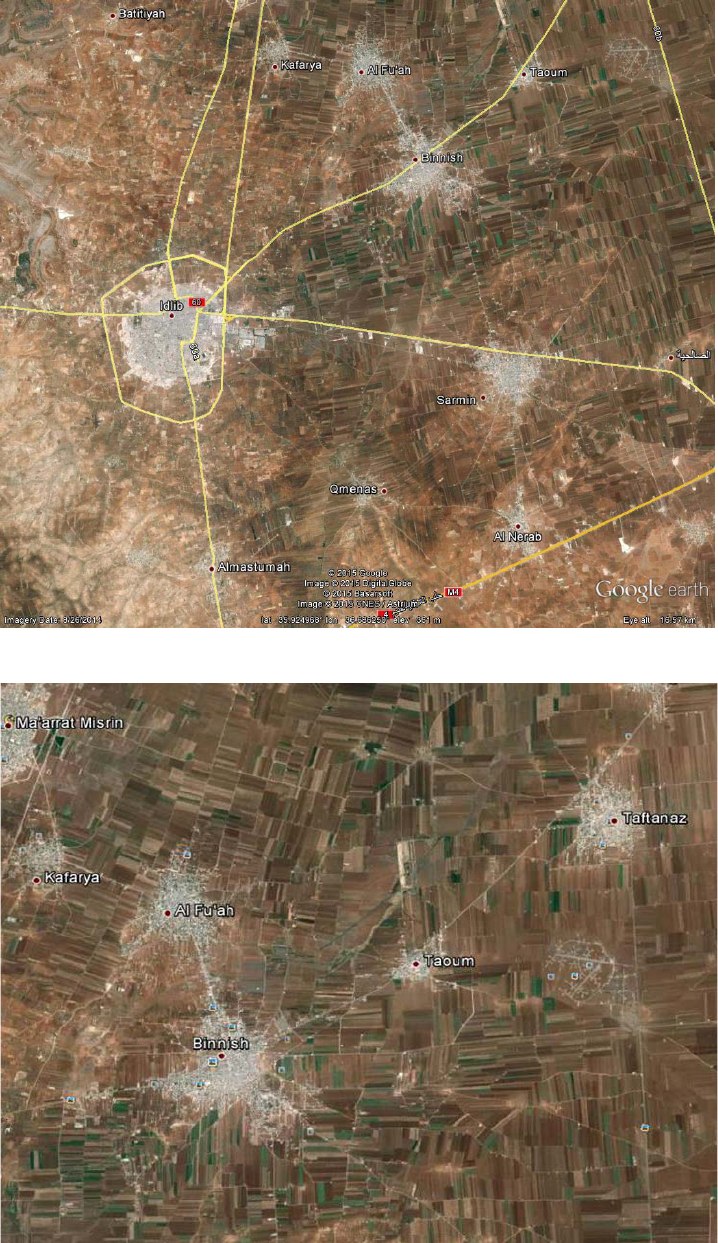
S/1319/2015
Annex 2
page 19
FIGURE 1: IDLIB CITY AND THE AREA TO THE EAST
FIGURE 2: BINNISH AND THE AREA TO THE NORTH
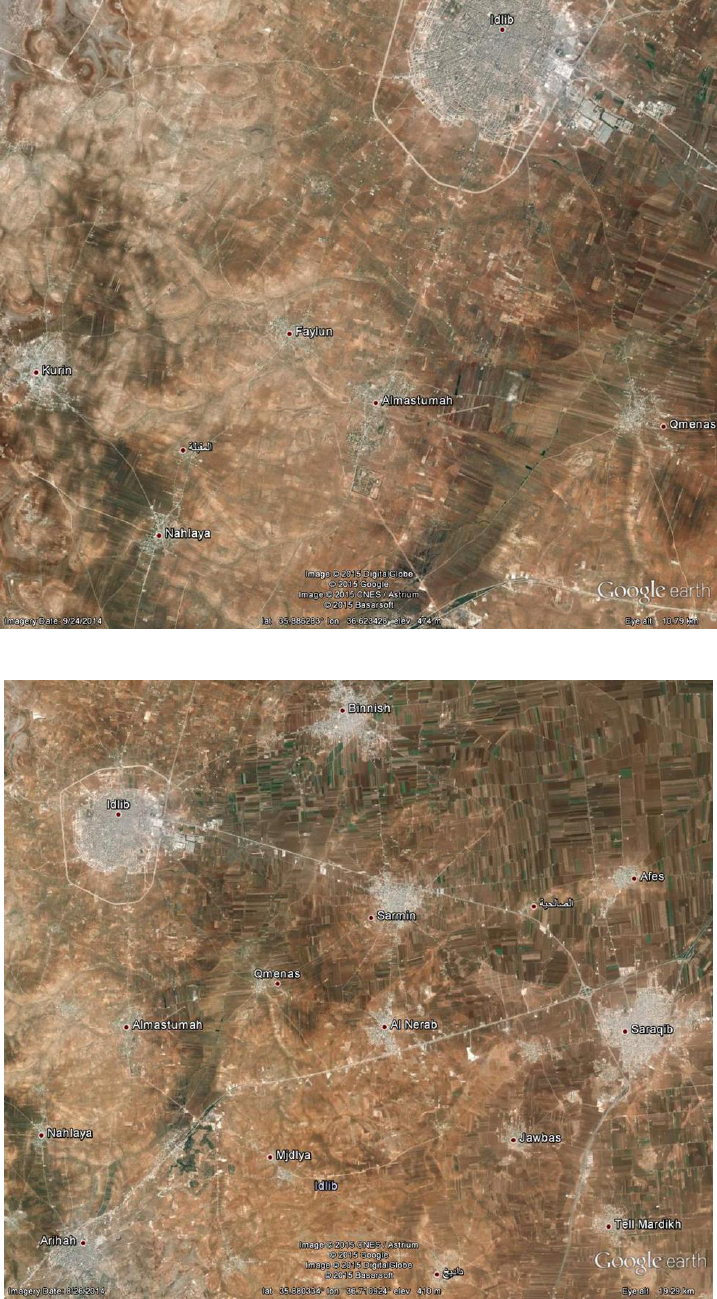
S/1319/2015
Annex 2
page 20
FIGURE 3: THE AREA TO THE SOUTH OF IDLIB CITY
FIGURE 4: IDLIB CITY AND SARAQIB
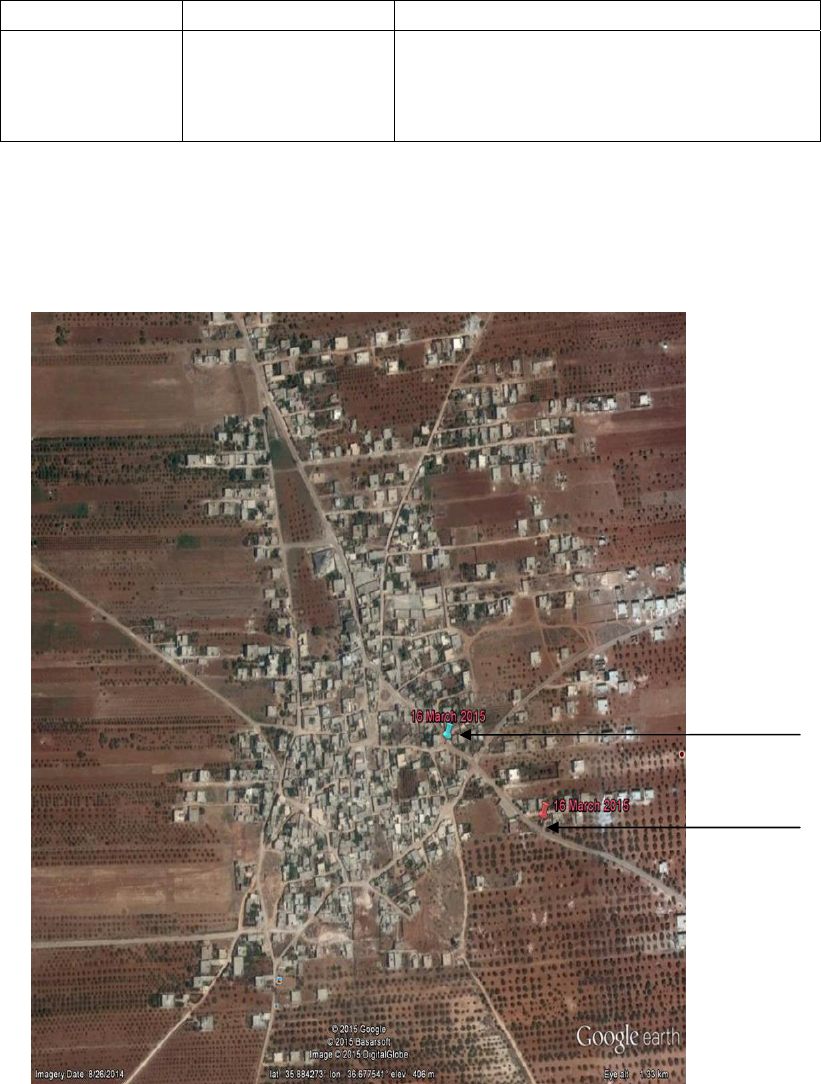
S/1319/2015
Annex 2
page 21
Qmenas
3.4 Qmenas is a village in the Idlib Governorate of the Syrian Arab Republic.
3.5 Between 3 May and 5 June 2015, the FFM interviewed 17 individuals including
treating physicians, nurses, first responders, casualties, and witnesses who provided
accounts and information regarding the alleged incident of 16 March 2015.
TABLE 1: INFORMATION ON REPORTED INCIDENTS IN QMENAS
Date Approximate time Weather conditions
16 March 2015 20:30 – 21:00 Temperatures around 14°C with 48% to
51% humidity. The wind direction was
SW WSW at 3 to 4 metres per second
(m/s).
3.6 Figure 5 below shows the approximate alleged impact points of the devices, as
derived from interviewees.
FIGURE 5: QMENAS AND THE SURROUNDING AREA
Impact point, 16 March 2015, Qmenas
Impact point, 16 March 2015, Qmenas
S/1319/2015
Annex 2
page 22
Narratives
3.7 Qmenas was not under the control of the Government in March 2015 and the front
line was at around 2 km from the village outskirts. Prior to conflict in this area, the
population of the village was approximately 2,000 people.
3.8 Interviewees claimed that on the night of 16 March 2015 between 20:00 and 21:00,
a helicopter had been passing above Qmenas. The helicopter was flying east out of
Qmenas and dropped two items in and very close to the edge of a military zone.
3.9 According to one of the witnesses interviewed by the FFM team, both items (“barrel
bombs”) hit the ground inside the military zone; one of the items was very close to a
residential area. The witnesses from Qmenas described the sound of the explosion as
muted compared to the sound of conventional weapons. It was assumed by witnesses
that the bomb failed to explode. A few minutes later, the occupants of the houses
situated in the eastern and north-eastern part of the village, relatively close to the
impact point, smelled an odour similar to chlorine-based household cleaning agents,
but much more intense. Some witnesses mentioned specific brand names of cleaning
agents and some specifically mentioned chlorine, which may be the chemical chlorine
or may be the trade name of a chlorine-based household cleaning agent. The residents
of the area who were exposed to the alleged gas began tearing and coughing and had
difficulty breathing. Shortly thereafter, as there was no mobile telephone coverage in
this village at the time, the population was informed through other early-warning
methods, including the use of hand-held radios and the loudspeakers on the mosques’
minarets. The announcements, for example, stated “careful a chemical attack on
Qmenas”. The witnesses described a scene of panic in the village after the
announcement of the message.
3.10 Approximately 60 exposed persons were transported by volunteers, who used their
personal cars or vans, from Qmenas to the Sarmin field hospital. Two ambulances
were sent from the Saraqib SCD unit to Qmenas, but they reached the village after the
evacuation of exposed persons was complete.
3.11 All persons transferred from Qmenas to Sarmin field hospital as exposed cases were
decontaminated by flushing with water near the entrance of the hospital. One of the
treating physicians was in charge of prioritising the cases (triage) and sending them to
the appropriate channel for treatment.
3.12 From the 60 or so individuals who arrived from Qmenas to the Sarmin field hospital
on 16 March 2015, 40 cases had clinical signs of anxiety, six cases were considered as
secondary exposure (one treating physician and five first responders), and 14 patients
were considered as directly exposed.
3.13 The roughly 60 individuals who were transported to the Sarmin field hospital were all
civilians. The FFM team asked if any military personnel had also been treated. One
interviewee confirmed that some, without giving a number, had been exposed to the
alleged chemical(s). He also indicated that those cases had been treated in their
military unit.
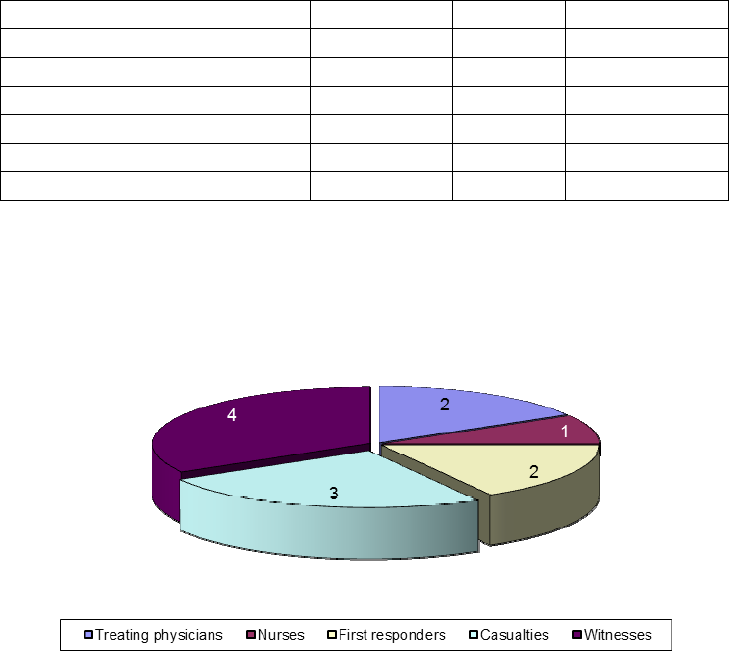
S/1319/2015
Annex 2
page 23
3.14 Most of the witnesses from Qmenas who were interviewed by the FFM team and had
visited the alleged incident location reported seeing one item only; two witnesses
confirmed seeing a second item, from a distance due to the restriction of access
(military area). Witnesses described seeing:
(a) a metallic cylinder or barrel/drum;
(b) a number of exploded refrigerant gas cylinders, the inner side of which were
yellowish and the outer side of which were green;
(c) soil that had changed colour to reddish pink; and
(d) plastic bottles.
Epidemiological analysis
3.15 Between 3 May and 5 June 2015, the FFM interviewed and collected the testimonies
of 17 individuals including treating physicians, nurses, first responders, casualties,
and witnesses, including 12 who provided epidemiological evidence. The details of
those 12 interviewees are given in table below:
TABLE 2: RELATION TO THE INCIDENT IN QMENAS AND GENDER
DISTRIBUTION OF INTERVIEWEES
Interviewee Male Female
Treating physicians 2 2
Nurses 1 1
First responders 2 2
Exposed persons 3 2 1
Witnesses 4 4
Total 12 11 1
FIGURE 6: DISTRIBUTION OF INTERVIEWEES IN RELATION TO THE
INCIDENT IN QMENAS

S/1319/2015
Annex 2
page 24
3.16 The village of Qmenas has no field hospital; for emergencies the population uses the
nearest hospital, which is located in Sarmin. Qmenas was allegedly attacked with a
suspected chemical or chemicals on 16 March 2015. The individuals who were
interviewed described this attack as indicated above.
3.17 The Sarmin field hospital received approximately 60 patients on 16 March 2015.
The decontamination of patients was performed in all cases, including washing of the
exposed area of skin. This decontamination was performed outside of the emergency
room. The clinical examination, signs, and symptoms, as observed by the treating
physician included coughing, difficulty of breathing, and tearing.
TABLE 3: SIGNS AND SYMPTOMS IN QMENAS, 16 MARCH 2015
Symptom Number of cases (approximately)
Coughing 20
Difficulty of breathing 20
Tearing 5
Feeling of panic 40
Total cases 60
FIGURE 7: SIGNS AND SYMPTOMS IN QMENAS, 16 MARCH 2015
3.18 Forty patients were considered as mild cases and 20 as moderate. None of the
affected individuals in the described attack had any signs of physical trauma on their
bodies, but only suffered from the effects of the suspected toxic chemical(s).
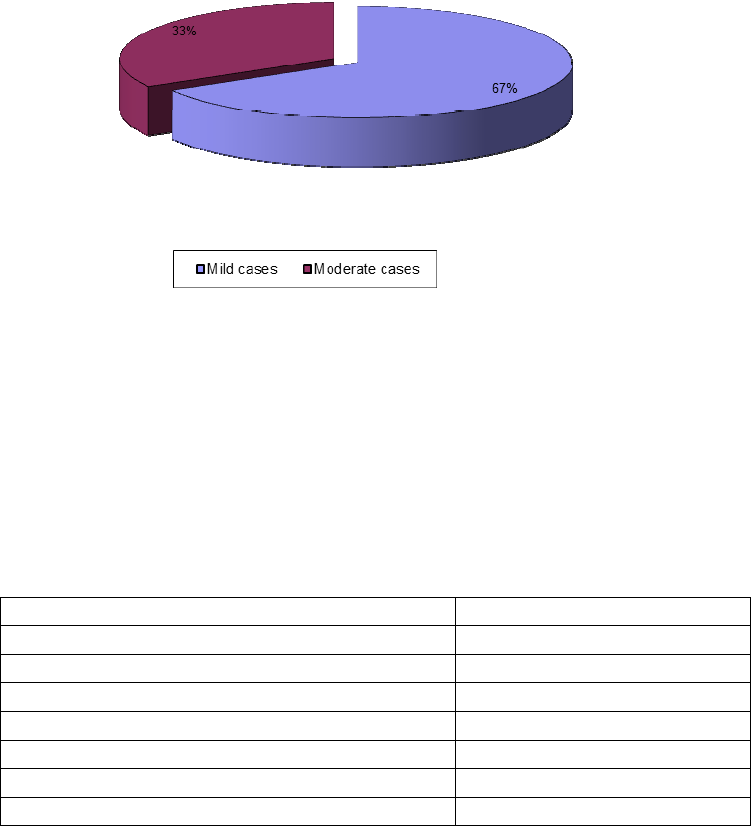
S/1319/2015
Annex 2
page 25
FIGURE 8: SEVERITY OF CASES IN QMENAS, 16 MARCH 2015
3.19 The mild cases responded well to the administration of oxygen. Those with moderate
symptoms also benefitted from nebulisation with the bronchodilator salbutamol and
the intravenous steroids hydrocortisone or dexamethasone. No severe cases were
reported.
3.20 No laboratory examinations and no X-rays needed to be requested for these cases.
All of these individuals were discharged from the hospital after a maximum of one
hour.
TABLE 4: TREATMENT OF CASES IN QMENAS, 16 MARCH 2015
Decontamination 60
Oxygen 60
Bronchodilator nebuliser 20
Inhaler steroids 0
Intravenous steroids 20
Lidocaine nebuliser 0
Lab analysis 0
X-ray 0
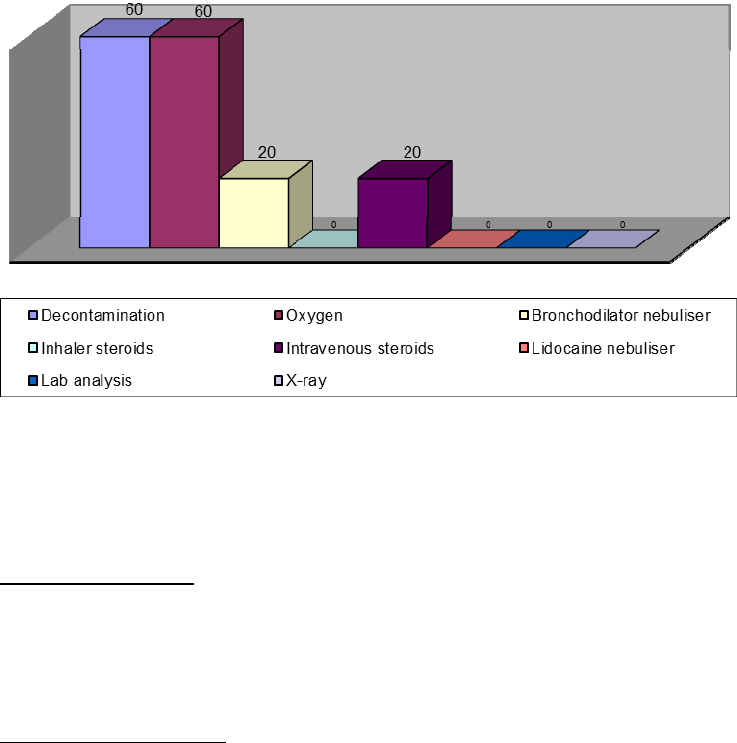
S/1319/2015
Annex 2
page 26
FIGURE 9: TREATMENT OF CASES IN QMENAS, 16 MARCH 2015
3.21 The hospital staff registered the names of patients. The FFM requested copies of the
patient registration book and medical files, but was not provided with these
documents.
Biomedical samples
3.22 No biomedical samples were taken from the patients involved in the alleged incident
in Qmenas on 16 March 2015, neither by the FFM team nor by the medical staff at the
Sarmin field hospital.
Environmental samples
3.23 No environmental sample was collected or received by the FFM team related to the
alleged incident in Qmenas on 16 March 2015.
Sarmin
3.24 The village of Sarmin is one of the villages of the Idlib Governorate of the Syrian
Arab Republic.
3.25 Between 3 May and 5 June 2015 the FFM team interviewed 21 individuals who
provided accounts and information regarding incidents of alleged use of toxic
chemicals as a weapon in and close to this village on 16 March, 23 March, and
26 March 2015, and 16 May 2015. The interviewees were treating physicians, nurses,
first responders, casualties, and witnesses.
3.26 The description of all of the allegations was similar and indicated that the incident
happened during the night. Although the people said they were unable to see the
helicopters, they heard the sound. The witnesses described the sound of impact as
muted compared to the explosive sound previously encountered with the impact of
explosive devices and weapons. In the first incidents, it was commonly assumed that

S/1319/2015
Annex 2
page 27
the bomb had failed to explode. This was followed minutes later by warnings on
hand-held radios about impact points and the release of chemicals. Some people who
lived close to the impact points and who were exposed described smelling the typical
odour of chlorine immediately after the impact and tried to escape. They described
the smell as irritating, similar to chlorine used as a household cleaning agent but much
more intense. The interviewees informed the FFM team that over a period of time
since the beginning of the crisis they had been educated by local emergency response
committees on what to do in case of an attack involving toxic chemicals. People were
advised to escape upwind of the point of impact and to higher elevations.
TABLE 5: CHRONOLOGY AND ASSOCIATED WEATHER CONDITIONS
IN RELATION TO INCIDENTS IN SARMIN
Incident Date
Approximate
time
Weather conditions
First 16 March 2015 22:30 – 23:00
Stable temperatures at 14 to 15°C
between 19:00 and midnight, with
48% to 51% humidity. The wind
direction was SW WSW at 3 to 4
m/s
Second 16 March 2015 22:30 – 23:00
Third 23 March 2015 01:00 – 03:00
Stable temperatures at 10°C
between midnight and 7:00, with
62% to 67% humidity. The wind
direction was variable,
predominantly W to WNW at 6 to 7
m/s
Fourth 26 March 2015 22:00 – 23:00
Temperature was dropping down
from 16 to 12°C between 19:00 and
midnight with increasing humidity
from 68% to 94% for the same
period of time. The wind direction
was variable, predominantly NE at
1 to 3 m/s
Fifth 16 May 2015 03:00 – 04:00
The temperature was stable at 18°C
from midnight to 6:00. The wind
direction was variable, with no
fixed direction and the velocity was
wavering between 2 and 6 m/s
3.27 Figure 10 below shows the approximate impact points of the devices, as derived from
interviewees.
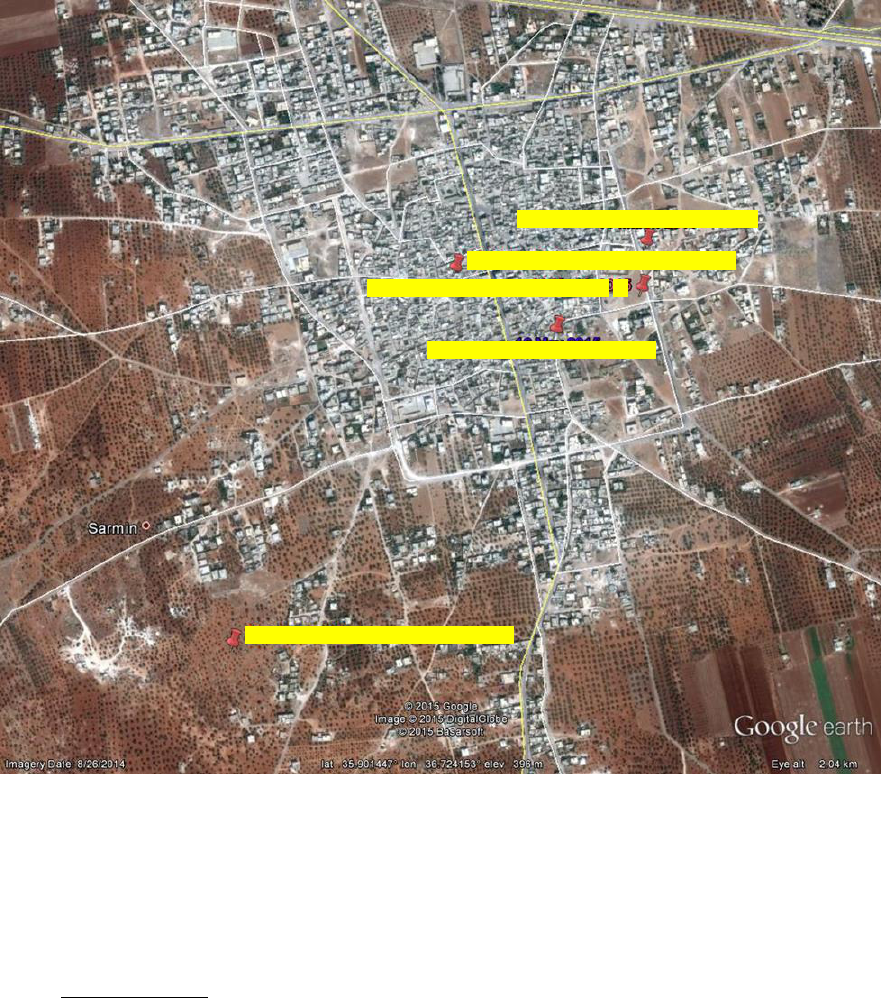
S/1319/2015
Annex 2
page 28
FIGURE 10: ALLEGED APPROXIMATE IMPACT POINTS IN SARMIN
Narratives
3.28 In March 2015, the village was under the control of opposition groups. The normal
population was estimated to be around 20,000 and less than 5,000 at the time of the
incident.
16 March 2015
3.29 Interviewees claimed that on the night of 16 March 2015 between 22:30 and 23:00
a helicopter was heard passing above Sarmin, flying from west-south-west to
east-north-east, and that helicopter dropped the first item. A few minutes later the
same helicopter dropped a second item nearby in the same eastern neighbourhood of
Sarmin.
3.30 The interviewees affirmed that they had heard the sound of the falling items from the
helicopter “sound similar to a diving fighter jet” followed by a soft explosion, “not a
strong explosion sound”. Initially, they had assumed that the item failed to explode.
A few minutes later, a message was conveyed to the residents of Sarmin that they
Impact point, 23 March 2015, Sarmin
Impact point, 26 March 2015, Sarmin
Impact point, 16 March 2015, Sarmin
Impact point, 16 March 2015, Sarmin
I
m
pact point, 16 May 2015, Sarmin
S/1319/2015
Annex 2
page 29
were chemical items. The message had been broadcast through the local walkie-talkie
network and the loudspeakers on the minarets of the mosques.
3.31 Some interviewees who lived close to the impact points and who were exposed
described smelling the typical odour of chlorine immediately after the explosion of
the first item.
3.32 A number of SCD members responded to the request for help from the population on
the basis of receiving information through the local communication system, and also
responded to incidents on their own initiative as part of their voluntary role. The SCD
members interviewed by the FFM team indicated that an odour similar to chorine
could be smelled a hundred metres away from the impact point.
3.33 Alleged casualties were evacuated to two hospitals, the Sarmin field hospital and the
Saraqib field hospital. Testimonies of the treating physicians indicated that a total of
42 patients were received in both field hospitals as directly exposed individuals.
These 42 cases were classified as moderate to severe. Sarmin field hospital treated 31
patients and 11 were received at the Saraqib field hospital. Among the 31 patients
treated at the Sarmin field hospital on the night of 16 March 2015, 14 patients had
been received from Qmenas. These 14 patients were those previously indicated as
having been directly exposed in the alleged incident that occurred in Qmenas on the
same evening (see paragraphs 3.8 and 3.9), approximately two hours before the
incident in Sarmin. One of the treating physicians claimed that the hospital had also
treated some 20 SCD members who had suffered secondary exposure and mild
symptoms.
3.34 The total number of fatalities related to these incidents in Sarmin was six people, all
of them members of one family (mother, father, their three children, and the
children’s grandmother). Three of those six had reached the hospital alive: the
mother, the father, and the oldest child. The remaining three family members (the
grandmother and the two daughters) were dead when they arrived at the field hospital
in Sarmin.
3.35 According to the interviewees’ statements, the six family members lived in the same
house at the time of the incident. The house had two separate levels underground and
had a rectangular vertical ventilation shaft with an approximate dimension of 3 m x
1.5 m. The ventilation shaft was open at ground level and descended through the two
floors, allowing the ventilation of the two underground floors. The interviewees
described that the chemical item fell through the ventilation shaft and exploded inside
the house. It was not totally clear where it had exploded, whether towards the top of
the shaft, the bottom, or in between. However, it was estimated to have exploded in
the second underground level (-2) where the family had been taking refuge.
Furthermore, at some point during the incident, there was an impact with a water tank.
The father, the mother, and the oldest (male) child managed to escape to the open air,
and were transported by the SCD to the hospital where they were decontaminated
with water and then received medical attention. The father informed the SCD
rescuers that the two daughters and grandmother were trapped in the second
underground level. The rescuers managed to extract the grandmother and the two
daughters 30 minutes later and also transferred them to the hospital. Delays in the

S/1319/2015
Annex 2
page 30
rescue were caused by the inability to access the basement due to the strong pungent
chemical smell. The interviewees confirmed that the grandmother and the two
daughters were dead on arrival at the hospital. The FFM team tried to clarify if those
three casualties were alive during the transport phase, or whether they had died at the
house. It was impossible to further clarify this issue.
3.36 Witnesses and first responders who were interviewed by the FFM team and had
visited the family house after the alleged incident reported observing the following:
(a) a strong smell of chlorine;
(b) a metallic cylinder with an approximate diameter of 1 m to 1.5 m; they
described it as “double the size of an oil barrel”;
(c) a number of exploded green refrigerant gas cylinders; and
(d) the presence of a red/purple liquid on the floor and part of the walls.
23 March 2015
3.37 Interviewees claimed that on 23 March 2015, during the early morning hours between
1:00 and 3:00, a helicopter had been heard passing above Sarmin and that the
helicopter dropped one item. The interviewees stated that they heard a whistling
sound coming from the falling item, followed by a weak explosion sound.
3.38 A few minutes later, a man conveyed a message, through the local walkie-talkies, that
“he has smelled toxic substances in the air” in the south-west of Sarmin. Based on
that message, the local emergency system broadcasted an order of evacuation to the
residents of that part of the village. Some witness affirmed that they smelled chlorine
3 to 4 km away in Al-Nerab (to the south) and in part of the Qmenas neighbourhood.
3.39 The medical specialist interviewed by the FFM team affirmed that the number of
exposed persons was five, all suffering from mild symptoms.
3.40 Witnesses interviewed by the FFM team and who had visited the location of the
alleged impact site reported observing the following:
(a) a metallic cylinder;
(b) a number of exploded green refrigerant gas cylinders;
(c) plastic bottles;
(d) soil that had changed colour to reddish pink; and
(e) leaves on the trees that had turned yellow.
26 March 2015
3.41 Interviewees claimed that on 26 March 2015 in the early morning hours between 1:45
and 2:30, a helicopter was heard passing above Sarmin after broadcasts on radios

S/1319/2015
Annex 2
page 31
warned of the helicopter passing over Qmenas eastward towards Sarmin. The
helicopter dropped one item. A few minutes later, a man radioed a message of a
“strong smell at 50 m from the market” in Sarmin.
3.42 The alleged item fell into an uninhabited house at approximately 100 m west of one of
the main streets of Sarmin, “Market Street”.
3.43 The medical specialist interviewed by the FFM team affirmed that the number of
exposed persons was six, all suffering from mild symptoms.
16 May 2015
3.44 Interviewees claimed that in the early morning hours of 16 May 2015 around 2:00, a
helicopter was heard passing above Sarmin. The helicopter dropped one item which
fell into the entrance of a residence set in an underground cave.
3.45 The medical specialist interviewed by the FFM team mentioned four exposed persons
(one male, one female, and two children), three of whom had mild symptoms, and one
(the male) whose case was considered as moderate.
3.46 Witnesses who were interviewed by the FFM team and had visited the alleged
incident location reported observing the following:
(a) the metallic outer casing of a cylinder; and
(b) changed colour on the walls, described as the “walls looked burned”.
Epidemiological analysis
3.47 Sarmin has one field hospital, which is located in one of the buildings in the city and
is intended specifically for the medical needs of this village, including the treatment
of traumatic war injuries. There is also one private clinic and one primary health
centre, the latter being dedicated exclusively for vaccinations. The field hospital is
staffed by two doctors specialising in the fields of radiology and psychiatry, in
addition to a resident specialising in pneumology. The medical doctor of the private
clinic, who is an anaesthetist, supports the team if needed (as was the case for the
several incidents), as well as 25 other staff from the field hospital, most of them field-
trained nurses.
3.48 The hospital staff members do not have formal training in the management of injuries
resulting from chemical incidents. The structure of the hospital has been augmented
continuously since its establishment. The resources available at the hospital include a
radiology department, one operation theatre, an emergency room with a total of eight
inpatient beds, and some oxygen cylinders and nebulisers. All individuals who present
to this field hospital for routine illnesses and war injuries are registered, and all
medical records are maintained.
3.49 It was reported that Sarmin was attacked with suspected toxic chemicals on several
occasions.
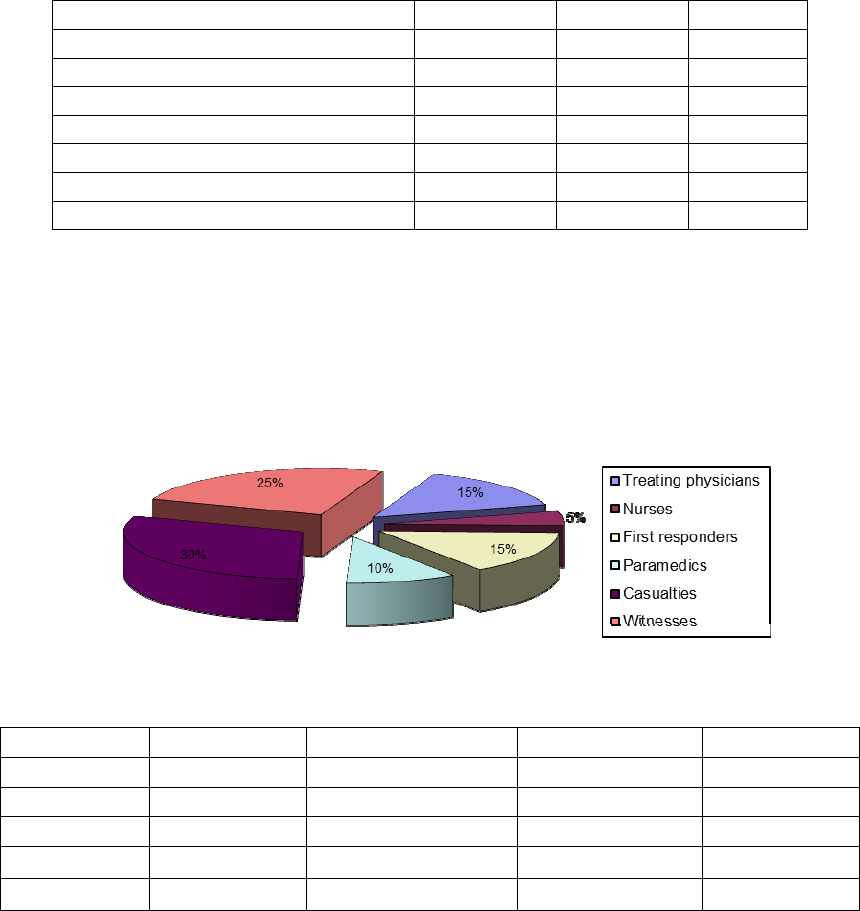
S/1319/2015
Annex 2
page 32
3.50 The FFM interviewed and collected the testimonies of 21 individuals including
treating physicians, nurses, first responders, exposed persons, and witnesses who
provided accounts and information regarding incidents of alleged use of toxic
chemicals as a weapon. Of these 21 individuals, 20 provided epidemiological
evidence. The details of these interviewees are given in Table 6 below.
TABLE 6: RELATION TO THE INCIDENT IN SARMIN AND GENDER
DISTRIBUTION OF INTERVIEWEES
Interviewee Male Female
Treating physicians 3 3
Nurses 1 1
First responders 3 3
Paramedics 2 2
Casualty 6 5 1
Witnesses 5 5
Total 20 19 1
FIGURE 11: DISTRIBUTION OF INTERVIEWEES IN RELATION TO THE
INCIDENT IN SARMIN, 16 MARCH 2015
TABLE 7: CHRONOLOGY OF INCIDENTS IN SARMIN
Incident Date Approximate time No. of patients Deaths
First 16 March 22:30 – 23:00 26 0
Second 16 March 22:30 – 23:00 6 6
Third 23 March Late at night 5 0
Fourth 26 March 22:00 – 23:00 6 0
Fifth 16 May 15:30 – 16:00 4 0
3.51 Witnesses who were close to the impact points and who were exposed described
smelling the typical odour of chlorine immediately after the impact and tried to
escape. They described the smell as irritating, similar to chlorine used as a household
cleaning agent but much more intense.

S/1319/2015
Annex 2
page 33
3.52 This odour immediately induced coughing and a feeling of suffocation among all who
were exposed. Some of the first responders who managed the exposed persons were
also cross-contaminated from the casualties and suffered symptoms of exposure.
3.53 The FFM was informed that after the chemical incidents were reported, ambulances
attached to Sarmin field hospital were dispatched to rescue those who had been
exposed.
3.54 Simultaneously, volunteers from the neighbourhood used their private vehicles to
evacuate people to the Sarmin field hospital. During the incidents of 16 March 2015,
because of the load and the previous incident in Qmenas village, some of the patients
were evacuated to both the Sarmin and Saraqib field hospitals.
3.55 From the testimonies collected, the FFM found that the predominant symptoms
among those who were exposed were coughing and shortness of breath. Only a few
of the exposed persons reported a burning sensation on exposed skin and a mild
burning sensation/tearing of the eyes.
3.56 The clinical examination, signs, and symptoms as observed included coughing,
difficulty breathing, and tearing.
TABLE 8: SUMMARY OF THE SIGNS AND SYMPTOMS REPORTED BY
THE TREATING PHYSICIANS
Symptom 16 March 16 March 23 March 26 March 16 May
Sarmin Saraqib
Coughing 29 11 2 5 6 4
Difficulty
breathing
29 11 2 5 6 4
Tearing, burning
sensation in eyes
5 0 0 0 0 1
Nausea/vomiting 3 0 0 0 0 0
Disorientation 0 0 3 0 0 0
Loss of
consciousness
0 0 3 0 0 0
Burning sensation
on exposed
skin/nose
3 0 0 0 0 0
Frothy secretions
from mouth
0 0 1 0 0 0
Feeling of panic 20 0 0 0 0 0
Headache 2 0 0 0 0 0
Physical injuries 0 0 0 0 0 0
Death 0 0
6
0 0 0
Total cases 29 11 6 5 6 4

S/1319/2015
Annex 2
page 34
FIGURE 12: SIGNS AND SYMPTOMS RELATING TO THE FIRST INCIDENT
IN SARMIN, 16 MARCH 2015
40
40
5
3
0
0
3
0
20
2
0
Coughing
Difficulty breathing
Tearing, burning sensation in eyes
Nausea/vomiting
Disorientation
Loss of consciousness
Burning sensation on exposed
skin/nose
Frothy secretions from mouth
Feeling of panic
Headache
Physical injuries
3.57 On arrival at both hospitals, most patients were decontaminated by washing the
exposed area(s) of skin with water. Some interviewees reported a chlorine-like odour
emanating from the casualties as well as a red/pink colouration of the rinse water.
3.58 One of the treating physicians informed the FFM that a large number of individuals
who sought medical aid had no adverse clinical signs other than anxiety. Because
they were in a state of panic, the first aid provided was mostly decontamination,
moving to fresh air, oxygen therapy, and giving reassurance. The treatment provided
to those who were exhibiting clinical signs included the administration of oxygen,
nebulisation with the bronchodilator salbutamol, and the intravenous steroids
hydrocortisone and dexamethasone, along with intravenous fluids. The treatment
provided was effective and the patients’ medical status improved quickly.
3.59 The FFM was informed that the ambulance drivers and first responders who had
participated in the rescue and evacuation of people to the hospital were also affected,
some of them requiring the administration of oxygen.
3.60 Twenty patients were considered as mild cases, four as moderate, three as severe, and
three arrived to the hospital dead. None of the affected individuals in the described
attack had any signs of physical trauma on their bodies, but only suffered from the
effects of the suspected toxic chemical.
3.61 The mild cases responded well to the administration of oxygen. Those with moderate
symptoms also benefitted from nebulisation with the bronchodilator salbutamol and
the intravenous steroids hydrocortisone or dexamethasone. For the severe cases,
because the initial response to treatment was poor, treating physicians attempted
intubation.
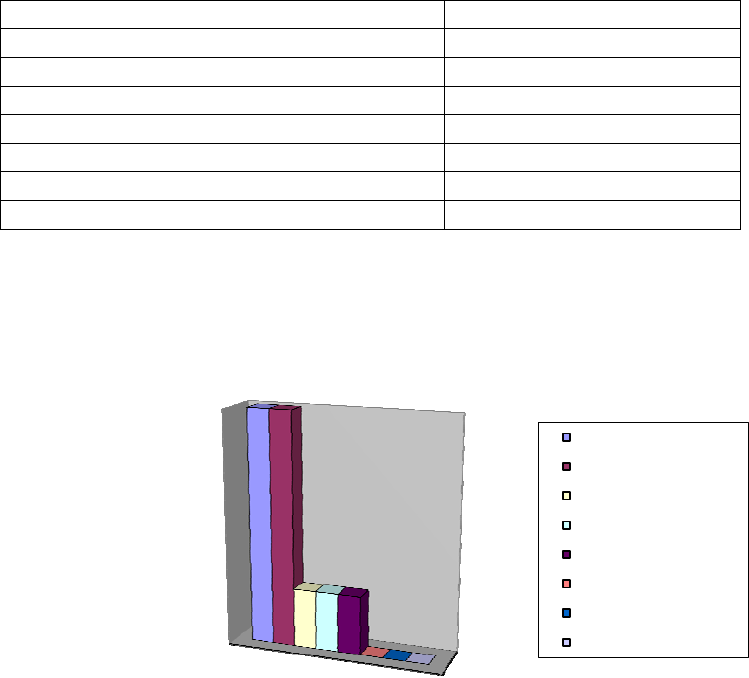
S/1319/2015
Annex 2
page 35
3.62 Neither a lab exam nor an X-ray was requested by the treating physicians for any of
the cases.
3.63 In total, six severe cases did not survive the exposure. All of the other cases were
discharged from the hospital after a maximum of three hours.
TABLE 9: TABLE OF TREATMENT OF CASUALTIES IN SARMIN,
16 MARCH 2015
Decontamination 29 + 11
Oxygen 29 + 11
Bronchodilator nebuliser 10
Inhaler steroids 10
Intravenous steroids 10
Lidocaine nebuliser 0
Lab analysis 0
X-ray 0
FIGURE 13: MANAGEMENT OF CASES IN SARMIN, 16 MARCH 2015
40
40
10 10
10
0
0
0
Decontamination
Oxygen
Bronchodilator nebuliser
Inhaler steroids
Intravenous steroids
Lidocaine nebuliser
Lab analysis
X-ray
3.64 The hospital staff registered the names of the patients. The FFM requested copies of
the patient registration book or medical files, but was not provided with them.
3.65 However, a number of videos of incidents recorded on different dates by the
interviewees themselves were provided to the FFM. These videos show people
suffering, and being decontaminated and treated. The interviewed treating physicians
and other interviewees can be seen in these videos.
3.66 The FFM teams asked the interviewees who had been exposed about their current
medical status. None of the interviewees had any remaining symptoms from the time
of exposure, and all were in good physical health at the time of the interviews.

S/1319/2015
Annex 2
page 36
Biomedical samples
3.67 For all of the alleged incidents that occurred in Sarmin as reported above, only two
biomedical samples were taken on 16 March 2015.
3.68 One health worker, who was in Sarmin hospital on 16 March 2015, informed the FFM
team that biomedical samples had been taken from the victims by a treating physician.
The samples were blood and hair taken from one of the dead casualties, and were
sent elsewhere for analysis. The FFM team was given access neither to the analysis
results nor to the samples to conduct their own analysis.
Environmental samples
3.69 Samples, which included environmental samples and remnants of devices, were
received by the FFM team on two different dates. The first group of samples was
received by the team on 22 May 2015; the second group on 23 July 2015. According
to the interviewees’ statements, the samples were originally collected by the
interviewees and were held in a different location within Sarmin.
3.70 Some samples were accompanied by partial documentation of the chain of custody
prior to delivery to the FFM. Although this documentation provided some degree of
confidence-building, the entire chain of custody could not be verified and, therefore,
the possibility of cross-contamination could not be ruled out. Accordingly, as already
explained in Section 2 above, the FFM regarded the samples as tertiary evidence.
3.71 A total of 17 samples were delivered to the FFM team. Six samples (05SDS, 07SDS,
08SDS, 09SDS, 11SDS, and 12SDS) were collected by the witnesses in relation to
different alleged incidents. Eleven samples (13SDS, 14SDS, 15SDS, 16SDS, 17SDS,
18SDS, 19SDS, 20SLS, 21SDS, 22SDS, and 23SDS) were collected from the house
of the deceased victims of the alleged incident of 16 March 2015.
3.72 Sample 24SLS was actually two subsamples of soil from Sarmin. The FFM team
requested that these be taken one day prior the delivery date and that they should be
collected at a distance of 100 m and 200 m, respectively, from the impact point of the
first incident of 16 March 2015. Those two samples were a background reference for
the team.

S/1319/2015
Annex 2
page 37
TABLE 10: ENVIRONMENTAL SAMPLES ANALYSIS RESULTS
Date of receipt;
OPCW evidence
reference
number; and
sample code
Sample description Sample preparation Technique Result
22/05/2015
20150522102805
05SDS
Empty HCFC container
Extraction of 1.4 g of debris
from outside surface of
container with 2 mL
dichloromethane-d2
GC-EI-MS/dFPD - High conc. of Trinitrotoluene (TNT)
- Oxidation products of butylated
hydroxytoluene (BHT)
- Polycyclic aromatic hydrocarbons (PAHs)
Extraction of inside surface of
container with 10 mL n-hexane
GC-EI-MS/dFPD - Trinitrotoluene (TNT)
- Oxidation products of butylated
hydroxytoluene (BHT)
- Polychlorinated aromatic hydrocarbons
(PCAHs)
Extraction of inside surface of
container with 10 mL deuterium
oxide
ICP-MS
ICP-OES
IC
- Fe [mg/L extract]: 1260 (ICP-OES)
- Zn [mg/L extract]: 380 (ICP-OES)
- K [mg/L extract]: 60 (ICP-MS)
- Mn [mg/L extract]: 50 (ICP-MS)
- Bromide [mg/L extract]: 3 (IC)
- Chloride [mg/L extract]: 3700 (IC)
Extraction of 160 mg of debris
from outside surface of
container with 20 mL water
ICP-MS
ICP-OES
IC
- K [mg/kg debris]: 14200 (ICP-MS)
- Mn [mg/kg debris]: 2 (ICP-MS)
- Bromide [mg/kg debris]: 40 (IC)
- Chloride [mg/kg debris]: 25100 (IC)
22/05/2015
20150522102807
07SDS
Black brown plastic
container
Cutting piece of plastic
container and cleaning of
surface
FTIR spectroscopy and
Differential Scanning
Calorimetry (DSC)
Polymer identified as PET (Polyethylene
terephthalate)
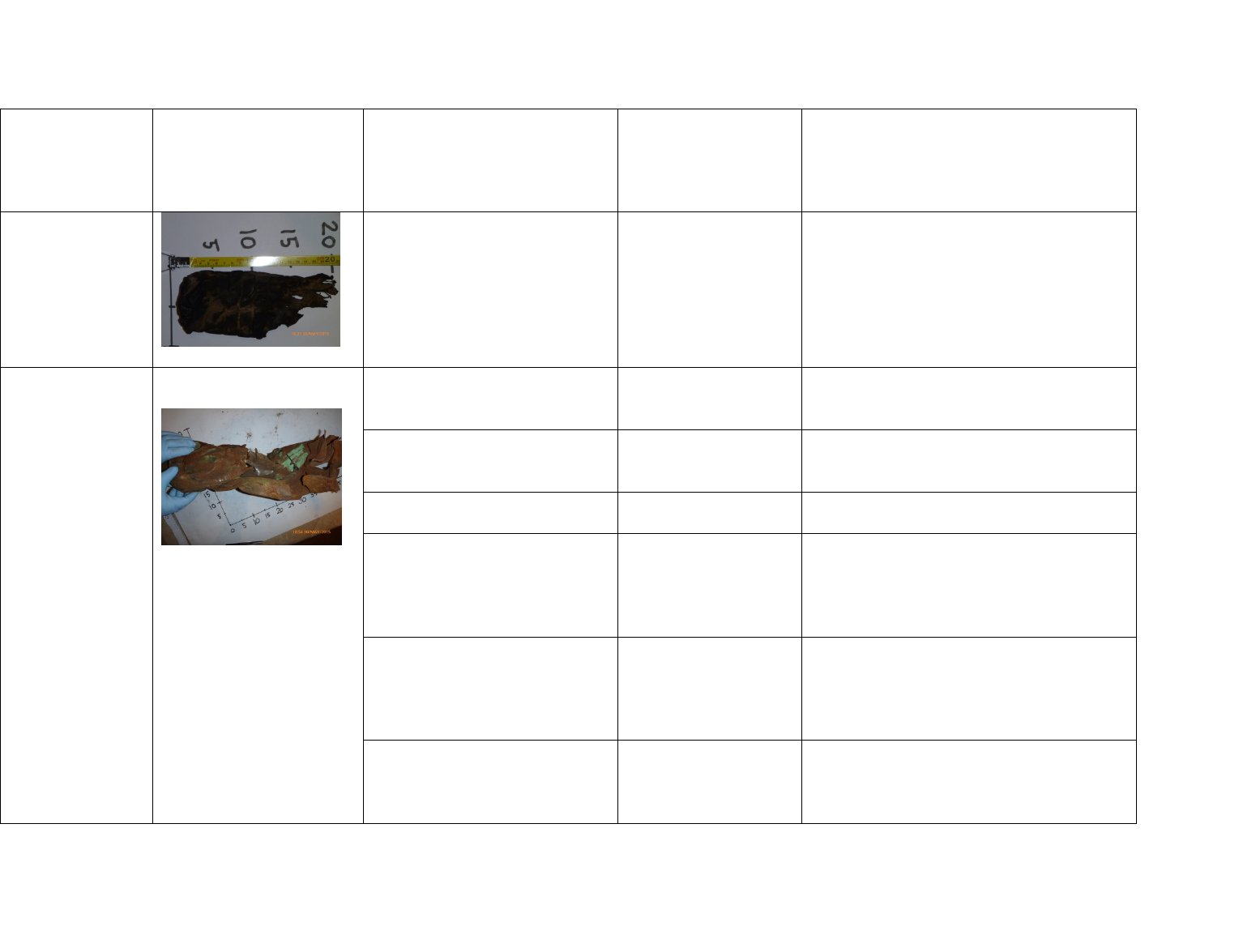
S/1319/2015
Annex 2
page 38
Date of receipt;
OPCW evidence
reference
number; and
sample code
Sample description Sample preparation Technique Result
22/05/2015
20150522102808
08SDS
Ruptured HCFC + plastic
containers
None XRF spectroscopy on
outside surface of CFC
container
- K [%]: 0.3
- Mn [%]: 1.3
- Cl [%]: 1.0
None XRF spectroscopy on
inside surface of
HCFC container
- K [%]: 0.2
- Mn [%]: 0.9
- Cl [%]: 1.0
Sanding off debris on the metal
surface of HCFC container
XRF spectroscopy on
cleaned metal surface
- Fe [%]: > 99
Extraction of 100 mg debris
from outside surface of HCFC
container with 2 mL
dichloromethane-d2
GC-EI-MS/dFPD - High conc. of Trinitrotoluene (TNT)
- Oxidation products of butylated
hydroxytoluene (BHT)
- PAHs
- PCAHs
Extraction of 100 mg debris
from inside surface of HCFC
container with 2 mL
dichloromethane-d2
GC-EI-MS/dFPD - Trinitrotoluene (TNT)
- Oxidation products of butylated
hydroxytoluene (BHT)
- PAHs
- PCAHs
Extraction of 100 mg debris
from rust-coloured area on
outside surface of HCFC
container with 20 mL water
ICP-MS
IC
- K [mg/kg debris]: 2600 (ICP-MS)
- Mn [mg/kg debris]: <10 (ICP-MS)
- Bromide [mg/kg debris]: 500 (IC)
- Chloride [mg/kg debris]: 55000 (IC)
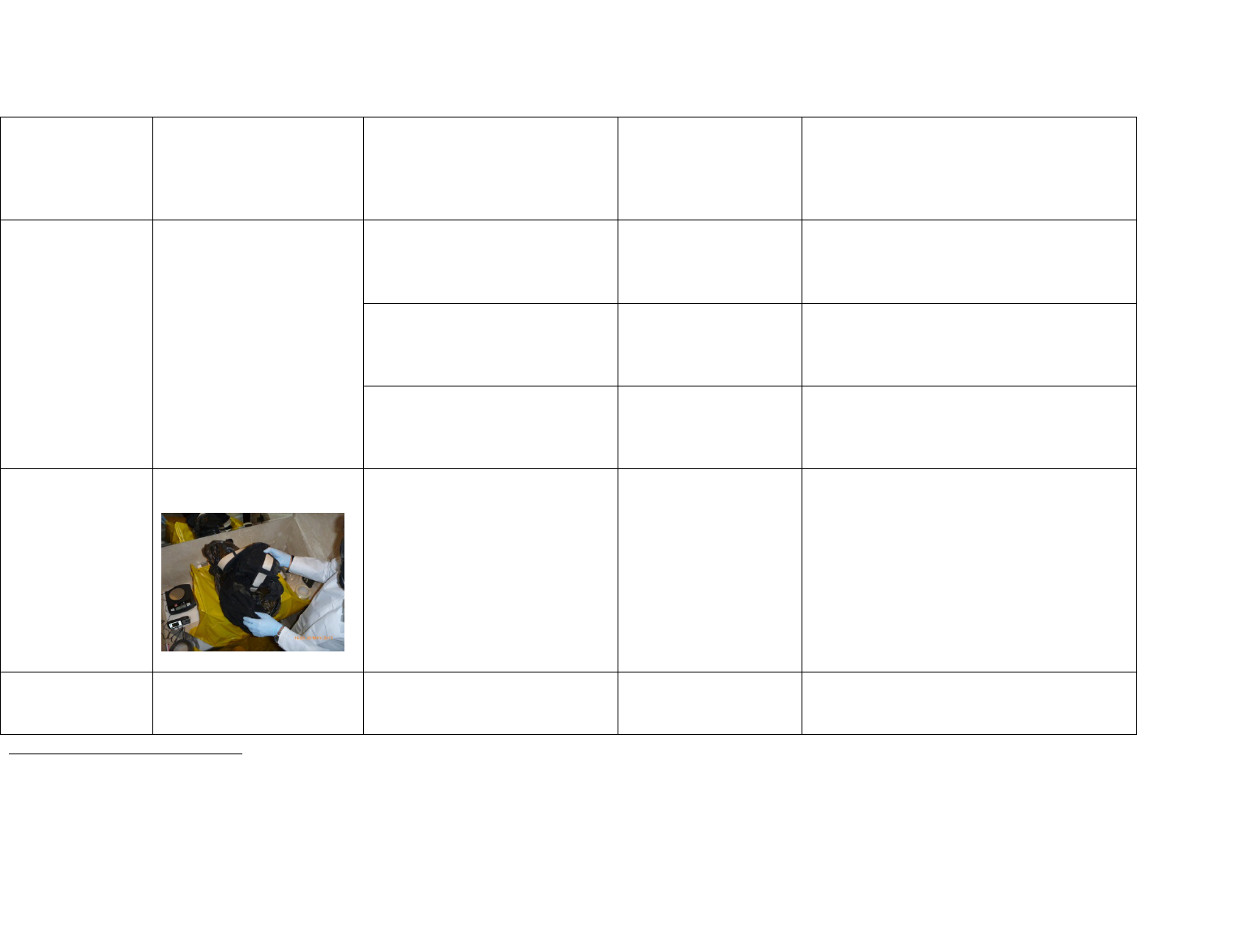
S/1319/2015
Annex 2
page 39
Date of receipt;
OPCW evidence
reference
number; and
sample code
Sample description Sample preparation Technique Result
Extraction of 100 mg debris
from inside surface (area 1) of
HCFC container with 20 mL
water
ICP-MS
IC
- K [mg/kg debris]: 4200 (ICP-MS)
- Mn [mg/kg debris]: 140 (ICP-MS)
- Bromide [mg/kg debris]: 20 (IC)
- Chloride [mg/kg debris]: 8800 (IC)
Extraction of 100mg debris from
inside surface (area 2) of HCFC
container with 20 mL water
ICP-MS
IC
- K [mg/kg debris]: 3200 (ICP-MS)
- Mn [mg/kg debris]: 170 (ICP-MS)
- Bromide [mg/kg debris]: 20 (IC)
- Chloride [mg/kg debris]: 9700 (IC)
Extraction of 70 mg debris from
area around hole on top of
outside surface of HCFC
container with 20mL water
ICP-MS
IC
- K [mg/kg debris]: 1400 (ICP-MS)
- Mn [mg/kg debris]: <10 (ICP-MS)
- Bromide [mg/kg debris]: <10 (IC)
- Chloride [mg/kg debris]: 3300 (IC)
22/05/2015
20150522102809
09SDS
Clothes from a victim
3
22/05/2015
20150522102811
Ruptured HCFC container None XRF spectroscopy on
outside surface
- K [%]: 0.3
- Mn [%]: 2.9
- Cl [%]: 7.8
3
The victim was not severely exposed to the chemical; therefore the laboratory was tasked with preserving this sample for a specific tracer if the
environmental samples results did not offer any specific chemical or degradation product.
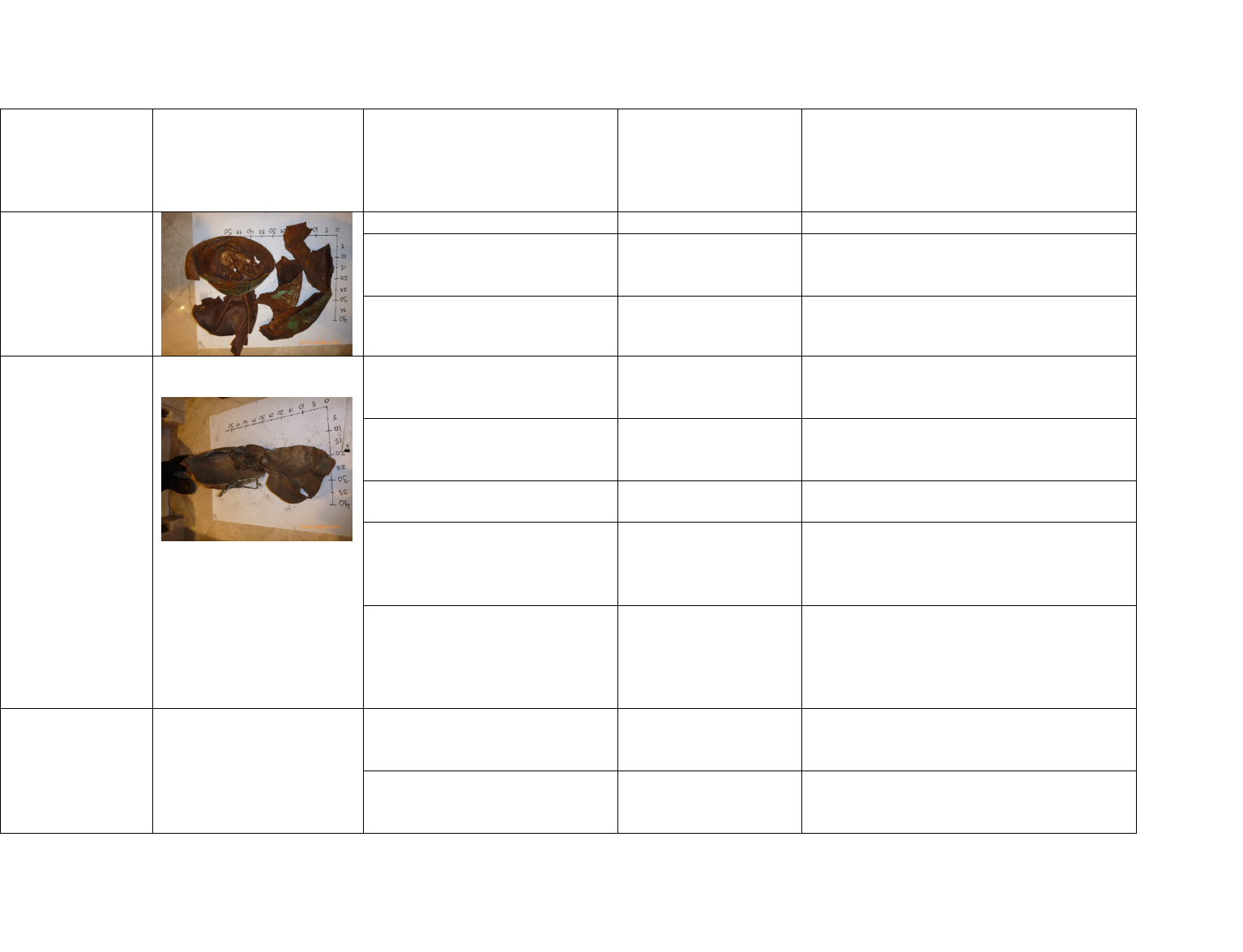
S/1319/2015
Annex 2
page 40
Date of receipt;
OPCW evidence
reference
number; and
sample code
Sample description Sample preparation Technique Result
11SDS - Ti [%]: 3.0
None XRF spectroscopy on
inside surface
- K [%]: 0.4
- Mn [%]: 0.6
- Cl [%]: 0.2
Sanding off debris on the metal
surface
XRF spectroscopy on
cleaned metal surface
- Fe [%]: > 99
22/05/2015
20150522102812
12SDS
Ruptured HCFC + plastic
containers
None XRF spectroscopy on
outside surface of
HCFC container
- K [%]: 1.4
- Mn [%]: 2.8
- Cl [%]: 4.6
None XRF spectroscopy on
inside surface of
HCFC container
- K [%]: 1.8
- Mn [%]: 1.4
- Cl [%]: 4.4
Sanding off debris on the metal
surface of HCFC container
XRF spectroscopy on
cleaned metal surface
- Fe [%]: > 99
Extraction of 200 mg of debris
from plastic container with 2 mL
dichloro-methane-d2
GC-EI-MS/dFPD - High conc. of Trinitrotoluene (TNT)
- Oxidation products of butylated
hydroxytoluene (BHT)
- PAHs
Extraction of 200 mg of debris
from HCFC container with 2 mL
dichloro-methane-d2
GC-EI-MS/dFPD - High conc. of Trinitrotoluene (TNT)
- Oxidation products of butylated
hydroxytoluene (BHT)
- PAHs
- PCAHs
23/07/2015
20150723100801
13SDS
Key None
XRF spectroscopy on
surface
- K [mg/kg]: < LOD
- Mn [mg/kg]: 3500
Extraction of 17.2 mg of
corrosion debris from key with
2mL dichloromethane-d2.
GC-EI-MS/dFPD
GC-AED
- Oxidation products of BHT
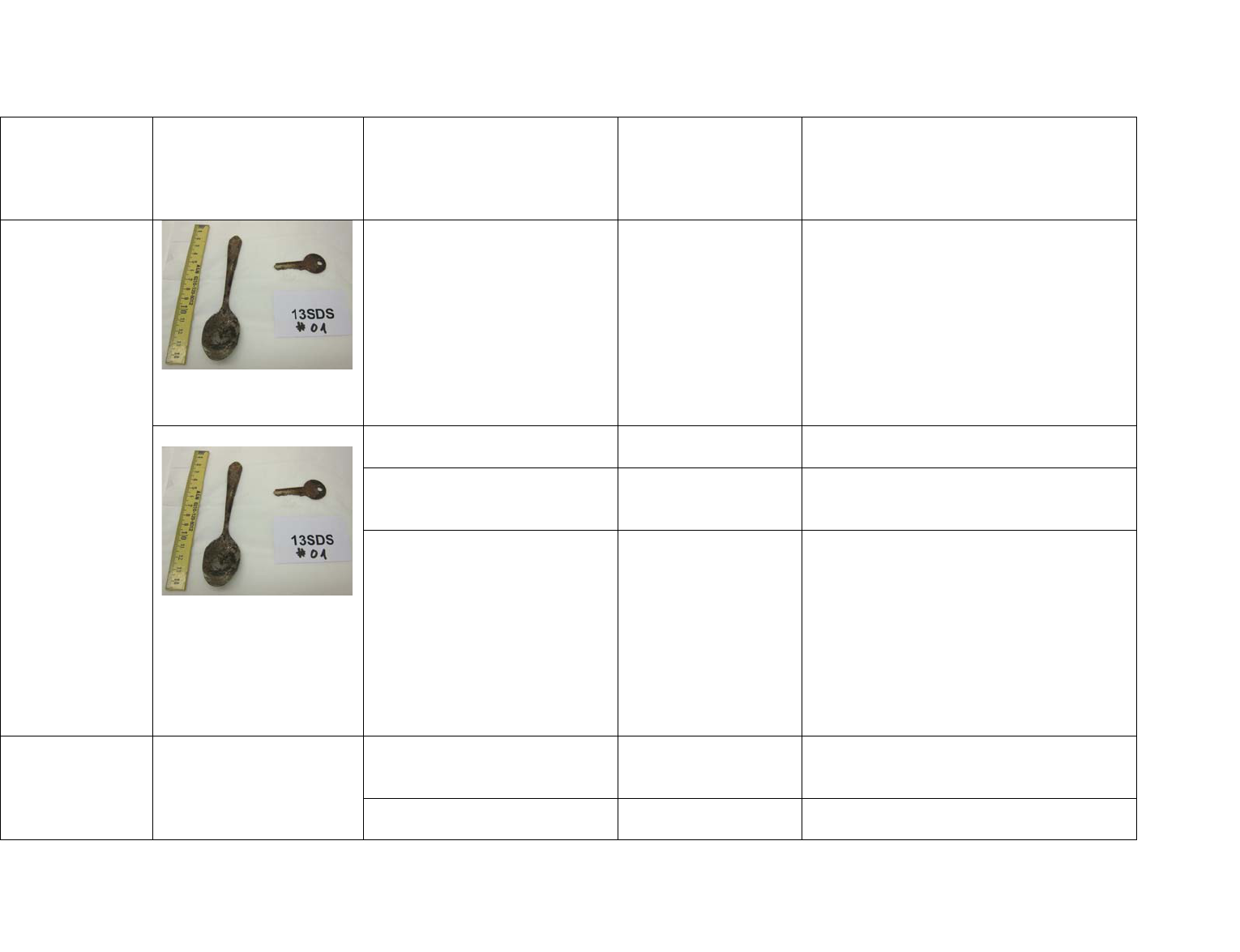
S/1319/2015
Annex 2
page 41
Date of receipt;
OPCW evidence
reference
number; and
sample code
Sample description Sample preparation Technique Result
Extraction of 18.9 mg of
corrosion debris from key with 3
mL deuterium oxide. Dilution of
1 mL of extract with 20 mL
water.
Re-extraction of debris with 3
mL 10% hydrochloric acid.
Dilution of 1 mL of extract with
20 mL water.
ICP-MS
ICP-OES
IC
- Fe [mg/kg debris]: 2000 (OES)
- K [mg/kg debris]: 350 (OES)
- Mn [mg/kg debris]: 25 (MS)
- Chloride [mg/kg debris]: 1700 (IC)
- Fe [mg/kg debris]: 180000 (OES)
- K [mg/kg debris]: 200 (OES)
- Mn [mg/kg debris]: 1100 (MS)
Teaspoon
XRF spectroscopy on surface XRF spectroscopy on
surface
- K [mg/kg]: < LOD
- Mn [mg/kg]: 2’500
Extraction of 8.7 mg of
corrosion debris from teaspoon
with 2 mL dichloromethane-d2.
GC-EI-MS/dFPD
GC-AED
- Oxidation products of BHT
Extraction of 7.5 mg of
corrosion debris from teaspoon
with 3 mL deuterium oxide.
Dilution of 1mL of extract with
20 mL water.
Re-extraction of debris with
3 mL 10% hydrochloric acid.
Dilution of 1mL of extract with
20 mL water.
ICP-MS
ICP-OES
IC
- Fe [mg/kg debris]: 1500 (OES)
- K [mg/kg debris]: 2500 (OES)
- Mn [mg/kg debris]: 300 (MS)
- Chloride [mg/kg debris]: 6000 (IC)
- Fe [mg/kg debris]: 9000 (OES)
- K [mg/kg debris]: 1000 (OES)
- Mn [mg/kg debris]: 400 (MS)
23/07/2015
20150723100802
14SDS
Metal Rod from level float
of water tank
None XRF spectroscopy on
surface
- K [mg/kg]: < LOD
- Mn [mg/kg]: 3000
- S [mg/kg]: 75000
Extraction of 98.7 mg of
corrosion debris from metal rod
GC-EI-MS/dFPD
GC-AED

S/1319/2015
Annex 2
page 42
Date of receipt;
OPCW evidence
reference
number; and
sample code
Sample description Sample preparation Technique Result
of level float with 2 mL
dichloromethane-d2.
Extraction of 99.7 mg of
corrosion debris from metal rod
of level float with 3 mL
deuterium oxide. Dilution of
1 mL of extract with 20 mL
water.
Re-extraction of debris with 3
mL 10% hydrochloric acid.
Dilution of 1 mL of extract with
20 mL water.
ICP-MS
ICP-OES
IC
- Fe [mg/kg debris]: < LOD (OES)
- K [mg/kg debris]: < LOD (OES)
- Mn [mg/kg debris]: < LOD (MS)
- Chloride [mg/kg debris]: 800 (IC)
- Fe [mg/kg debris]: 50000 (OES)
- K [mg/kg debris]: < LOD (OES)
- Mn [mg/kg debris]: 400 (MS)
Floater from level float of
water tank
None XRF spectroscopy on
surface
- K [mg/kg]: < LOD
- Mn [mg/kg]: 16’000
Rinsing of floater with 5 mL
acetonitrile-d3.
GC-EI-MS/dFPD
GC-AED
- Diazinon
- Oxidation products of BHT
- PAHs
23/07/2015
20150723100803
Electrical light bulb
None XRF spectroscopy on
surface
- K [mg/kg]: < LOD
- Mn [mg/kg]: 20000
Extraction of 11.3 mg of debris GC-EI-MS/dFPD - TNT
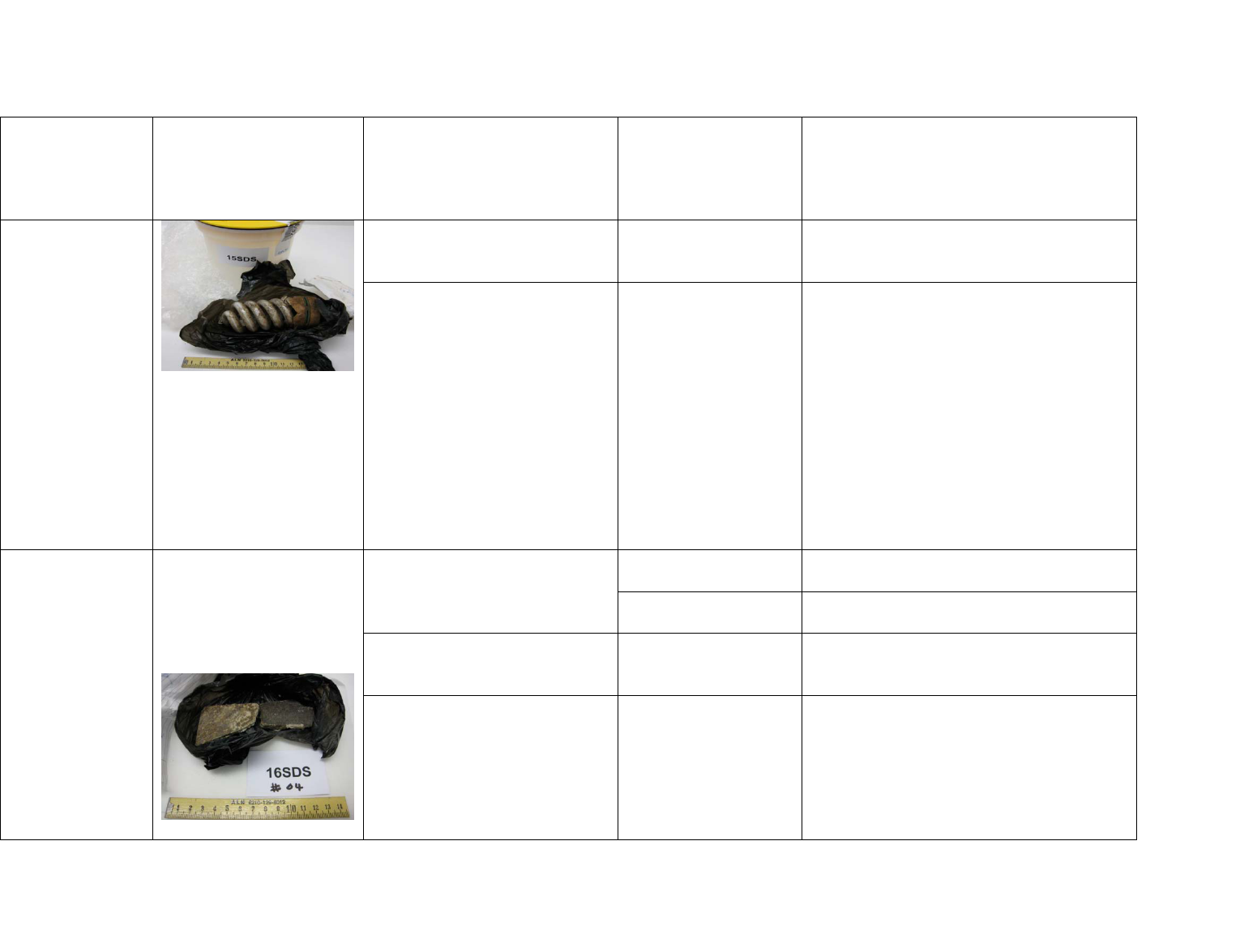
S/1319/2015
Annex 2
page 43
Date of receipt;
OPCW evidence
reference
number; and
sample code
Sample description Sample preparation Technique Result
15SDS
from light bulb (luminous
element and thread) with 2 mL
dichloromethane-d2.
GC-AED - Oxidation products of BHT
Extraction of 8.7 mg of debris
from light bulb with 3 mL
deuterium oxide. Dilution of
1 mL of extract with 20 mL
water.
Re-extraction of debris with
3mL 10% hydrochloric acid.
Dilution of 1 mL of extract with
20 mL water.
ICP-MS
ICP-OES
IC
- Fe [mg/kg debris]: < LOD (OES)
- K [mg/kg debris]: 33000 (OES)
- Mn [mg/kg debris]: < LOD (MS)
- Chloride [mg/kg debris]: 37000 (IC)
- Fe [mg/kg debris]: 7500 (OES)
- K [mg/kg debris]: 13000 (OES)
- Mn [mg/kg debris]: 32000 (MS)
23/07/2015
20150723100804
16SDS
Two pieces of
construction material
(piece #2 with dark
coloured debris on surface
used for analysis)
None XRF spectroscopy on
surface (piece 1)
- K [mg/kg]: 1200
- Mn [mg/kg]: 11000
XRF spectroscopy on
surface (piece 2)
- K [mg/kg]: 6200
- Mn [mg/kg]: 36000
Extraction of 45.7 mg of debris
from dark coloured surface with
2 mL dichloromethane-d2.
GC-EI-MS/dFPD
GC-AED
Extraction of 51.2mg of debris
from dark coloured surface with
3mL deuterium oxide. Dilution
of 1mL of extract with 20mL
water.
ICP-MS
ICP-OES
IC
- Fe [mg/kg debris]: < LOD (OES)
- K [mg/kg debris]: 33000 (OES)
- Mn [mg/kg debris]: < LOD (MS)
- Chloride [mg/kg debris]: 37’000 (IC)
- Fe [mg/kg debris]: 7500 (OES)
- K [mg/kg debris]: 13000 (OES)

S/1319/2015
Annex 2
page 44
Date of receipt;
OPCW evidence
reference
number; and
sample code
Sample description Sample preparation Technique Result
Re-extraction of debris with
3 mL 10% hydrochloric acid.
Dilution of 1mL of extract with
20 mL water.
- Mn [mg/kg debris]: 32000 (MS)
23/07/2015
20150723100805
17SDS
Part of an exploded HCFC
gas cylinder
None XRF spectroscopy on
inside surface of
HCFC container
(different spots)
- K [mg/kg]: < LOD
- Mn [mg/kg]: 2000-6000
Extraction of 55.7 mg of
corrosion debris from inside
surface of HCFC container with
2 mL dichloromethane-d2
(spot #1).
GC-EI-MS/dFPD
GC-AED
Extraction of 46.1 mg of
corrosion debris from inside
surface of HCFC container with
2 mL dichloromethane-d2
(spot #2).
GC-EI-MS/dFPD
GC-AED
Extraction of 99.0 mg of
corrosion debris from inside
surface of HCFC container with
2 mL dichloromethane-d2
(spot #3).
GC-EI-MS/dFPD
GC-AED
Extraction of 50.2 mg of
corrosion debris from inside
surface of HCFC container with
3 mL deuterium oxide (spot #1).
Dilution of 1 mL of extract with
20 mL water.
ICP-MS
ICP-OES
IC
- Fe [mg/kg debris]: < LOD (OES)
- K [mg/kg debris]: 150 (OES)
- Mn [mg/kg debris]: < LOD (MS)
- Chloride [mg/kg debris]: 1200 (IC)
- Fe [mg/kg debris]: 60000 (OES)

S/1319/2015
Annex 2
page 45
Date of receipt;
OPCW evidence
reference
number; and
sample code
Sample description Sample preparation Technique Result
Re-extraction of debris with
3 mL 10% hydrochloric acid.
Dilution of 1mL of extract with
20 mL water.
- K [mg/kg debris]: 150 (OES)
- Mn [mg/kg debris]: 300 (MS)
Extraction of 48.8 mg of
corrosion debris from inside
surface of HCFC container with
3 mL deuterium oxide (spot #2).
Dilution of 1 mL of extract with
20 mL water.
Re-extraction of debris with
3 mL 10% hydrochloric acid.
Dilution of 1mL of extract with
20 mL water.
ICP-MS
ICP-OES
IC
- Fe [mg/kg debris]: < LOD (OES)
- K [mg/kg debris]: 200 (OES)
- Mn [mg/kg debris]: < LOD (MS)
- Chloride [mg/kg debris]: 400 (IC)
- Fe [mg/kg debris]: 120000 (OES)
- K [mg/kg debris]: 100 (OES)
- Mn [mg/kg debris]: 300 (MS)
Extraction of 99.0 mg of
corrosion debris from inside
surface of HCFC container with
3mL deuterium oxide (spot #3).
Dilution of 1 mL of extract with
20 mL water.
Re-extraction of debris with
3 mL 10% hydrochloric acid.
Dilution of 1mL of extract with
20 mL water.
ICP-MS
ICP-OES
IC
- Fe [mg/kg debris]: < LOD (OES)
- K [mg/kg debris]: 700 (OES)
- Mn [mg/kg debris]: < LOD (MS)
- Chloride [mg/kg debris]: 1400 (IC)
- Fe [mg/kg debris]: 7000 (OES)
- K [mg/kg debris]: 1000 (OES)
- Mn [mg/kg debris]: 1’100 (MS)
23/07/2015
Part of an exploded HCFC
gas cylinder
None XRF spectroscopy on
outside surface of
- K [mg/kg]: < LOD
- Mn [mg/kg]: 40’000

S/1319/2015
Annex 2
page 46
Date of receipt;
OPCW evidence
reference
number; and
sample code
Sample description Sample preparation Technique Result
20150723100806
18SDS
HCFC container
Extraction of 100.1 mg of
corrosion debris from out-side
surface of HCFC container with
2 mL dichloro-methane-d2.
GC-EI-MS/dFPD
GC-AED
Extraction of 100.6 mg of
corrosion debris from out-side
surface of HCFC container with
3mL deuterium oxide. Dilution
of 1mL of extract with 20 mL
water.
Re-extraction of debris with
3 mL 10% hydrochloric acid.
Dilution of 1mL of extract with
20 mL water.
ICP-MS
ICP-OES
IC
- Fe [mg/kg debris]: < LOD (OES)
- K [mg/kg debris]: 400 (OES)
- Mn [mg/kg debris]: < LOD (MS)
- Chloride [mg/kg debris]: 300 (IC)
- Fe [mg/kg debris]: 60000 (OES)
- K [mg/kg debris]: 1400 (OES)
- Mn [mg/kg debris]: 8500 (MS)
None XRF spectroscopy on
inside surface of
HCFC container
- K [mg/kg]: < LOD
- Mn [mg/kg]: 2500
Extraction of 96.5 mg of
corrosion debris from inside
surface of HCFC container with
2 mL dichloromethane-d2.
GC-EI-MS/dFPD
GC-AED
- Oxidation products of BHT
- PAHs
Extraction of 81.9 mg of
corrosion debris from inside
surface of HCFC container with
3 mL deuterium oxide. Dilution
of 1 mL of extract with 20 mL
water.
ICP-MS
ICP-OES
IC
- Fe [mg/kg debris]: < LOD (OES)
- K [mg/kg debris]: 600 (OES)
- Mn [mg/kg debris]: 40 (MS)
- Chloride [mg/kg debris]: 1500 (IC)
- Fe [mg/kg debris]: 90000 (OES)

S/1319/2015
Annex 2
page 47
Date of receipt;
OPCW evidence
reference
number; and
sample code
Sample description Sample preparation Technique Result
Re-extraction of debris with
3 mL 10% hydrochloric acid.
Dilution of 1mL of extract with
20 mL water.
- K [mg/kg debris]: 500 (OES)
- Mn [mg/kg debris]: 4000 (MS)
23/07/2015
20150723100807
19SDS
One piece of wood (dark
coloured debris on surface
used for analysis)
None XRF spectroscopy on
surface
- K [mg/kg]: 32000
- Mn [mg/kg]: 11000
Extraction of 21.2 mg of debris
from wood piece with 2 mL
dichloromethane-d2.
GC-EI-MS/dFPD
GC-AED
- Diazinon
- Oxidation products of BHT
Extraction of 21.2 mg of debris
from wood piece with 3 mL
deuterium oxide. Dilution of
1mL of extract with 20mL
water.
Re-extraction of debris with
3 mL 10% hydrochloric acid.
Dilution of 1mL of extract with
20 mL water.
ICP-MS
ICP-OES
IC
- K [mg/kg debris]: 5000 (OES)
- Mn [mg/kg debris]: 250 (MS)
- Chloride [mg/kg debris]: 4600 (IC)
- K [mg/kg debris]: 3000 (OES)
- Mn [mg/kg debris]: 30000 (MS)
23/07/2015
20150723100808
20SLS
Soil sample (sand and
stones)
Transfer of sample in XRF cup. XRF spectroscopy on
soil surface
- K [mg/kg]: 50000
- Mn [mg/kg]: 60000
(stoichiometric ratio K / Mn ~1:1)
Extraction of 5 g soil with 5 mL
dichloromethane-d2.
GC-EI-MS/dFPD
GC-AED
- TNT
- Oxidation products of BHT
- PAHs
- PCAHs
Extraction of 5 g soil with 5 mL
deuterium oxide. Dilution of
1mL of extract with 20 mL
water.
ICP-MS
ICP-OES
IC
- K [mg/kg]: 14000 (OES, 1:100)
- Mn [mg/kg]: 25 (MS)
- Chloride [mg/kg]: 21000 (IC)
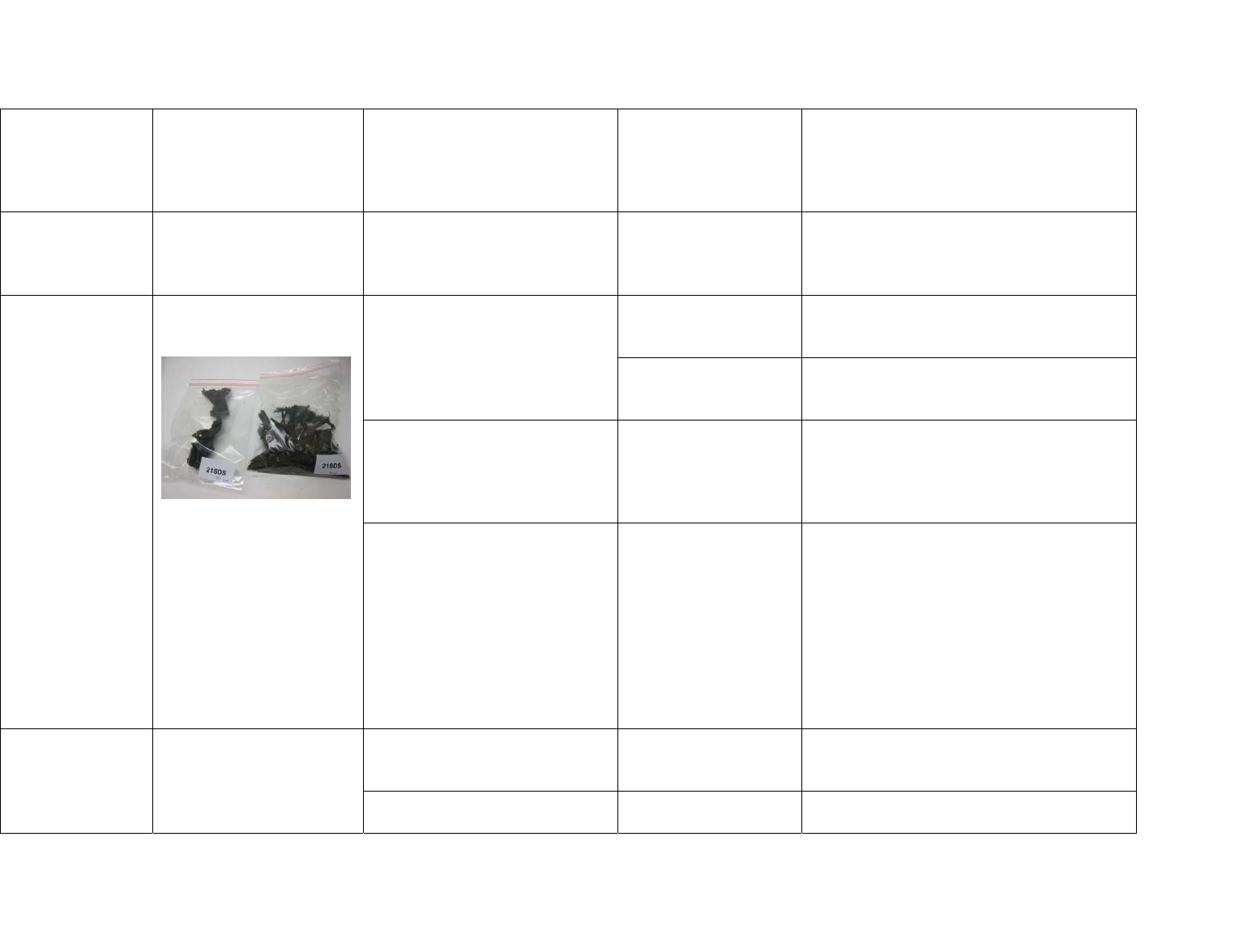
S/1319/2015
Annex 2
page 48
Date of receipt;
OPCW evidence
reference
number; and
sample code
Sample description Sample preparation Technique Result
Re-dilution of 0.1 mL of extract
with 10 mL water for ICP-OES
analysis.
23/07/2015
20150723100809
21SDS
Pieces of wood
(+plastic container)
None XRF spectroscopy on
surface
(container)
- K [mg/kg]: 18000
- Mn [mg/kg]: 24000
(stoichiometric ratio K / Mn ~1:1)
XRF spectroscopy on
surface
(wood pieces)
- K [mg/kg]: 28000
- Mn [mg/kg]: 18000
Extraction of 2.0 g of splinters
of wood with 5 mL
dichloromethane-d2.
GC-EI-MS/dFPD
GC-AED
- -Pinene and bornyl chloride (bornyl
chloride is a reaction product of -pinene
with chlorinating agents)
- TNT
- PCAHs
Extraction of 2.0 g of splinters
of wood with 5 mL deuterium
oxide. Dilution of 1 mL of
extract with 20 mL water.
Re-extraction of splinters of
wood with 5 mL 10%
hydrochloric acid. Dilution of
1 mL of extract with 20 mL
water.
ICP-MS
ICP-OES
IC
- K [mg/kg]: 1000 (OES)
- Mn [mg/kg]: 8000 (MS)
- Chloride [mg/kg]: 33000 (IC)
- K [mg/kg]: 4500 (OES)
- Mn [mg/kg]: 7000 (MS)
23/07/2015
20150723100810
22SDS
Plastic containers
None XRF spectroscopy on
surface
- K [mg/kg]: 70000
- Mn [mg/kg]: 90000
(stoichiometric ratio K / Mn ~1:1)
Cutting piece of plastic
container and cleaning of
FTIR spectroscopy - Polymer identified as PET
(polyethylene terephthalate)
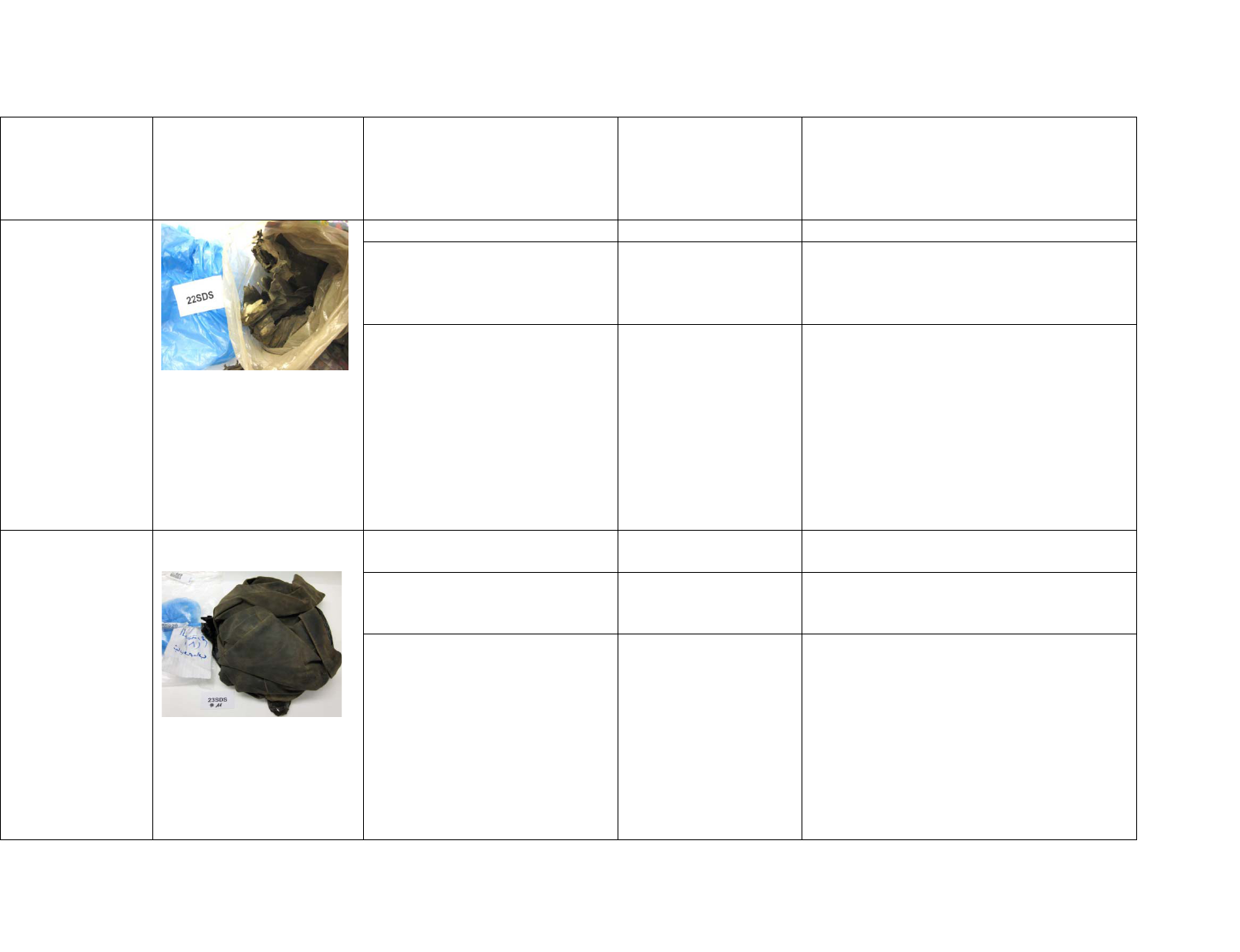
S/1319/2015
Annex 2
page 49
Date of receipt;
OPCW evidence
reference
number; and
sample code
Sample description Sample preparation Technique Result
surface.
Cutting piece (280 mg) of plastic
container and extraction with
2 mL dichloromethane-d2.
GC-EI-MS/dFPD
GC-AED
- TNT
- Oxidation products of BHT
- PAHs
- PCAHs
Cutting piece (280 mg) of plastic
container and extraction with
3 mL deuterium oxide. Dilution
of 1 mL of extract with 20 mL
water.
Re-extraction of container piece
with 3 mL 10% hydrochloric
acid. Dilution of 1 mL of extract
with 20 mL water.
ICP-MS
ICP-OES
IC
- K [mg/kg]: 4500 (OES)
- Mn [mg/kg]: < LOD (MS)
- Chloride [mg/kg debris]: 3500 (IC)
- K [mg/kg]: 1600 (OES)
- Mn [mg/kg]: 3700 (MS)
23/07/2015
20150723100811
23SDS
Jacket of a victim
None XRF spectroscopy on
sleeve surface
- K [mg/kg]: 11000
- Mn [mg/kg]: 5000
Cutting piece of jacket (950 mg)
and extraction with 5 mL
acetonitrile-d3.
GC-EI-MS/dFPD
GC-AED
- PAHs
Cutting piece of jacket (920 mg)
and extraction with 3 mL
deuterium oxide. Dilution of
1 mL of extract with 20 mL
water.
Re-extraction of jacket piece
with 3 mL 10% hydro-chloric
acid. Dilution of 1 mL of extract
with 20 mL water.
ICP-MS
ICP-OES
IC
- K [mg/kg]: 4000 (OES)
- Mn [mg/kg]: 1200 (MS)
- Chloride [mg/kg]: 13000 (IC)
- K [mg/kg]: 2100 (OES)
- Mn [mg/kg]: 2300 (MS)
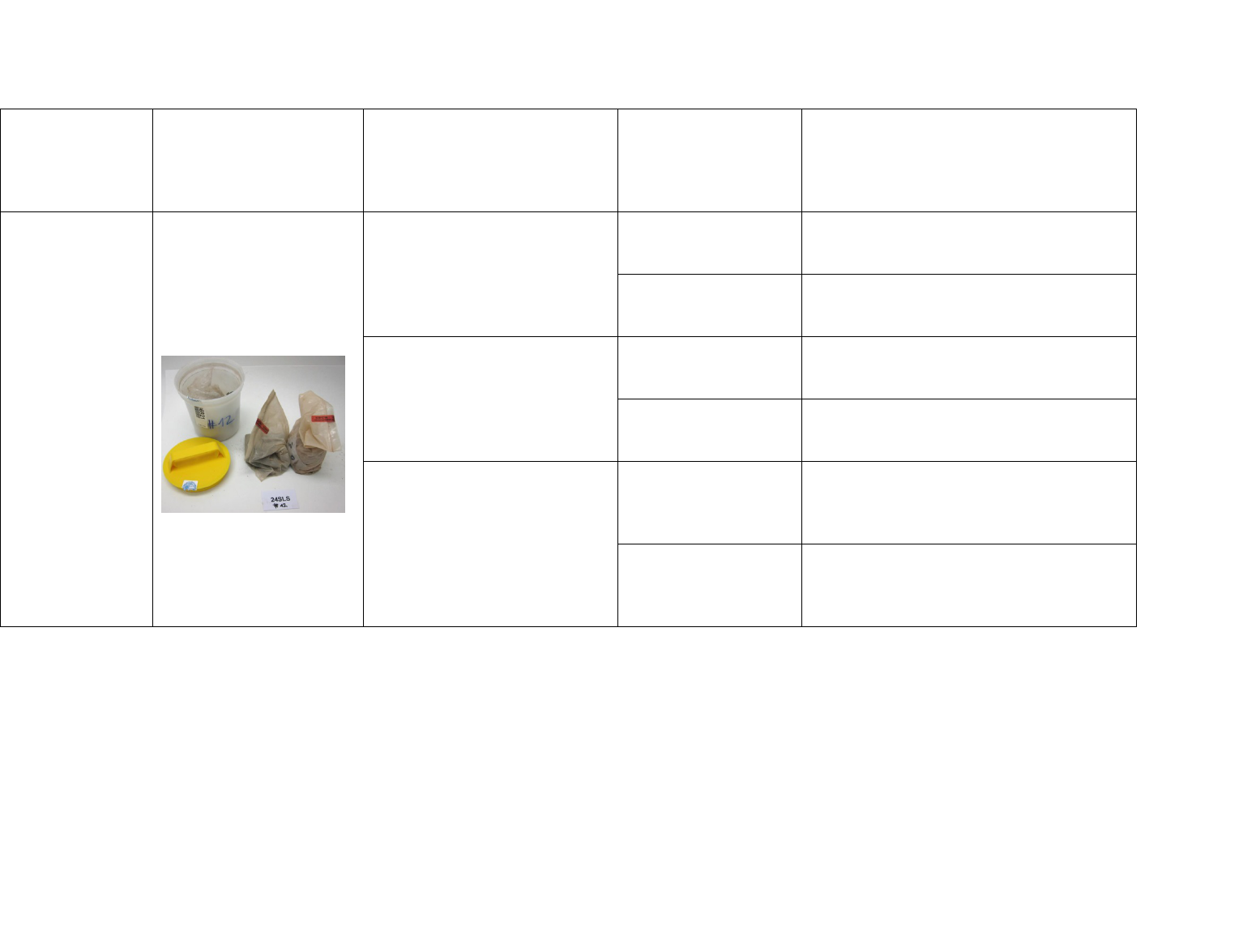
S/1319/2015
Annex 2
page 50
Date of receipt;
OPCW evidence
reference
number; and
sample code
Sample description Sample preparation Technique Result
23/07/2015
20150723100812
24SLS
2 Soil samples taken from
Sarmin as background
sample (blank sample)
from two locations
(Location 1 and
location 2)
Transfer of sample in XRF cup. XRF spectroscopy on
soil surface (location
1)
- K [mg/kg]: 15000
- Mn [mg/kg]: 350
XRF spectroscopy on
soil surface (location
2)
- K [mg/kg]: 9000
- Mn [mg/kg]: 350
Extraction of 5 g soil with 5 mL
dichloromethane-d2.
GC-EI-MS/dFPD
GC-AED
(location 1)
- PAHs
GC-EI-MS/dFPD
GC-AED
(location 2)
- Oxidation products of BHT
- PAHs
Extraction of 5 g soil with 5mL
to 7 ml deuterium oxide.
Dilution of 1 mL of extract with
20 mL water.
ICP-MS
ICP-OES
IC
(location 1)
- K [mg/kg]: 500 (OES)
- Mn [mg/kg]: < LOD (MS)
- Chloride [mg/kg]: 300 (IC)
ICP-MS
ICP-OES
IC
(location 2)
- K [mg/kg]: < LOD (OES)
- Mn [mg/kg]: < LOD (MS)
- Chloride [mg/kg]: 30 (IC)
BHT: Butylated hydroxytoluene, HCFC: hydrochlorofluorocarbon, Cl: Chloride, Fe: Iron, FTIR: Fourier Transform Infrared Spectroscopy, GC-EI-
MS/dFPD: Gas Chromatography – Mass Spectrometry / dual Flame Photometry Detection, IC: Ion Chromatography, ICP-MS: Inductively Coupled
Plasma Mass Spectrometry, ICP-OES: Inductively Coupled Plasma Optical Emission Spectrometry, K: Potassium, LOD: Limit of Detection, Mn:
Manganese, NMR: Nuclear Magnetic Resonance Spectroscopy, PAHs: Polycyclic aromatic hydrocarbons, PCAHs: Polychlorinated aromatic
hydrocarbons, PET: Polyethylene terephthalate, S: Sulfur, TNT: Trinitrotoluene, XRF: X-ray Fluorescence.
** All photographs from samples received on 23/07/2015, courtesy of Spiez Laboratories**
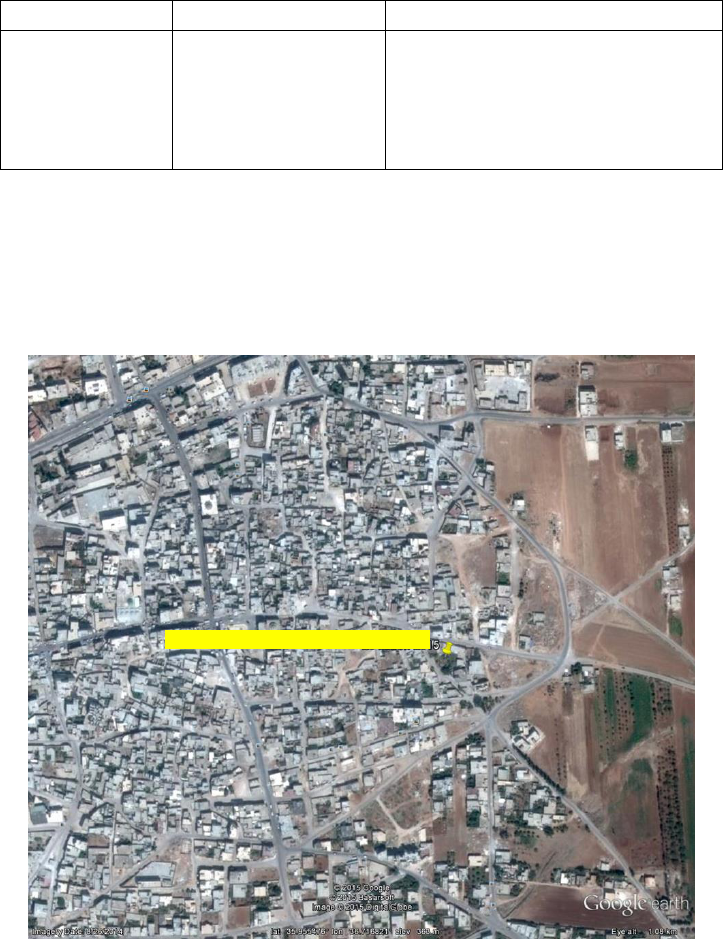
S/1319/2015
Annex 2
page 51
Binnish
3.73 Binnish is a small city in the Idlib Governorate of the Syrian Arab Republic.
Other villages close to Binnish include Al-Fu’ah village at 2 km NWN and
Taoum village at 4 km ENE.
3.74 The FFM interviewed and collected the testimony of a treating physician
about the alleged incident of 23 March 2015.
TABLE 11: INFORMATION ON THE ALLEGED INCIDENT IN
BINNISH
Date Approximate time Weather conditions
23 March 2015 19:00 – 20:00 Stable temperatures around
14°C between 19:00 and
midnight, with 55% to 72%
humidity. The wind direction
was variable at 1 to 5 m/s.
3.75 Figure 14 below shows the approximate alleged impact point of the device, as
derived from the interviewee.
FIGURE 14: APPROXIMATE ALLEGED IMPACT POINT OF THE
DEVICE
Impact point, 23 March 2015, Binnish
S/1319/2015
Annex 2
page 52
Narrative
3.76 The FFM team interviewed only one person from Binnish, who was a treating
physician at the time of the alleged incident.
3.77 At the time of the incident, the city was not under the control of the
government. The interviewee reported frequent airborne, artillery, and mortar
attacks. A large number of families were displaced from the village and were
located elsewhere. The population of the city before the crisis was
approximately 40,000. By March 2015, the population was reduced to around
5,000 due to its close proximity to the front line 7 km to the west of the city.
3.78 On 23 March 2015 at around 19:00, one item was dropped on the city in the
south-eastern area of the village in agricultural land. The physician was in the
field hospital; he did not hear any explosion and was informed of the incident
through the local early-warning methods, including the use of hand-held
radios. There was no mobile telephone coverage in this village at the time of
the incident.
3.79 Binnish field hospital registered 21 patients related to the incident on
23 March. Out of these 21, 10 were mild cases, 10 were moderate cases, and
one was identified as a severe case. No deaths were reported to the FFM team.
3.80 The decontamination of patients, including washing of the exposed area of
skin, was done for all cases. This decontamination was conducted using water
outside the hospital, five to 10 m from the emergency room. The physician
did not smell chlorine odour emanating from the clothing but was informed of
the smell by the patients.
3.81 Twenty-four hours later, the interviewee visited the place where the item
allegedly hit the ground. He did not see any remnants of the item and
reported: “I saw that there was a wheat field and the wheat turned yellow on
an area of about 50 metres, all yellow. The yellow colour was clearly visible”.
Epidemiological analysis
3.82 Binnish has one field hospital, which is in one of the buildings in the village
and is intended specifically for the medical needs of this village, including the
treatment of traumatic war injuries. There are also four private clinics (none
of them are known to have received cases from the alleged chemical
incidents). The hospital has a staff of eight doctors specialised in the fields of
general surgery, urology, orthopaedics, internal medicine, dermatology, and
gynaecology, as well as 15 other staff including seven certified nurses and
eight field-trained nurses. The hospital staff members do not have formal
training in the management of injuries resulting from chemical incidents.
Furthermore, the structure of the hospital has been augmented continuously
since its establishment. The resources available at the hospital include a
laboratory, radiology department, pharmacy, two operating theatres, a delivery
room, emergency room with a total of eight in-patient beds, four oxygen
cylinders, and eight nebulisers. All individuals who present to this field
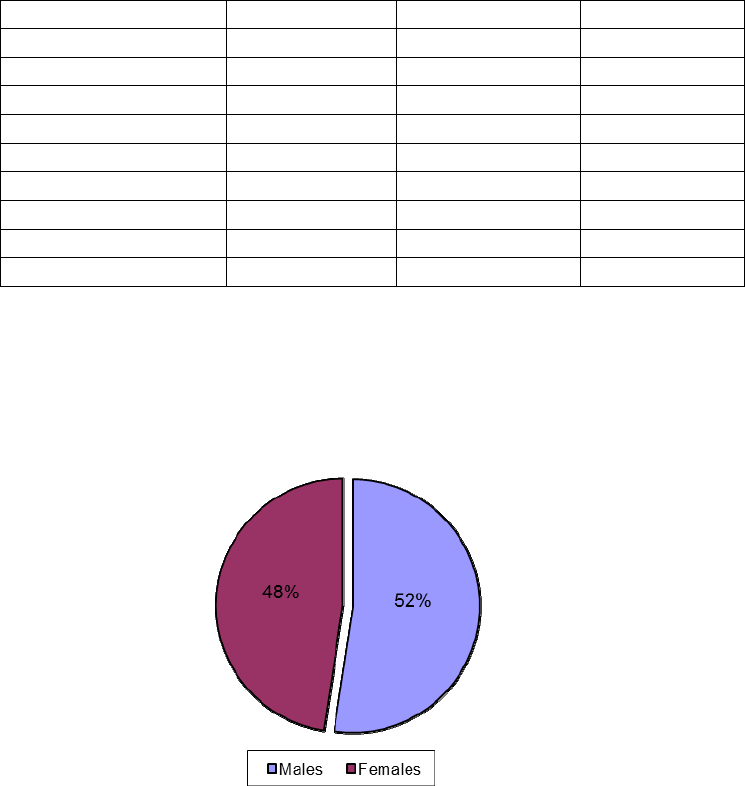
S/1319/2015
Annex 2
page 53
hospital for routine illness, diseases, and war injuries are registered, and all
medical records are maintained.
3.83 The field hospital received all of the approximately 21 patients from the
alleged chemical incident. The physician informed the FFM that the hospital
staff were able to register most, but not all, of the names. A copy of a list of
patients with the stamp of the hospital (but not the patient registration book,
and no medical files) was provided showing the name, age, and gender. The
age distribution of the 21 patients recorded as having been treated at the field
hospital is provided in the table below:
TABLE 12: PATIENT DISTRIBUTION ACCORDING TO AGE
GROUP
Age group Total Males Females
0 to 5 years 3 2 1
6 to10 years 0 0 0
11 to 15 years 2 1 1
16 to 20 years 6 4 2
21 to 30 years 5 3 2
31 to 40 years 2 2
41 to 50 years 2 1 1
51 to 60 years 1 1
Total 21 11 10
FIGURE 15: DISTRIBUTION OF CASES BY GENDER
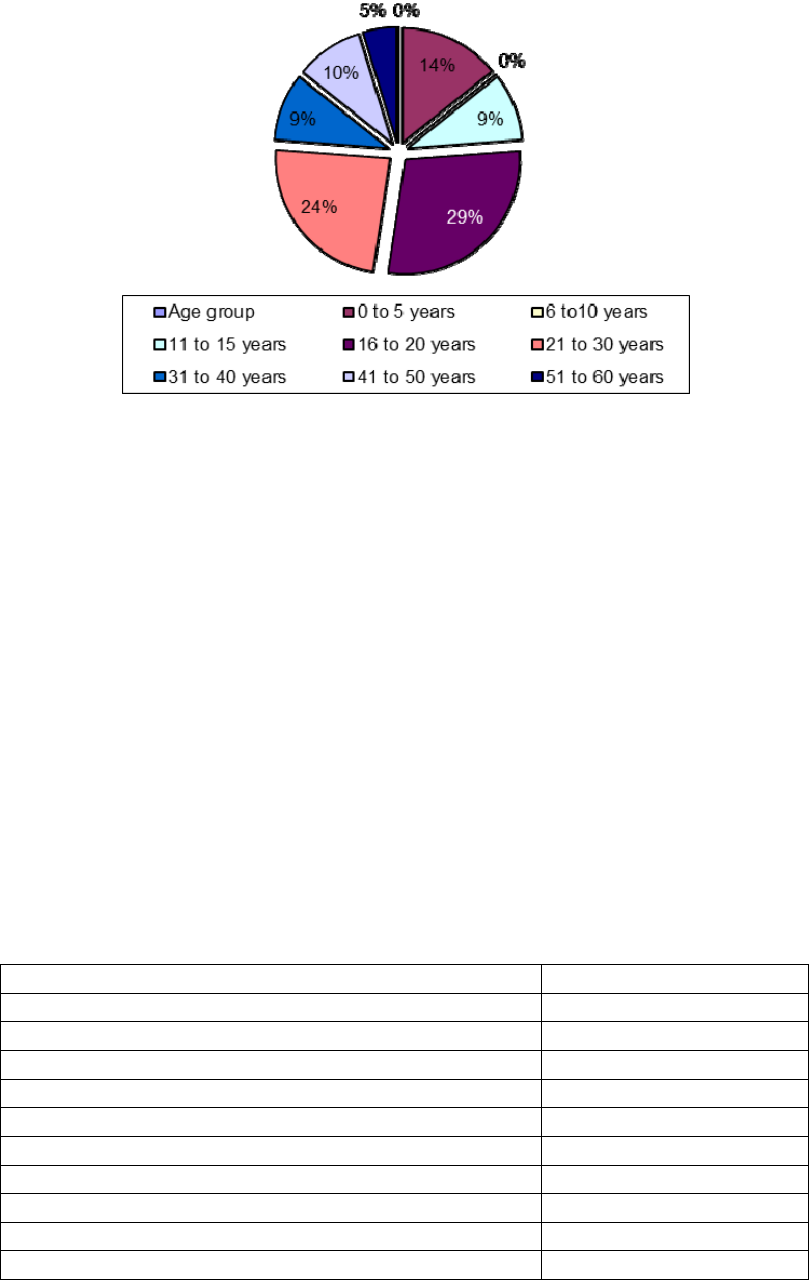
S/1319/2015
Annex 2
page 54
FIGURE 16: DISTRIBUTION OF CASES BY AGE
3.84 The clinical examination demonstrated that most of the cases presented with
the following symptoms: coughing, difficulty breathing, and drowsiness.
Some of the signs were due to anxiety and psychosomatic stress. The
dyspnoea in the moderate cases was grade 1. The physician classified the
dyspnoea in four grades:
(a) Grade 1: provoked by severe exercise;
(b) Grade 2: provoked by moderate exercise;
(c) Grade 3: provoked by mild exercise; and
(d) Grade 4: at rest.
3.85 The one severe case presented with severe anxiety, severe coughing and
resistance, difficulty breathing, shortness of breath, severe wheezing, mild eye
irritation. The spread of symptoms is indicated in the table below.
TABLE 13: SYMPTOMS RELATING TO THE INCIDENT IN
BINNISH
Symptom Binnish
Coughing 10
Difficulty breathing 10
Tearing, burning sensation in eyes 1
Nausea/vomiting 0
Loss of consciousness 0
Burning sensation on exposed skin/nose 0
Feeling of panic 21
Physical injuries 0
Death 0
Total 21

S/1319/2015
Annex 2
page 55
FIGURE 17: SIGNS AND SYMPTOMS RELATING TO THE
INCIDENT IN BINNISH
3.86 No cutaneous or severe ophthalmologic signs or hypoxemia were reported.
All of these individuals responded well to the administration of oxygen
(five litres per minute) and nebulisation with the bronchodilator salbutamol.
Those with moderate symptoms also benefitted from inhaler steroids or
intravenous steroids, hydrocortisone, or dexamethasone.
3.87 The severe case was managed with oxygen (seven litres per minute)
nebulisation with the bronchodilator salbutamol, inhaler steroids, and
lidocaine nebuliser for the cough.
3.88 Neither a laboratory exam nor an X-ray was requested by the treating
physicians for any of the cases as all of these individuals were discharged
from the hospital after three hours. None of the individuals affected in the
incident had any signs of physical trauma on their bodies, but only suffered
from the effects of a toxic chemical. The physician presented these cases as
possibly to be due to chlorine but not confirmed as such.
TABLE 14: TREATMENT OF CASUALTIES IN BINNISH
Decontamination 21
Oxygen 21
Bronchodilator nebuliser 21
Inhaler steroids 10
Intravenous steroids 10
Lidocaine nebuliser 1
Laboratory analysis 0
X-ray 0
10
10
1
000
21
0
0
Coughing
Difficulty breathing
Tearing, burning sensation in
eyes
Nausea/vomiting
Loss of consciousness
Burning sensation on exposed
skin/nose
Feeling of panic
Physical injuries
Death
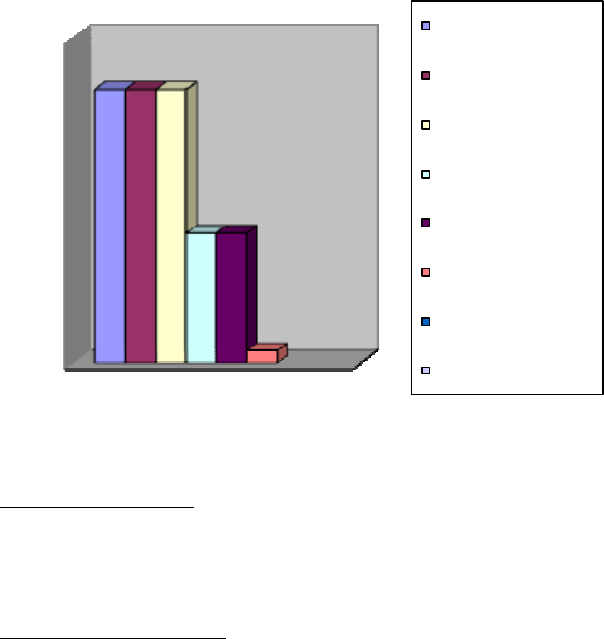
S/1319/2015
Annex 2
page 56
FIGURE 18: MANAGEMENT OF CASES IN BINNISH
Biomedical samples
3.89 No biomedical samples were taken from the patients, neither by the FFM team
nor by the medical staff at the Binnish field hospital.
Environmental samples
3.90 No environmental samples were collected or received by the FFM team.
Idlib City
3.91 Idlib City is the principal city of the Idlib Governorate of the Syrian Arab
Republic.
3.92 Between 3 May and 5 June, the FFM team interviewed six individuals in the
context of incidents of alleged use of toxic chemicals as a weapon in Idlib
City. The interviewees were treating physicians, nurses, and first responders.
Three incidents had been reported by the interviewees to the FFM team. The
first incident happened on 31 March, the second was on 16 April 2015, and the
third was on 20 May 2015. Out of the three reported incidents, the
interviewees recalled more information in relation to the first incident. The
information about the second and the third incident was limited to the date of
the event, the location, and number of cases.
21
21
21
10
10
1
Decontamination
Oxygen
Bronchodilator nebuliser
Inhaler steroids
Intravenous steroids
Lidocaine nebuliser
Lab analysis
X-ray

S/1319/2015
Annex 2
page 57
TABLE 15: CHRONOLOGY OF INCIDENTS IN IDLIB CITY
Incident Date Approximate Time Weather Conditions
First 31 March 2015
11:00 – 12:00 and
13:00 – 14:00
The temperature was
18°C to 20°C, humidity
60% and the wind
velocity 10 to 12 m/s
mainly SSW.
Second 16 April 2015 00:30 – 01:00
The temperature was
around 16°C; wind
direction was variable at
1 to 2 m/s and humidity
of 50%.
Third 20 May 2015 03:00 – 04:00
In the early morning of
20 May 2015, the
temperature was stable
around 20°C and the
humidity was 50%. The
wind direction was
variable, mainly NW with
a velocity of 2 m/s.
3.93 The figure below shows the approximate alleged impact points of the devices,
as derived from the interviewees.
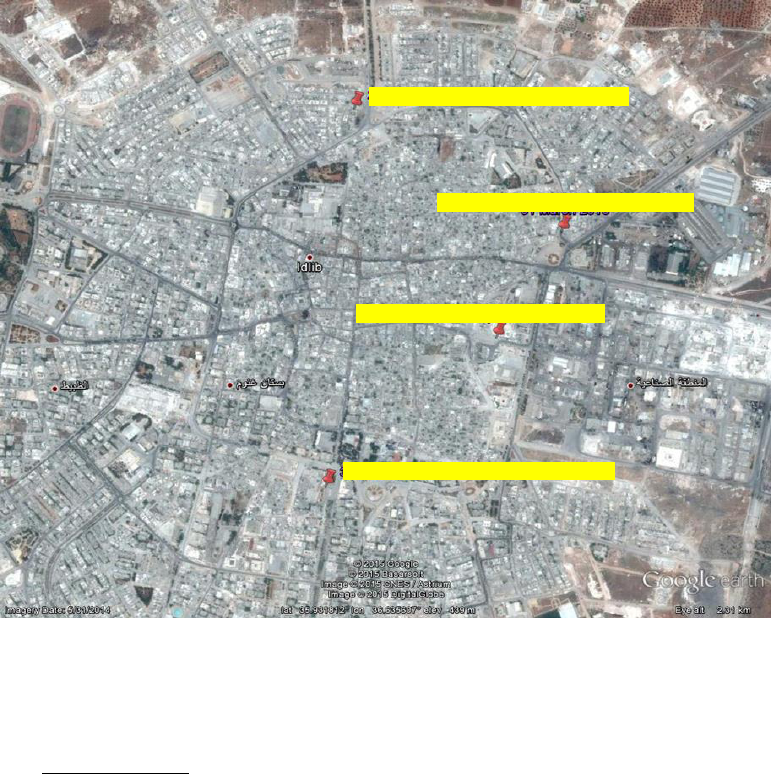
S/1319/2015
Annex 2
page 58
FIGURE 19: APPROXIMATE ALLEGED IMPACT POINTS IN IDLIB
CITY
Narrative
3.94 On the days of the incidents the city was not under the control of the
government.
31 March 2015
3.95 On 31 March 2015 at around noon, a helicopter was heard passing above Idlib
and was seen to have dropped one item. One eyewitness started to video
record after detonation of the munition and provided the recording to the FFM
team. The video showed a drifting yellow-green cloud. A few minutes later, a
message was broadcast that the helicopter had dropped a chlorine item close
by the governorate administrative building (HQ). One hour later, a second
alleged item was dropped on “Al-Mahreb roundabout” close by the museum.
3.96 Interviewees, in particular the first responders, described smelling the typical
odour of chlorine as they approached the impact point.
3.97 On the same day two to three hours before the first incident, the national hospital
in Idlib had been attacked. Therefore, people who had indications of exposure
were transported to either Sarmin field hospital or Binnish field hospital for
treatment and care. Sarmin field hospital registered six patients and Binnish field
hospital registered 32 patients. All patients were considered by the medical
specialists
to be mild cases.
Impact point, 20 May 2015, Idlib City
Impact point, 31 March 2015, Idlib City
Impact point, 16 April 2015, Idlib City
Impact point, 31 March 2015, Idlib City
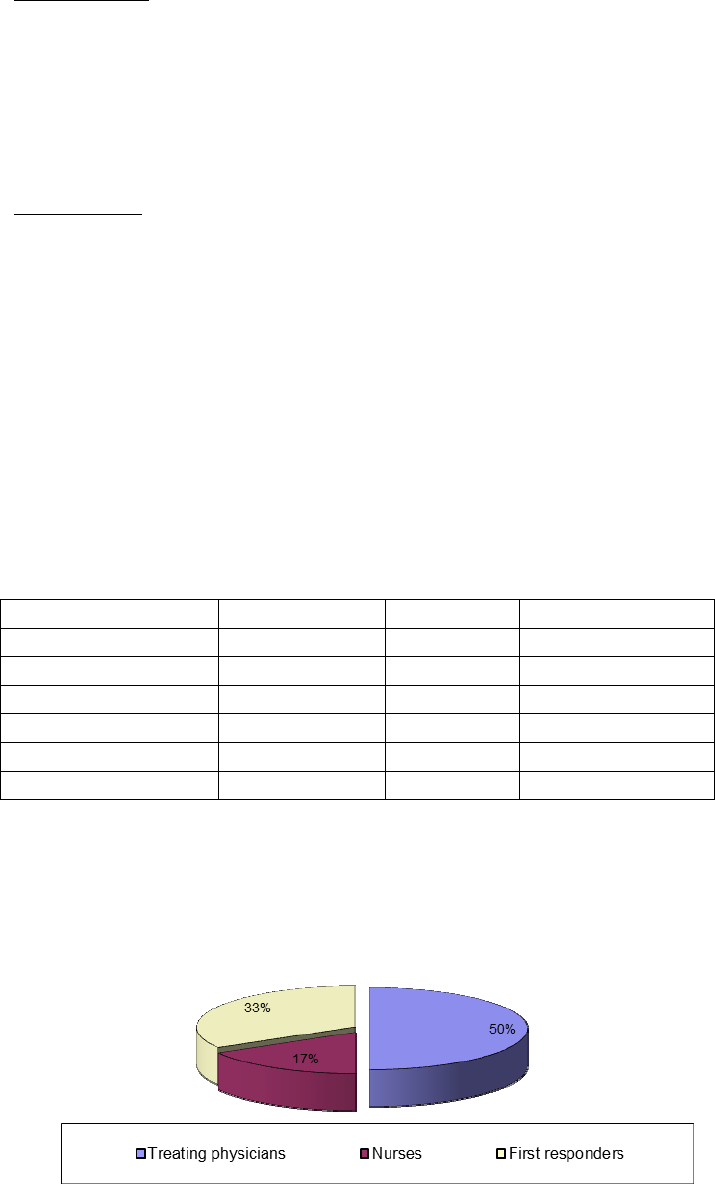
S/1319/2015
Annex 2
page 59
16 April 2015
3.98 Interviewees claimed that, on 16 April 2015 at around midnight, one item was
dropped in Idlib City. The first responders interviewed reported smelling the
typical odour of chlorine as they approached the impact point. Approximately
20 people had signs of exposure and were transported to either Sarmin field
hospital or Binnish field hospital for treatment and care.
20 May 2015
3.99 The FFM team was not able to obtain any significant information, other than
the approximate time and location for this incident.
Epidemiological analysis
3.100 The FFM team interviewed and collected the testimonies of six individuals in
the context of the investigation of incidents of alleged use of toxic chemicals
as a weapon. The interviewees were treating physicians, nurses, and first
responders. The results presented below are mainly related to the incident of
31 March 2015.
TABLE 16: RELATION TO THE INCIDENTS IN IDLIB CITY AND
GENDER DISTRIBUTION OF INTERVIEWEES
Interviewee Male Female
Treating physicians 3 3 0
Nurses 1 1 0
First responders 2 2 0
Casualties 0 0 0
Witnesses 0 0 0
Total
6 6 0
FIGURE 20: DISTRIBUTION OF INTERVIEWEES IN RELATION
TO THE INCIDENTS IN IDLIB CITY
3.101 Idlib City had no functional hospitals at that time. Therefore, for emergencies
the population used the nearest hospitals such as those in Sarmin and Binnish.
The patients were transported by volunteers in their personal cars or vans.

S/1319/2015
Annex 2
page 60
Sarmin field hospital received approximately six patients and Binnish field
hospital received 32 patients. All patients were decontaminated, which
included washing the exposed area of skin with water. This decontamination
was conducted outside the emergency room. Upon clinical examination, the
signs and symptoms observed included coughing, difficulty breathing, and
tearing.
TABLE 17: SYMPTOMS OF CASES IN IDLIB CITY
Symptom
Coughing 38
Difficulty breathing 38
Total cases 38
3.102 All patients were considered to be mild cases. None of the affected
individuals in the attack had any signs of physical trauma on their bodies, but
only suffered from the effects of the suspected toxic chemical. All cases
responded well to the administration of oxygen. No moderate or severe cases
were reported. Neither a laboratory exam nor an X-ray was requested by the
treating physicians for the cases. The patients were discharged after a
maximum of one hour.
TABLE 18: TREATMENT OF CASES IN IDLIB CITY
Decontamination 38
Oxygen 38
Bronchodilator nebuliser 0
Inhaler steroids 0
Intravenous steroids 0
Lidocaine nebuliser 0
Laboratory analysis 0
X-ray 0
3.103 Even though the hospital staff were able to register the names of the patients in
both hospitals, no copy of the patient registration book or medical files was
provided to the FFM, although these were requested. The FFM received a
copy of a list of patients with the stamp of Binnish hospital showing the name,
age and gender. The age distribution of the 32 patients treated at the Binnish
field hospital is provided in table below.
TABLE 19: PATIENT DISTRIBUTION ACCORDING TO AGE
GROUP, IDLIB CITY
Age group Total Males Females
0 to 5 years 0 0 0
6 to10 years 0 0 0
11 to 15 years 2 2 0
16 to 20 years 12 12 0
21 to 30 years 13 13 0

S/1319/2015
Annex 2
page 61
Age group Total Males Females
31 to 40 years 4 4 0
41 to 50 years 1 1 0
51 to 60 years 0 0 0
Total 32 32 0
FIGURE 21: DISTRIBUTION OF CASES IN IDLIB CITY BY AGE
2
12
13
4
1
11 to 15 years
16 to 20 years
21 to 30 years
31 to 40 years
41 to 50 years
Al-Nerab
3.104 Al-Nerab is a village in the Idlib Governorate of the Syrian Arab Republic.
3.105 The FFM interviewed eight individuals in relation to alleged incidents in
Al-Nerab; six of the interviewees were first responders, one of whom claimed
that he had been exposed and two of whom visited the impact point few days
after the incidents. The six interviewees who participated in the rescue
operation were first responders from Sarmin, located in Sarmin at the time of
the incidents. As the information provided to the FFM team was not from
direct witnesses, the team was not able to build the sequence of events from
the moment of the incidents until the beginning of the rescue operation.
3.106 Three dates of three incidents had been mentioned to the FFM, namely,
27 April 2015, 1 May 2015, and 2 May 2015.
TABLE 20: CHRONOLOGY AND ASSOCIATED WEATHER
CONDITIONS IN RELATION TO THE INCIDENTS IN
AL-NERAB
Date Approximate time Weather conditions
27 April 2015
Morning (no accurate
indication of time)
Temperatures were rising from
12°C to 21°C; humidity was
dropping from 98% to 48%. The
wind direction was variable at 2
to 7 m/s.
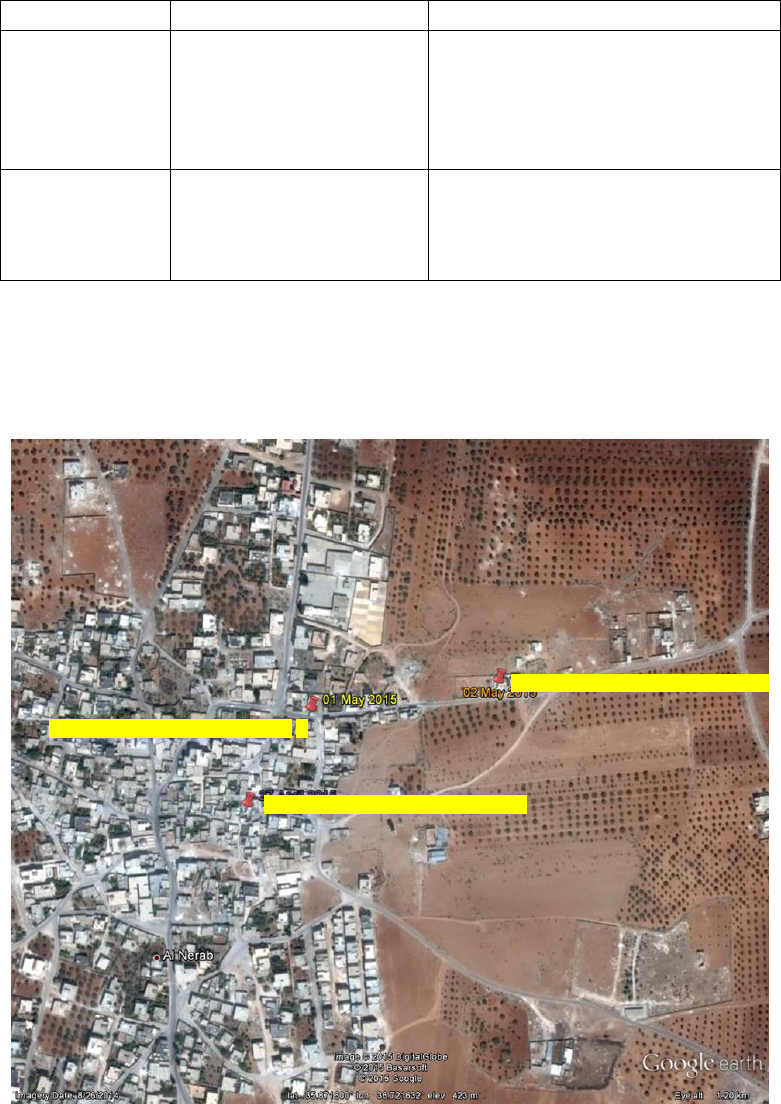
S/1319/2015
Annex 2
page 62
Date Approximate time Weather conditions
1 May 2015
Evening before
midnight (no accurate
indication of time)
Temperature was around 18°C
with 64% to 77% humidity. The
wind direction was changing
between WSW and SSW at 8 to
3 m/s.
2 May 2015 Around 04:30
The temperature was around
15°C; humidity was 80%. In the
early morning, the wind direction
was SW with a velocity of 4 m/s.
3.107 The figure below shows the approximate alleged impact points of the devices,
as derived from the interviewees.
FIGURE 22: ALLEGED IMPACT POINTS IN AL-NERAB
Narrative
3.108 Al-Nerab was not under the control of the government in April and May 2015.
3.109 Although there were no direct witnesses to the actual events among the
interviewees, the FFM team was able to collect information from the first
responders regarding some of the casualties, including two fatalities from the
Impact point, 27 April 2015, Al-Nerab
Impact point, 02 May 2015, Al-Nerab
Impact point, 01 May 2015, Al-Nerab
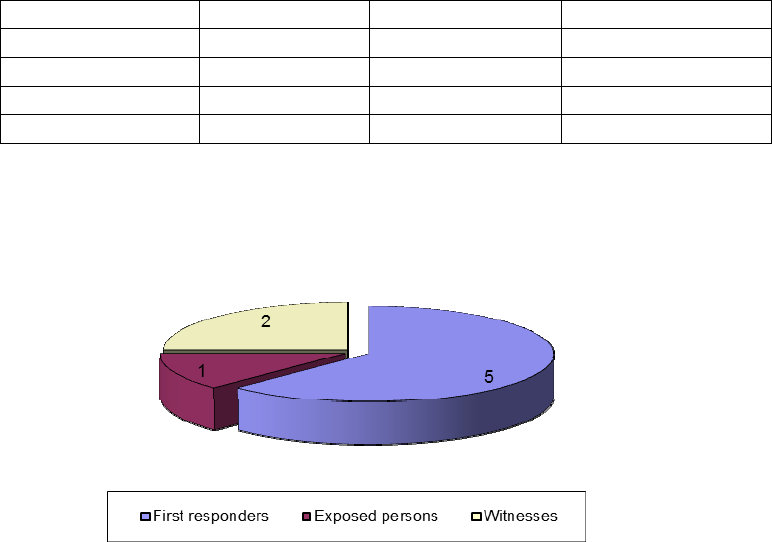
S/1319/2015
Annex 2
page 63
alleged incident of 2 May. One responder who visited the 2 May site after
transporting victims to the Sarmin field hospital, and two witnesses who
visited the impact point a few days later, had given information about the
munition, which reportedly impacted in front of the residence of the two
casualties who died. These interviewees described barrel fragments,
light-green-coloured refrigerant cylinders, and plastic bottles among the
remnants, as well as a strong smell of chlorine, discolouration of nearby
vegetation, and burn marks on the outside wall of the house.
3.110 The alleged incidents of 27 April and 1 May were also reported to have
occurred in residential neighbourhoods. Responders similarly reported
smelling a strong odour of chlorine and seeing remnants similar to those
described above. One witness reported that he poured water over one of the
plastic bottle remnants and that the water turned red.
Epidemiological analysis
3.111 Between 23 May and 5 June 2015, the FFM interviewed eight individuals; six
of the interviewees were first responders, one of whom claimed that he was
exposed, and two interviewees had visited the impact point a few days after
the incidents. As the individuals who were interviewed were in fact in Sarmin
during the attack, the information received about the incident was not first
hand.
3.112 The details of these interviewees are given in the table below.
TABLE 21: RELATION TO THE INCIDENT IN AL-NERAB AND
GENDER DISTRIBUTION OF INTERVIEWEES
Interviewee Male Female
First responders 5 5 0
Exposed person 1 1 0
Witnesses 2 2
Total 8 8 0
FIGURE 23: DISTRIBUTION OF INTERVIEWEES IN RELATION
TO THE INCIDENT IN AL-NERAB

S/1319/2015
Annex 2
page 64
3.113 The information reported 12 casualties resulting from all three alleged
incidents, including two cases of death: a father and his baby from the incident
on 2 May 2015. It was reported that the baby was found dead at the scene,
and the father died a few days later in a hospital near the border. The signs
observed by the first responder included coughing, difficulty breathing, and
tearing.
Biomedical samples
3.114 For all alleged incidents in Al-Nerab reported above, only two biomedical
samples had been taken. The samples were blood and hair taken from the
dead baby.
3.115 The FFM team received the sample (blood and hair) from the CVDCS on
22 May 2015. The quantity of blood and hair was not enough to perform a
screening analysis; therefore, the laboratory was tasked with screening the
environmental samples first and preserving the biomedical sample for a
specific tracer in the light of the results. The environmental sample analysis
result did not offer any lead with respect to an organic or/and inorganic tracer
or their metabolites that could be specific and not naturally occurring in the
human body. Therefore, no analysis was conducted on these two samples.
Environmental samples
3.116 No environmental samples were collected or received by the FFM team
related to the alleged incidents in Al-Nerab.
Saraqib
3.117 Saraqib is a city in the Idlib Governorate of the Syrian Arab Republic.
3.118 Between 23 May and 5 June 2015, the FFM interviewed six individuals who
provided information in relation to the alleged incidents in Saraqib, five of
whom were first responders and one an eyewitness (local media) with respect
to the alleged munition remnants; all were male.
3.119 Figure 24 below indicates the approximate alleged impact points of the
devices, as derived from the interviewees.
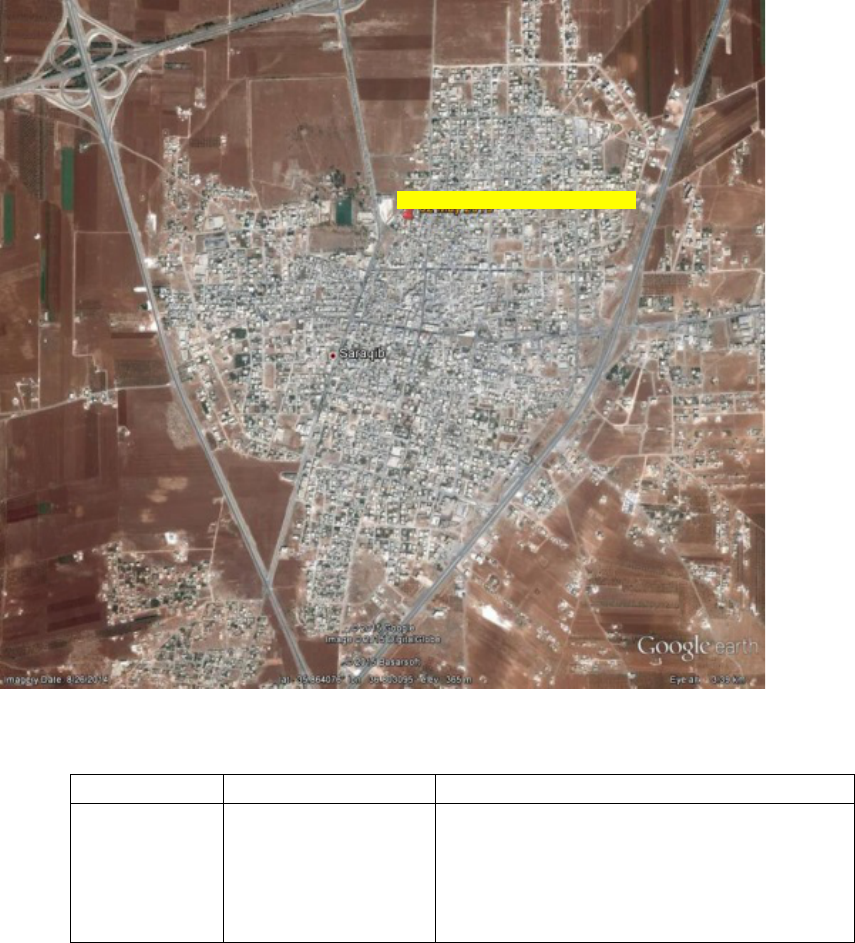
S/1319/2015
Annex 2
page 65
FIGURE 24: IMPACT POINT OF ALLEGED INCIDENT IN SARAQIB
TABLE 22: DETAILS OF THE INCIDENT IN SARAQIB
N
a
r
r
a
Narrative
3.120 Saraqib was not under the control of the government in May 2015.
3.121 The alleged incident in Saraqib with suspected toxic chemicals was on
2 May 2015. The individuals who were interviewed by the FFM team were in
fact in Sarmin during the incident. The interviewees reported to the FFM team
an approximate number of 70 chemical casualties. The signs observed by the
first responder during the rescue operation were coughing, difficulty
breathing, and tearing.
Date Approximate time Weather conditions
2 May 2015 Around 4:30
In the early morning of 2 May 2015, the
temperature in Saraqib was around 15°C,
humidity was 80%, and the wind
direction was south-west with a velocity
of 4 m/s.
Impact point, 2 May 2015, Saraqib

S/1319/2015
Annex 2
page 66
3.122 The information received about the incident was not first hand and the FFM
team could not cross-check this information from different sources such as
medical professionals, victims, casualties and direct witnesses.
3.123 One interviewee visited the scene approximately 20 minutes after the incident.
He reported a strong chemical smell, barrel remnants, refrigerant cylinders,
plastic bottles, and some chemical burning and discolouration of vegetation.
Biomedical samples
3.124 No biomedical samples were taken from the patients in relation to the alleged
incident in Saraqib on 2 May 2015.
Environmental samples
3.125 No environmental samples were collected or received in relation to the alleged
incident in Saraqib on 2 May 2015.
Kurin
3.126 Kurin is a village in the Idlib Governorate of the Syrian Arab Republic.
3.127 Only one interviewee made reference to an incident in Kurin; the interviewee
could not recall the date of the incident, but was able to give information about
the incident location.
3.128 Figure 25 below indicates the alleged approximate impact points of the
devices, as derived from the interviewees.

S/1319/2015
Annex 2
page 67
FIGURE 25: APPROXIMATE ALLEGED IMPACT POINT OF
DEVICE IN KURIN
Narrative
3.129 The interviewee claimed that in mid-April 2015 in the evening between 18:30
and 20:00, shortly after sunset, he was with five friends riding in a pick-up
truck close to Kurin. He heard a helicopter in the air, so the six of them took
cover. A moment later they heard the sound of something falling through the
air, followed by a light explosion. A few minutes later they continued moving
in the pick-up. As soon as they arrived in an area in Kurin, they smelled
“[c]hlorine. It was clear from its taste it was chlorine. It stuck to our mouths.”
They left the village quickly and washed their faces and mouths with water.
3.130 The FFM team could not cross check this information from other sources.
MUNITIONS
3.131 The FFM team collected information regarding the alleged chemical item or
munition during the interviews. The interviewees referred to the alleged
items/munitions as “barrel bombs”. Several of the interviewees described the
remnant of the munition and some of them also provided pictures. The FFM
team also received parts of the munitions as samples. Additionally, the team
also found many pictures of alleged items/munitions in open sources, which
bore resemblance to descriptions provided by interviewees.
3.132 Initially, the team studied the media footprints where the improvised chemical
munitions were reportedly used. As interviews progressed, more information
Impact point, mid-April 2015, Kurin
S/1319/2015
Annex 2
page 68
was obtained from a number of persons who were interviewed in their
different capacities as victims, witnesses, first responders, and medical
personnel. Their testimonies were correlated with the various types of
evidences provided to the team by the interviewees, with the social media
videos and pictures, with the samples handed over to the team and with the
information collected from various other open sources.
3.133 Based on the information collected by the FFM team, samples, pictures, and
descriptions of the items by the witnesses, the following are key common
features:
(a) an outer shell (barrel) designed to contain a number of metallic and
plastic cylinders;
(b) a number of metallic cylinders of various shapes and sizes that could
be filled with chemical compounds;
(c) multiple plastic bottles;
(d) detonation cord or an explosive mixture;
(e) ordinary time fuse; and
(f) multiple and various connectors that hold the components together.
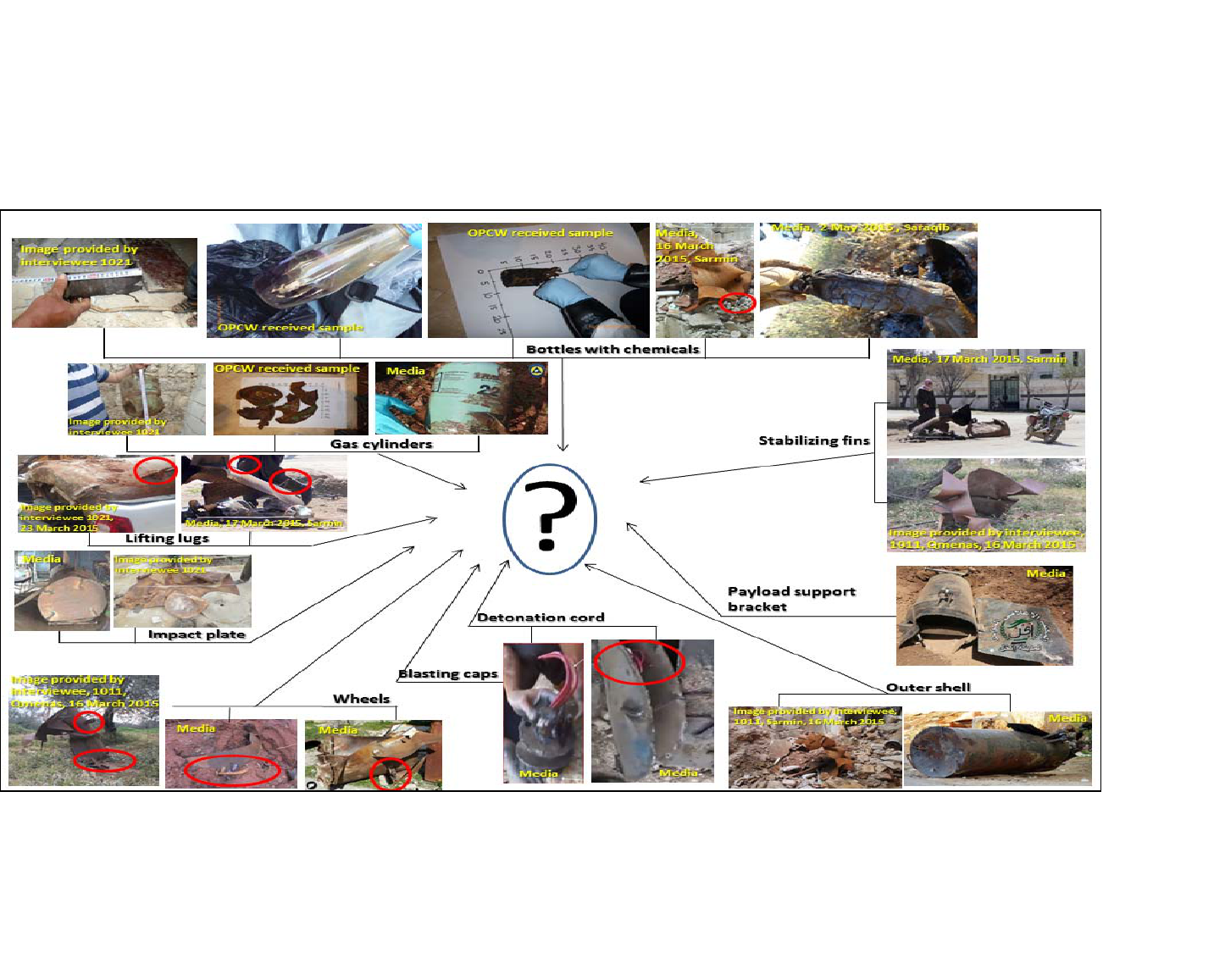
S/1319/2015
Annex 2
page 69
FIGURE 26: ALLEGED REMNANTS OF CHEMICAL MUNITIONS, DERIVED FROM DIFFERENT
SOURCES
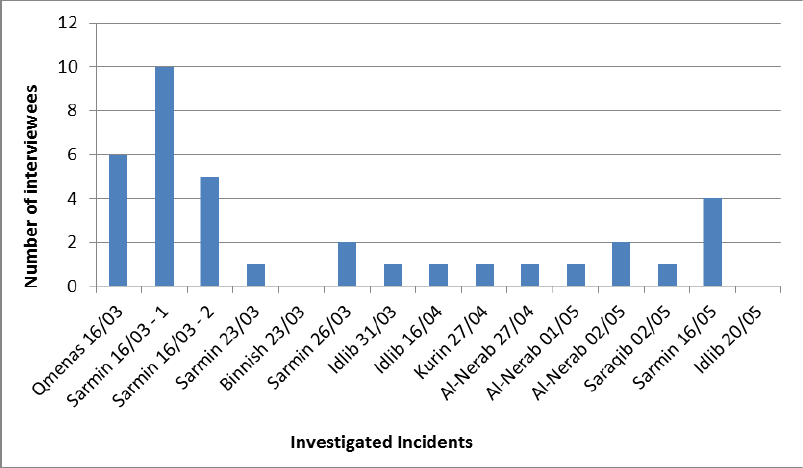
S/1319/2015
Annex 2
page 70
3.134 From the 24 interviewees, 16 interviewees offered relevant data regarding the
remnants of improvised chemical bombs allegedly used during the
investigated incidents. Figure 27 below shows the distribution of interviewees
with respect to the different incidents.
FIGURE 27: DISTRIBUTION OF INTERVIEWEES WITH RESPECT
TO THE ALLEGED INCIDENTS

S/1319/2015
Annex 2
page 71
OVERALL ANALYSIS OF THE INFORMATION COLLECTED
Epidemiological analysis of the incidents
3.135 For logistical and security considerations, the interviewees were transported to
the interview location in Country X in three groups:
(a) The first group totalled 11 interviewees, all of whom were interviewed.
(b) The second group totalled nine interviewees, all of whom were
interviewed.
(c) The third group totalled 10 interviewees, of whom only three were
interviewed (30%).
3.136 Seven interviewees from the original selection were unable to join the group.
TABLE 23: DISTRIBUTION OF THE INTERVIEWEES BY AGE
AND GENDER
Age group Male Female Total
20 years 2 2
21 to 30 years 11 1 12
31 to 40 years 6 6
41 to 50 years 2 1 3
51 to 60 years 1 1
Total 22 2 24
FIGURE 28: DISTRIBUTION OF INTERVIEWEES BY AGE
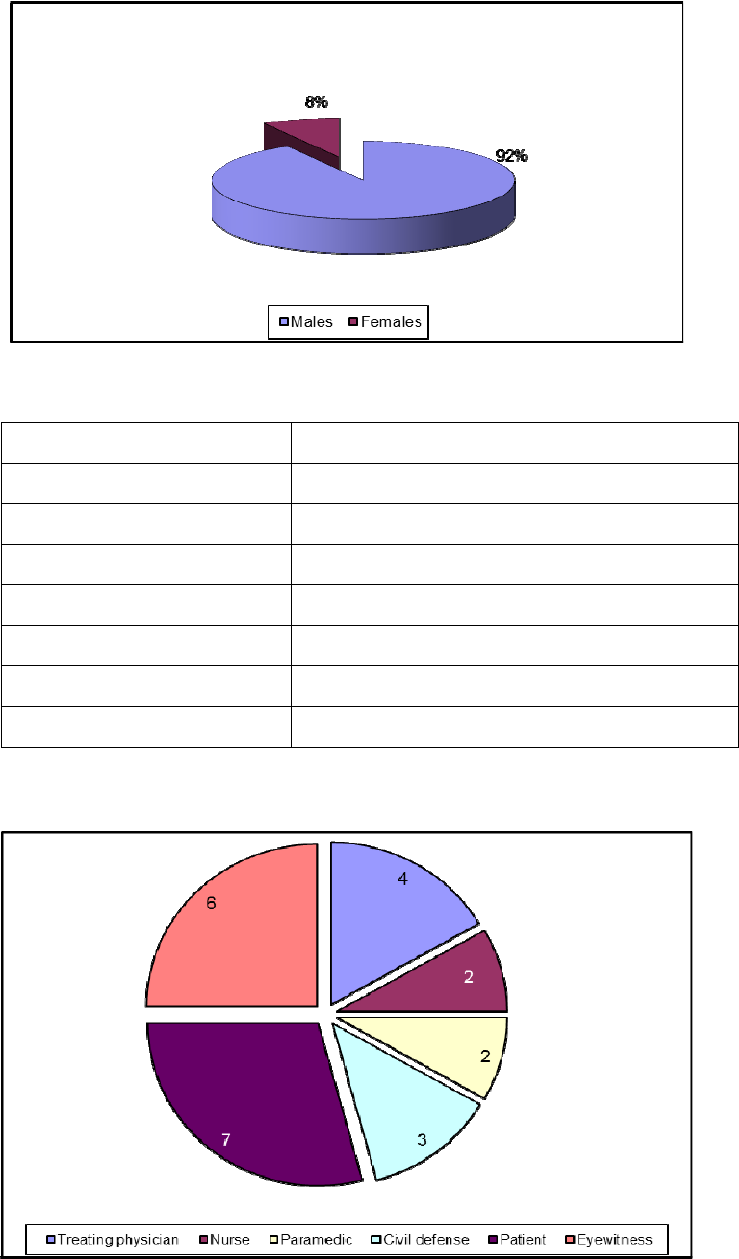
S/1319/2015
Annex 2
page 72
FIGURE 29: DISTRIBUTION OF INTERVIEWEES BY GENDER
TABLE 24: DISTRIBUTION OF INTERVIEWEES IN RELATION
TO THE INCIDENTS
Relation to the incident Number
Treating physician 4
Nurse 2
Paramedic 2
Civil defence 3
Patient 7
Eyewitness 6
Total 24
FIGURE 30: DISTRIBUTION OF INTERVIEWEES IN RELATION
TO THE INCIDENTS
S/1319/2015
Annex 2
page 73
3.137 In carrying out the analysis, the team noted the following in particular:
(a) The FFM compiled data that emerged from the testimonies of
interviewees.
(b) The relation of the interviewees to the incidents was frequently
interchangeable; some first responders and medical personnel were
considered as having been exposed and some of the interviewees were
present at more than one incident.
(c) Of a total of 24 interviewees, 21 described smelling an odour during
the course of one or more of the alleged incidents. Eighteen of these
described smelling the distinctive odour of a chlorine-like substance,
similar to cleaning products but much stronger; three described a
strong and repulsive odour.
(d) All medical staff, from ambulance drivers to treating physicians,
mentioned a large number of patients documented in different hospitals
at which they sought medical aid.
(e) When transporting patients or providing aid to them, some of the
medical staff and first responders suffered from some symptoms of
exposure.
(f) A few were affected by the intense smell of chlorine emanating from
the clothes of people who were exposed during an incident. It should
be noted that patients were decontaminated with water or soap and
water before being brought inside the hospital.
Medical signs, symptoms, and treatment
3.138 The symptoms of exposure, the signs observed by the treating physicians, and
the treatment that was provided to patients, in addition to the symptoms based
on interviewees’ testimonies, are discussed below.
3.139 All interviewees who declared having been exposed to toxic chemicals are
reported here. These include the seven patients and five first responders /
nurses exposed (a total of 12 individuals exposed).
3.140 Some symptoms are grouped together. The range experienced by the patients
as a result of suspected exposure to toxic chemicals included coughing,
shortness of breath, tearing and burning sensation in the eyes, burning
sensation on exposed skin, nausea/vomiting, disorientation, and loss of
consciousness.
3.141 The clinical examination reported by the treating physician included coughing,
difficulty breathing, and tearing.
3.142 The severity of symptoms varied and depended on the duration of exposure
and the age of the patient.
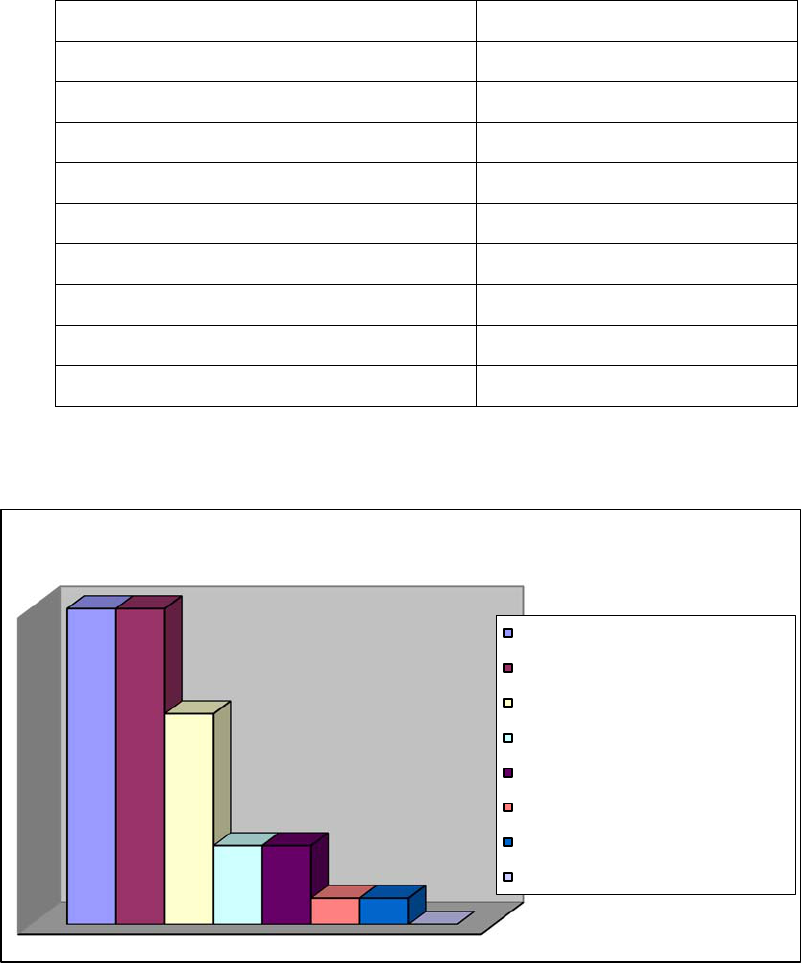
S/1319/2015
Annex 2
page 74
TABLE 25: FREQUENCY DISTRIBUTION OF THE REPORTED
SYMPTOMS BY THE CASUALTIES WHO PROVIDED
THEIR TESTIMONY
Symptom Frequency of Occurrence
Coughing 12
Shortness of breath/difficulty breathing 12
Tearing, burning sensation in eyes 8
Burning sensation on exposed skin 3
Nausea/vomiting 3
Disorientation 1
Loss of consciousness 1
Physical injuries 0
Total 12
FIGURE 31: FREQUENCY OF OCCURRENCE OF SIGNS AND
SYMPTOMS
12 12
8
33
1
1
0
Coughing
Shortness of breath/difficulty breathing
Tearing, burning sensation in eyes
Burning sensation on exposed skin
Nausea/vomiting
Disorientation
Loss of consciousness
Physical injuries
3.143 Cumulatively, 12 of 12 experienced coughing, 12 of 12 had shortness of
breath, 8 of 12 experienced burning in the eyes and tearing, 3 of 12
experienced a burning sensation on exposed skin, 1 of 12 had nausea or
vomiting, and 1 of 12 lost consciousness.
3.144 There is no discordance between the two sources of information because for
the patients the main symptoms were difficulty breathing and severe coughing.
The other symptoms were reported as secondary, mild symptoms, but
nonetheless are recorded in this document.
S/1319/2015
Annex 2
page 75
3.145 The respiratory symptoms among patients appeared almost immediately after
exposure to the suspected toxic chemicals and persisted for a few hours or, in
some cases, for a few days. The cough was non-productive in the majority of
cases, which is a result of irritation of the upper respiratory tract and the
constitution of bronchospasm. No cases of productive cough or haemoptysis
were observed.
3.146 As reported by the treating physicians, a large number of patients presented in
a state of panic. This could be attributed to the psychological effects of living
in a conflict area.
3.147 The treatment provided included oxygen therapy, application of intravenous
fluids, and steroid therapy.
3.148 The mainstay of treatment provided was oxygen, which provided relief to
patients within minutes. Oxygen relieves hypoxia in exposed patients and
calms those who are in state of panic, thus bringing immediate relief.
3.149 The use of bronchodilators relaxes constricted airways, thus improving
oxygenation and relieving symptoms. The efficacy of steroids is not proven.
3.150 The use of intravenous fluids is of more value in providing quick access to the
peripheral vessels for intravenous drug administration. Moreover, in cases of
pulmonary oedema, administration of fluids has to be carefully justified and
weighed.
3.151 The outcome of exposure was fatal in six cases in Sarmin and two in
Al-Nerab. In the alleged incident in Sarmin, three died immediately and three
later on the same night in Sarmin hospital. All these individuals were from the
same family and very close to the impact site. In the Al-Nerab incident, one
died at the scene of impact and the other three days later.
3.152 The hospitals at all locations in question are equipped with minimal medical
equipment, thus the treating physicians did not take any blood tests, perform
radiographs, etc.
Evaluation of Samples
3.153 None of the samples were collected by the FFM team. A total of 24 samples
were handed over to the FFM team by the CVDCS. The samples were
received by the FFM team on two different dates; the first set of samples was
received by the team on 22 May 2015 and the second set of samples was
received on 23 July 2015. According to interviewees’ statements, the samples
were originally collected by the interviewees and were held in a separate
location within Sarmin, then handed over to the CVDCS.
3.154 The OPCW FFM team ensured the chain of custody of these samples from the
moment of receipt by following the procedure described in the methodology
section (Section 2) of the current report. The described procedure was applied

S/1319/2015
Annex 2
page 76
for all samples starting from the moment of receipt to the handover of these
samples to the OPCW designated laboratory.
3.155 Some of the received samples were accompanied by partial documentation of
the chain of custody prior to delivery to the FFM. Although this
documentation provided some degree of confidence, the entire chain of
custody could not be verified, thus the possibility of cross-contamination
could not be ruled out. Therefore, although such samples would be considered
as primary evidence under optimal circumstances, given the constraints as
described, the FFM regarded the samples as tertiary evidence. As such, the
results from such analyses were treated more as supporting information than
as having significant evidential value. Therefore, it was decided that the
splitting of samples for analysis at a second laboratory did not warrant the
efforts, including cost, and impact on the designated laboratory as well as on
OPCW staff.
TABLE 26: LIST OF SAMPLES
Date
OPCW evidence
reference
number
OPCW
sample
code
Sample description Location
22/05/2015 20150522102801 01SLS
Soil sample collected
from the impact point
of a barrel bomb
4
Kafr Zita
22/05/2015 20150522102802 02SLS
Soil sample collected
from the impact point
of a barrel bomb,
3
the
soil was coloured
purple after the
attack,
3
48 hours later
the colour had
returned to normal
Kafr Zita
22/05/2015 20150522102803 03AQS
Purple aqueous
solution
Kafr Zita
22/05/2015 20150522102804 04SDS
Empty HCFC
container
Kafr Zita
22/05/2015 20150522102805 05SDS
Empty HCFC
container
Sarmin
22/05/2015 20150522102806 06SDS
Black/brown plastic
container + dark red
powder
Kafr Zita
22/05/2015 20150522102807 07SDS
Black/brown plastic
container
Sarmin
4
Terminology is as provided by interviewees.

S/1319/2015
Annex 2
page 77
Date
OPCW evidence
reference
number
OPCW
sample
code
Sample description Location
22/05/2015 20150522102808 08SDS
Ruptured HCFC
container
Sarmin
22/05/2015 20150522102809 09SDS Clothes from a victim Sarmin
22/05/2015 20150522102810 N/A
Blood and hair
sample
Al-Nerab
22/05/2015 20150522102811 11SDS
Ruptured HCFC
container
Sarmin
22/05/2015 20150522102812 12SDS
Ruptured HCFC
container
Sarmin
23/07/2015 20150723100801 13SDS
One key and one
teaspoon
Sarmin
23/07/2015 20150723100802 14SDS
Level float for water
tank
Sarmin
23/07/2015 20150723100803 15SDS Electrical light bulb Sarmin
23/07/2015 20150723100804 16SDS
Two pieces of
construction material
Sarmin
23/07/2015 20150723100805 17SDS
Part of an exploded
HCFC gas cylinder
Sarmin
23/07/2015 20150723100806 18SDS
Part of an exploded
HCFC gas cylinder
Sarmin
23/07/2015 20150723100807 19SDS Piece of wood Sarmin
23/07/2015 20150723100808 20SLS
Soil sample (sand and
stones)
Sarmin
23/07/2015 20150723100809 21SDS
Pieces of wood (and
plastic container)
Sarmin
23/07/2015 20150723100810 22SDS Plastic containers Sarmin
23/07/2015 20150723100811 23SDS Jacket of a victim Sarmin
23/07/2015 20150723100812 24SLS
Two soil samples
(sand and stones)
Taken from two
locations in Sarmin as
background samples
(blank samples)
Sarmin
S/1319/2015
Annex 2
page 78
3.156 After receiving the samples and the documentation, it became apparent that
five samples had been collected in Kafr Zita which is a city within the Hama
Governorate in the Syrian Arab Republic. As the current mandate is restricted
to the Idlib Governorate in the Syrian Arab Republic, in this report the team
will not include the analysis results of the following samples; 01SLS, 02SLS,
03AQS, 04SDS, and 06SDS. The FFM team will retain the analysis results
within the Secretariat, pending potential investigation of incidents outside this
mandate.
3.157 Considering the uncertainty around the potential chemical allegedly used and
how it might behave under unknown energetic conditions, and an
indeterminate period of time in uncontrolled environment, the FFM team
requested from the OPCW designated laboratory a large screening of organic
and inorganic chemical compounds and / or elements, not limited to scheduled
chemicals.
3.158 In this report, the results of 19 samples were considered:
(a) eleven samples (13SDS, 14SDS, 15SDS, 16SDS, 17SDS, 18SDS,
19SDS, 20SLS, 21SDS, 22SDS, and 23SDS) related to samples
collected from the house of the six dead victims of the alleged incident
of 16 March 2015 in Sarmin;
(b) six samples (05SDS, 07SDS, 08SDS, 09SDS, 11SDS and 12SDS)
related to different undefined alleged incidents in Sarmin other than
above-mentioned incident;
(c) one biomedical sample collected from the deceased child from the
alleged incident of Al-Nerab on 2 May 2015; and
(d) one background soil sample from Sarmin (consisting of two
subsamples from slightly different locations).
3.159 The 19 samples mentioned above may be categorised as follows:
(a) remnants of the alleged item or munition:
(i) metallic remnant: 05SDS, 08SDS, 11SDS, 12SDS, 17SDS and
18SDS; and
(ii) plastic remnant: 07SDS and 22SDS;
(b) environmental samples:
(i) soil, stones and construction materials: 13SDS, 14SDS, 15SDS,
16SDS, 19SDS, 20SDS, 21SDS and 24SLS; and
(ii) textiles and leather products: 07SDS and 23SDS; and

S/1319/2015
Annex 2
page 79
(c) biomedical samples: blood and hair evidence number:
20150522102810.
Chemical analysis results of the remnants of the alleged munition
Metallic material:
3.160 All the metallic parts of the remnants of the alleged munition received by the
FFM team consisted of a part or whole metallic cylinder. The cylinder bore the
markings for the refrigerant R22, a hydrochlorofluorocarbon (HCFC) and
liquefied gas, and was comparable to those commercially available.
3.161 A screening of the residual organic compound was performed by the OPCW
designated laboratory. The analysis was conducted on the external and the
inner side of the exploded or ruptured R22 cylinder for the following samples:
05SDS, 08SDS, 12SDS, 17SDS, and 18SDS. No organic compounds were
reported for the sample 17SDS. However, different concentrations of
trinitrotoluene (TNT) on the rest of samples clearly indicate the contamination
and /or the exposure of those samples to high-explosive materials.
3.162 In addition to the explosives footprint on those samples, different
concentrations of polyaromatic hydrocarbons (PAHs) were found in the
samples. Moreover, polychlorinated hydrocarbons (PCAHs,
hexachlorobenzene, octachloronaphthalene, and others) were detected in some
of those samples. It is possible that these chemicals were formed during the
combustion of organic material in presence of chlorine-containing chemicals.
3.163 The screening for inorganic compounds (including elements) reveals that
potassium and/or manganese were identified in all samples at different
concentrations and that the concentration of chloride was significantly higher
than normal in samples 05SDS, 08SDS, 17SDS, and 18SDS.
3.164 The concentration of chloride in the debris from the inside surface of the R22
container 18SDS (aliquot 18SDS-E2SI) was five times higher compared to the
outside surface (aliquot 18SDS-E2SO).
Plastic material:
3.165 The plastic material was identified as polyethylene terephthalate. The organic
compounds identified were the same as on the metallic remnants of the
munition.
3.166 Potassium and manganese were detected in both samples analysed in high
concentration; 1:1 stoichiometric ratios of potassium and manganese were
observed.

S/1319/2015
Annex 2
page 80
Chemical analysis results of the environmental samples
The screening for organic compounds shows the following:
3.167 Differing concentrations of TNT were found in the environmental samples.
Also, different concentrations of polyaromatic hydrocarbons (PAHs) were
detected. In addition, PCAHs (hexachlorobenzene, octachloronaphthalene, and
others) were detected in some samples. It is possible these chemicals were
formed during the combustion of organic chemicals in the presence of
chlorine-containing chemicals. Also, different plasticisers and oxidation
products of the antioxidant butylated hydroxytoluene (BHT) were identified.
3.168 Bornyl chloride was identified in wood sample 21SDS. According to the
literature,
5
bornyl chloride is a reaction product of hydrogen chloride with the
terpene-based wood ingredient -pinene. In order to show that bornyl chloride
is not naturally occurring, wood chips from a fir tree were extracted with
n-hexane. After analysis with GC-MS and GC-AED, -pinene but no bornyl
chloride was detected. In a further experiment, some fir tree chips were
exposed to (a) hydrogen chloride gas (HCl) and (b) chlorine gas (Cl
2
). After
extraction with n-hexane and analysis, significant amounts of bornyl chloride
were present in both extracts from experiments (a) and (b).
3.169 Consequently, the detected bornyl chloride in wood sample 21SDS is most
likely not of natural origin.
The screening for inorganics
3.170 Different concentrations of potassium and/or manganese (potassium
permanganate (KMnO
4)
, manganese oxide (MnO
2
)) were identified in all
samples. High concentrations of manganese were found in the dark coloured
debris on the electrical light bulb 15SDS, on the construction material piece
16SDS, and on the wood piece 19SDS. Using XRF analysis, almost
stoichiometric 1:1 ratios of potassium and manganese were found in the soil
sample 20SLS and the plastic containers 21SDS and 22SDS. This is
consistent with derivation from potassium permanganate (KMnO
4
).
3.171 High concentrations of chloride were identified in all samples. The
concentration of chloride in the extract of the soil sample 20SLS (aliquot
20SLS-E2) was between 70 and 700 times higher than the two soil samples
24SLS (aliquots 24SLS-E2A / 24SLS-E2B). Considering that sample 24SLS
is a background soil sample and it was taken more than three months after the
incident in Sarmin, there is strong evidence that sample 20SLS was exposed to
or contaminated by chloride.
5
Information supplied by the designated laboratory.

S/1319/2015
Annex 2
page 81
Biomedical samples
3.172 The biomedical samples received by the FFM team were approximately 1 to
1.5 ml of blood taken from the dead child in the Al-Nerab incident and a hair
sample taken from the same victim after decontamination. The quantity of
samples was not enough to perform a screening analysis; therefore, the
laboratory was tasked with screening the environmental samples first and
preserving the biomedical sample for specific tracer(s) in light of the results
for the environmental samples.
3.173 The environmental sample analysis result did not offer any lead with respect to
an organic and/or inorganic tracer or their metabolites that could be specific
and not occurring naturally in the human body. Therefore, no analysis was
conducted on these two samples.
Review of information on the munitions
3.174 Multiple open sources, videos, and media reports indicate that in the conflict,
conventional weapons have been supplemented with improvised weapons
derived from low cost containers filled with explosive, fuel, irregular shaped
steel fragments that have been referred to as “barrel bombs”. More recently,
reports have referred to barrel bombs containing chemicals.
3.175 The interest of the investigation team was focused on those improvised
ordnance that produced casualties by intoxication with an unknown chemical
that were allegedly used in Idlib region in the Syrian Arab Republic between
March and May 2015.
3.176 The testimonies of interviewees were correlated with the various types of
evidence provided to the team by the interviewees, with social media videos
and pictures, with the samples handed over to the team, and with the
information collected from various other open sources. Based on these inputs,
the following components have been determined:
(a) an outer shell (barrel) designed to hold inside a various number of
components including chemical cylinders;
(b) a number of cylinders potentially of various shapes and sizes filled
with chemical compounds (which are most probably gases or liquids);
(c) multiple plastic bottles filled with potassium permanganate;
(d) detonation cord or an explosive mixture designed to rupture the gas
cylinders and the plastic bottles;
(e) an ordinary time fuse consisting of a blasting cap and a time-calculated
fuse wick (fuse cord); and
(f) multiple and various connectors that hold the components together.
S/1319/2015
Annex 2
page 82
3.177 By piecing together these inputs, the modus operandi is that the barrel bomb
releases the toxic chemical compound(s) by using the detonation cord or an
explosive mixture to rupture the gas cylinders filled with toxic chemical, the
plastic bottles, and the outer shell. Improvised chemical barrel-bomb designs
that are observed through social media demonstrate that there is an evolution
of their manufacture, likely driven by trial and error. Open sources indicate
three generic constructions of the chemical barrel bomb. However, based on
all the inputs related to the mandate, only one type appears to have been used
in the Idlib region between March and May 2015.
3.178 Figure 32 below depicts this generic construction.
3.179 Figure 33 shows some of the evidence received by the team which helped
build the picture of the munition indicated in Figure 32.
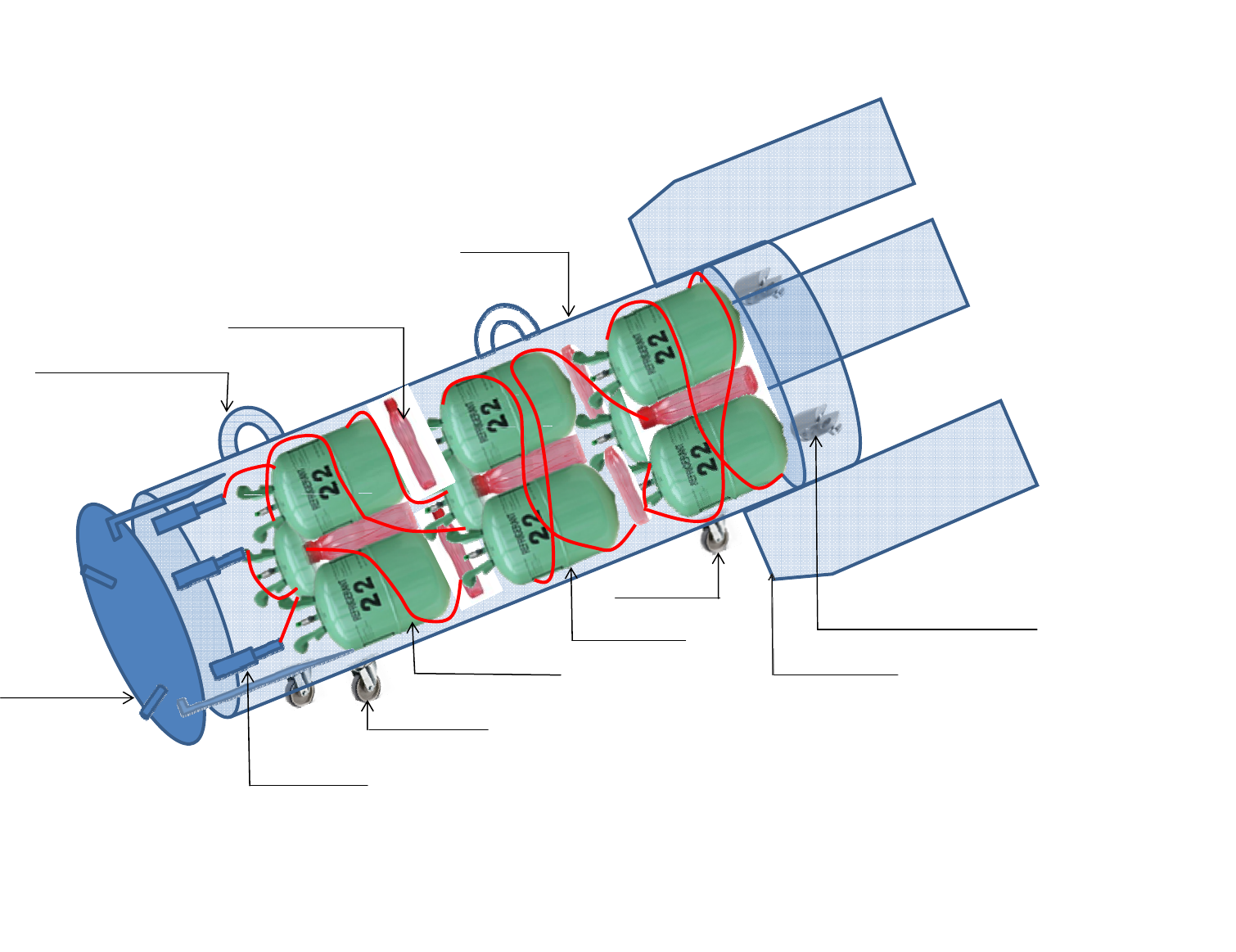
S/1319/2015
Annex 2
page 83
FIGURE 32: DEPICTION OF AN IMPROVISED CHEMICAL
MUNITION, ALLEGED TO HAVE BEEN USED
IN THE IDLIB GOVERNORATE BETWEEN
MARCH AND MAY 2015
L
L
i
i
f
f
t
t
i
i
n
n
g
g
l
l
u
u
g
g
s
s
B
B
l
l
a
a
s
s
t
t
i
i
n
n
g
g
c
c
a
a
p
p
s
s
I
I
m
m
p
p
a
a
c
c
t
t
p
p
l
l
a
a
t
t
e
e
D
D
e
e
t
t
o
o
n
n
a
a
t
t
i
i
o
o
n
n
c
c
o
o
r
r
d
d
P
P
a
a
y
y
l
l
o
o
a
a
d
d
s
s
u
u
p
p
p
p
o
o
r
r
t
t
b
b
r
r
a
a
c
c
k
k
e
e
t
t
S
S
t
t
a
a
b
b
i
i
l
l
i
i
s
s
i
i
n
n
g
g
f
f
i
i
n
n
s
s
F
F
r
r
o
o
n
n
t
t
W
W
h
h
e
e
e
e
l
l
s
s
G
G
a
a
s
s
c
c
y
y
l
l
i
i
n
n
d
d
e
e
r
r
B
B
o
o
t
t
t
t
l
l
e
e
w
w
i
i
t
t
h
h
c
c
h
h
e
e
m
m
i
i
c
c
a
a
l
l
s
s
B
B
a
a
c
c
k
k
W
W
h
h
e
e
e
e
l
l
O
O
u
u
t
t
e
e
r
r
s
s
h
h
e
e
l
l
l
l
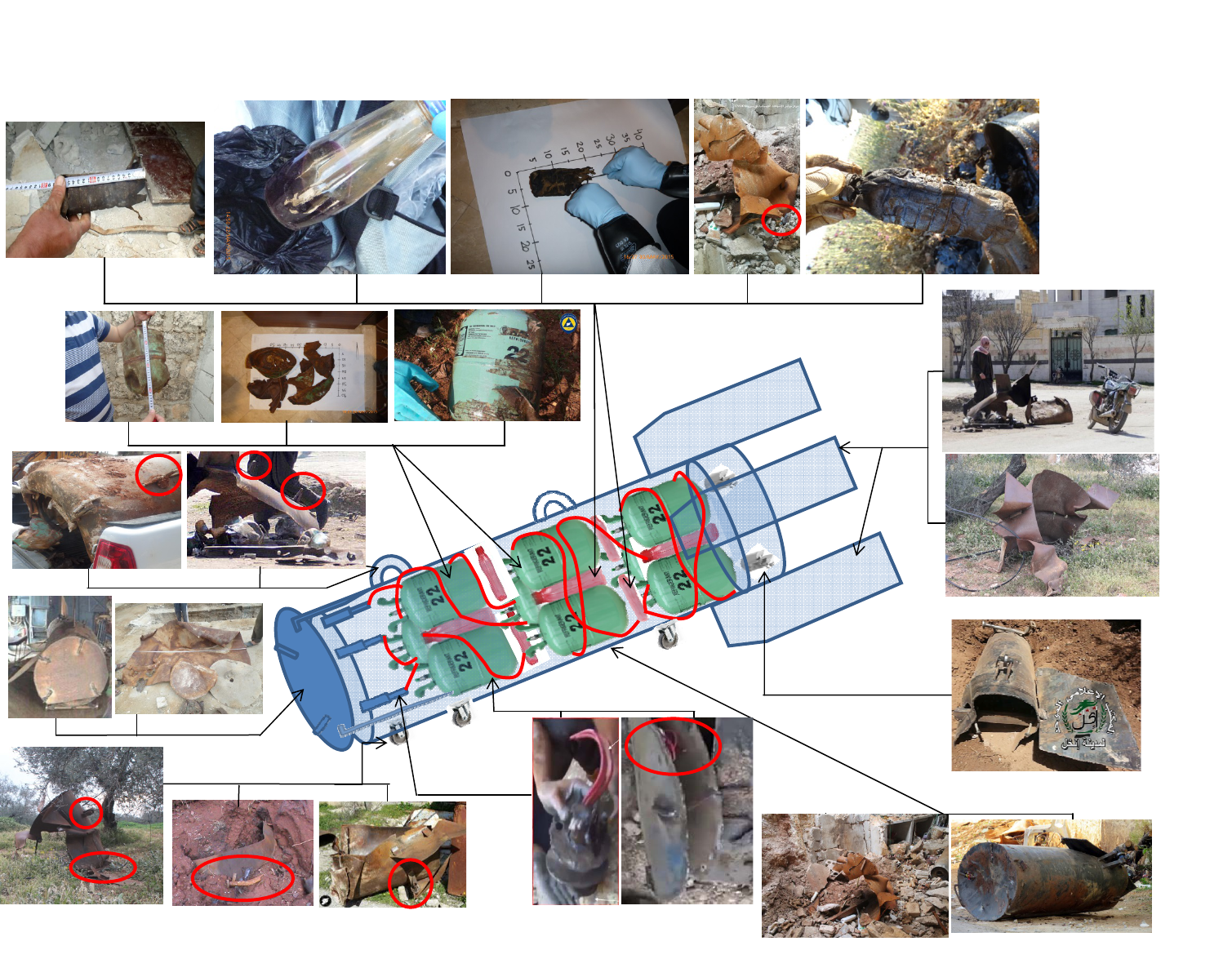
S/1319/2015
Annex 2
page 84
FIGURE 33: EVIDENCE AND INFORMATION RECEIVED BY THE FFM TO ENABLE DEPICTION OF THE DEVICE
L
L
i
i
f
f
t
t
i
i
n
n
g
g
l
l
u
u
g
g
s
s
B
B
l
l
a
a
s
s
t
t
i
i
n
n
g
g
c
c
a
a
p
p
s
s
I
I
m
m
p
p
a
a
c
c
t
t
p
p
l
l
a
a
t
t
e
e
D
D
e
e
t
t
o
o
n
n
a
a
t
t
i
i
o
o
n
n
c
c
o
o
r
r
d
d
P
P
a
a
y
y
l
l
o
o
a
a
d
d
s
s
u
u
p
p
p
p
o
o
r
r
t
t
b
b
r
r
a
a
c
c
k
k
e
e
t
t
S
S
t
t
a
a
b
b
i
i
l
l
i
i
s
s
i
i
n
n
g
g
f
f
i
i
n
n
s
s
W
W
h
h
e
e
e
e
l
l
s
s
G
G
a
a
s
s
c
c
y
y
l
l
i
i
n
n
d
d
e
e
r
r
s
s
B
B
o
o
t
t
t
t
l
l
e
e
s
s
w
w
i
i
t
t
h
h
c
c
h
h
e
e
m
m
i
i
c
c
a
a
l
l
s
s
M
M
e
e
d
d
i
i
a
a
,
,
1
1
6
6
M
M
a
a
r
r
c
c
h
h
2
2
0
0
1
1
5
5
,
,
S
S
a
a
r
r
m
m
i
i
n
n
O
O
P
P
C
C
W
W
r
r
e
e
c
c
e
e
i
i
v
v
e
e
d
d
s
s
a
a
m
m
p
p
l
l
e
e
M
M
e
e
d
d
i
i
a
a
M
M
e
e
d
d
i
i
a
a
M
M
e
e
d
d
i
i
a
a
,
,
2
2
M
M
a
a
y
y
2
2
0
0
1
1
5
5
,
,
S
S
a
a
r
r
a
a
q
q
i
i
b
b
M
M
e
e
d
d
i
i
a
a
O
O
P
P
C
C
W
W
r
r
e
e
c
c
e
e
i
i
v
v
e
e
d
d
s
s
a
a
m
m
p
p
l
l
e
e
M
M
e
e
d
d
i
i
a
a
,
,
1
1
7
7
M
M
a
a
r
r
c
c
h
h
2
2
0
0
1
1
5
5
,
,
S
S
a
a
r
r
m
m
i
i
n
n
M
M
e
e
d
d
i
i
a
a
,
,
1
1
7
7
M
M
a
a
r
r
c
c
h
h
2
2
0
0
1
1
5
5
,
,
S
S
a
a
r
r
m
m
i
i
n
n
O
O
P
P
C
C
W
W
r
r
e
e
c
c
e
e
i
i
v
v
e
e
d
d
s
s
a
a
m
m
p
p
l
l
e
e
I
I
m
m
a
a
g
g
e
e
p
p
r
r
o
o
v
v
i
i
d
d
e
e
d
d
b
b
y
y
i
i
n
n
t
t
e
e
r
r
v
v
i
i
e
e
w
w
e
e
e
e
1
1
0
0
2
2
1
1
I
I
m
m
a
a
g
g
e
e
p
p
r
r
o
o
v
v
i
i
d
d
e
e
d
d
b
b
y
y
i
i
n
n
t
t
e
e
r
r
v
v
i
i
e
e
w
w
e
e
e
e
,
,
1
1
0
0
1
1
1
1
,
,
Q
Q
m
m
e
e
n
n
a
a
s
s
,
,
1
1
6
6
M
M
a
a
r
r
c
c
h
h
2
2
0
0
1
1
5
5
I
I
m
m
a
a
g
g
e
e
p
p
r
r
o
o
v
v
i
i
d
d
e
e
d
d
b
b
y
y
i
i
n
n
t
t
e
e
r
r
v
v
i
i
e
e
w
w
e
e
e
e
1
1
0
0
2
2
1
1
I
I
m
m
a
a
g
g
e
e
p
p
r
r
o
o
v
v
i
i
d
d
e
e
d
d
b
b
y
y
i
i
n
n
t
t
e
e
r
r
v
v
i
i
e
e
w
w
e
e
e
e
1
1
0
0
2
2
1
1
,
,
2
2
3
3
M
M
a
a
r
r
c
c
h
h
2
2
0
0
1
1
5
5
O
O
u
u
t
t
e
e
r
r
s
s
h
h
e
e
l
l
l
l
I
I
m
m
a
a
g
g
e
e
p
p
r
r
o
o
v
v
i
i
d
d
e
e
d
d
b
b
y
y
i
i
n
n
t
t
e
e
r
r
v
v
i
i
e
e
w
w
e
e
e
e
,
,
1
1
0
0
1
1
1
1
,
,
S
S
a
a
r
r
m
m
i
i
n
n
,
,
1
1
6
6
M
M
a
a
r
r
c
c
h
h
2
2
0
0
1
1
5
5
I
I
m
m
a
a
g
g
e
e
p
p
r
r
o
o
v
v
i
i
d
d
e
e
d
d
b
b
y
y
i
i
n
n
t
t
e
e
r
r
v
v
i
i
e
e
w
w
e
e
e
e
1
1
0
0
2
2
1
1
M
M
e
e
d
d
i
i
a
a
M
M
e
e
d
d
i
i
a
a
M
M
e
e
d
d
i
i
a
a
M
M
e
e
d
d
i
i
a
a
M
M
e
e
d
d
i
i
a
a
I
I
m
m
a
a
g
g
e
e
p
p
r
r
o
o
v
v
i
i
d
d
e
e
d
d
b
b
y
y
i
i
n
n
t
t
e
e
r
r
v
v
i
i
e
e
w
w
e
e
e
e
,
,
1
1
0
0
1
1
1
1
,
,
Q
Q
m
m
e
e
n
n
a
a
s
s
,
,
1
1
6
6
M
M
a
a
r
r
c
c
h
h
2
2
0
0
1
1
5
5
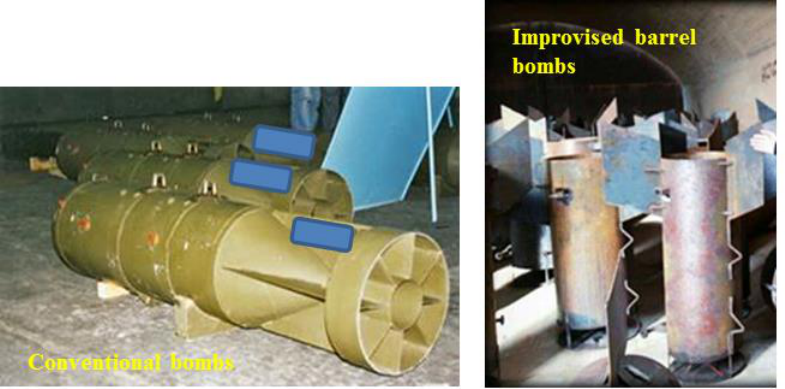
S/1319/2015
Annex 2
page 85
3.180 The remnants of the chemical improvised explosive devices show the
characteristics and design of air bombs. Almost all of the remaining outer
shells have three big metallic stabilising fins welded on the back. In more
conventional weaponry, the role of the fins is to stabilise the entire ensemble
during its flight/dive from the launching moment until it reaches the target by
keeping the bomb nose-down during its descent. The process of stabilisation is
necessary for improving the accuracy of the targeting process and to decrease
the rate of fail. Without stabilising fins, bombs would tumble through the air
and thus increase the probability of the fuse not hitting the ground and thus
decrease the likelihood of detonation. Typically, conventional bombs are
designed with at least four stabilising fins. The improvised ones, however,
appeared to have only three.
3.181 Figure 34 below is from an open source and depicts the different appearances
of improvised bombs versus more conventional types, particularly with respect
to the number of fins. These are merely used to indicate these differences, with
no implication of their being at all chemical in nature.
FIGURE 34: CONVENTIONAL (LEFT) AND IMPROVISED AIR BOMBS
(RIGHT) FINS DESIGN
3.182 It is hypothesised that the rationale behind three stabilising fins and no more
could derive from practicality of deployment, as follows. For easier transport,
the improvised chemical air bombs were designed with a transport train
comprising two wheels in the front and one on the back of the bomb. These
wheels would facilitate the conveyance of an improvised device in
transportation that may not be designed for such purposes. The three stabilising
fins provide a relatively low-cost technical solution that facilitates both the use
of the wheels and provides stabilisation. Furthermore, some of the social media
sources show improvised bombs loaded into a helicopter. The internal design
of helicopter and the launching procedures shown on social media create
practical difficulties in handling a bomb designed with four fins. See Figure 35
below.
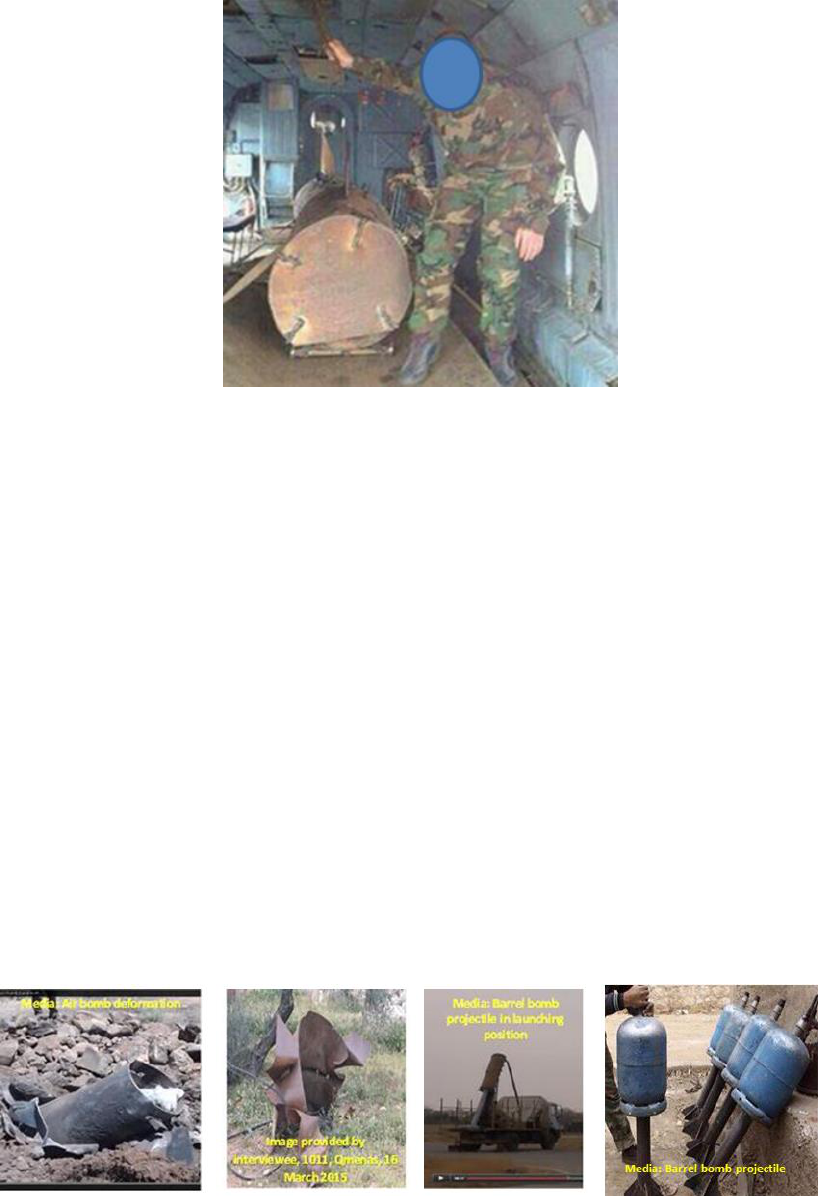
S/1319/2015
Annex 2
page 86
FIGURE 35: PICTURE FROM SOCIAL MEDIA SHOWING TWO
IMPROVISED BOMBS FITTED INTO A HELICOPTER
3.183 Further evidence of the improvised bombs being dropped from a height is the
deformation of the outer shell. In almost all cases that the team studied, the
impact damage can be seen in the front part of the bomb or on the side. The
deformation indicates that the device was launched from a height and the
impact was frontal (when stabilised by fins) or on the side (without
stabilisation). Both cases suggest that the object followed a free-fall trajectory.
3.184 In no cases did remnants suggest the presence of the following:
(a) an engine, as in the case of a land-launched projectile; or
(b) an energetic component that would usually be used to transport the
projectile from the launching system to the target.
3.185 Furthermore, it is estimated that the size of the improvised chemical bomb
would be too great to be launched from a terrestrial artillery type of weapon.
3.186 A comparison of aerial and terrestrial projectiles and rockets can be seen in
Figure 36 below.
FIGURE 36: PICTURES FROM MEDIA SHOWING THE DEFORMATION
AND REMNANTS OF AIR BOMBS AND ROCKETS
Media: Air Bomb Deformation Image by Interviewee
1011: Qmenas 16 March
2015
Media: Barrel Bomb
Projectile in Launching
Position
Media: Barrel Bomb
Projectile

S/1319/2015
Annex 2
page 87
3.187 The impact point (the crater) and the fact that the outer shell and internal
components can be clearly visible (large pieces of remnants) confirm that
impacts of the improvised air bombs in the alleged incidents did not involve a
large amount of high explosive. If so filled, the bomb would have fragmented
all the bomb components into very small pieces. That is not the case in the
incidents assessed, where the most of the bomb components were found in
large pieces. Similarly, the crater produced by a high-explosive bomb would
have been bigger in diameter and deeper. For comparison, see Figure 37
below.
FIGURE 37: PICTURES FROM OPEN-SOURCE MEDIA (LEFT) AND
PROVIDED BY AN INTERVIEWEE (RIGHT) SHOWING
THE CRATER FORMED FOLLOWING THE DETONATION
OF A HIGH EXPLOSIVE IMPROVISED BOMB AND AN
IMPROVISED CHEMICAL BOMB
Media: Barrel Bomb High Explosive Crater Image by Interviewee 1011: Qmenas, 16 March 2015
3.188 In principle, a bomb designed to be used as chemical bomb is designed such
that the explosive train should only crack the walls of containers containing
toxic chemicals. A greater quantity of explosive would destroy the toxic
chemical by burning it. In addition, the use of a greater quantity of explosive to
spread the toxic chemicals would decrease the concentration on the targeted
area and potentially render the effects harmless.
3.189 In addition to the indications of these being chemical devices, there is also
evidence indicating that they are a binary type, where two chemicals react to
produce what would be a more effective chemical weapon. Within the outer
container (“barrel”), there are two different smaller types of container, one
being designed to hold a liquefied gas (R22), the other being a plastic bottle,
typical of the type that would hold drinks. The presence of a detonation cord
wrapped around these two smaller containers would rupture the containers,
allowing the mixing and subsequent reaction of the different chemical
components.
3.190 In almost all of the cases there is a visible metallic brim and two large bolts on
the rear side of the outer shell, suggesting an improvised device designed to
hold in place the inner containers during both transport and deployment. In
case of a binary chemical bomb, without this system, on impact, the inner
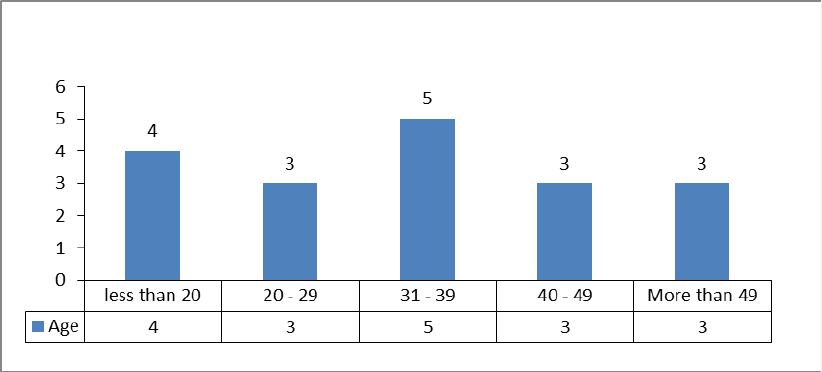
S/1319/2015
Annex 2
page 88
containers loaded inside the barrel bomb would be thrown outside due to
inertial forces before the chemicals could be released, enabling them to mix and
react. In the case of an improvised bomb filled with containers containing one
single toxic chemical, on impact the barrels will be pushed outside and spread
around the target, without the need to contain them in order to facilitate a
reaction.
4. WITNESSES IDENTIFIED BY THE SYRIAN ARAB REPUBLIC
4.1 During meetings held from 21 to 23 March 2015, representatives from the
Secretariat requested that the Syrian Government share any information
possible within its purview related to the recent alleged incidents in the Idlib
Governorate. In letters dated 7 April and 13 May 2015, the Director-General
reiterated these requests. During meetings that took place from 12 to
15 July 2015, the Syrian authorities stated that some persons who had been
displaced from northern regions of the Syrian Arab Republic were willing and
available to be interviewed, and that the Syrian Government could facilitate the
interviews. On 31 July 2015, the FFM-Bravo mandate was amended
accordingly, and the said interviews were conducted from 4 to 7 August 2015.
Twenty interviews were conducted with 18 interviewees.
4.2 The overall details of the interviewees are provided below.
FIGURE 38: AGE OF INTERVIEWEES (FFM-BRAVO, AUGUST 2015)

S/1319/2015
Annex 2
page 89
FIGURE 39: GENDER OF INTERVIEWEES (FFM-BRAVO,
AUGUST 2015
FIGURE 40: RESIDENCE AREA OF INTERVIEWEES (FFM-BRAVO,
AUGUST 2015)
4.3 The overall summary of the relevant information is as follows.
4.4 Seventy-eight percent (14 of 18) of the interviewees reported having no
awareness of any incident related to the suspected use of toxic chemicals as a
weapon having occurred in their area of residence.
4.5 Twenty-two percent (4 interviewees) informed the FFM about suspected cases
of chemical incidents. All reported cases of difficulty of breathing, coughing,
and ophthalmic signs. However, one was geographically and chronologically
outside the scope of the FFM mandate (Hama Governorate in 2014), two were
chronologically outside the scope of the mandate (referring to incidents in
2014), and one, based on the interviewee’s testimony, was deemed unlikely to
be the result of the use of toxic chemicals as a weapon.
4.6 As mentioned, one of the interviewees was from the Hama Governorate and
was not in the Idlib Governorate during the period in question. Therefore, the
testimony of this interviewee was deemed to be irrelevant to this particular
investigation. The statement of this interviewee indicated their having
S/1319/2015
Annex 2
page 90
witnessed an incident in Kafr Zita (Hama Governorate) in March or April 2014
or at the end of summer 2014, as described below.
4.7 Six more interviewees were from Al-Tamanah, Idlib Governorate. This
location is approximately 55 km south of the area described where the alleged
incidents were reported to have taken place by witnesses heard during the
interviews conducted by FFM-Alpha in May and June 2015. Therefore, their
testimony had little impact on the investigation of those particular incidents, as
none of the six interviewed by FFM-Bravo in August 2015 were in that locale
at the time. There were, however, alleged incidents in their area (Al-Tamanah)
in April and May 2014, and in April and June 2015, which were reported in
open sources. The alleged incidents in 2014 are outside the current mandate.
Nonetheless, the six interviewees who volunteered information on the subject
reported no knowledge of any chemical incidents. One reported having
received warnings to evacuate due to impending chemical attack around April
or May of 2014, but after returning home the next day, observed no evidence of
a chemical attack.
4.8 The alleged incidents of April and June 2015 in Al-Tamanah, however, are
within the mandate. None of these interviewees reported any information
related to these alleged incidents, and none of those interviewed by FFM-Alpha
were within 50 km of Al-Tamanah at that time. The team therefore has
insufficient information to make an assessment of these alleged incidents.
4.9 Two of the interviewees were from the village of Jesr Al-Chughur. This
location is approximately 40 km southwest of Idlib City, within the Idlib
Governorate. They reported no knowledge of any of the alleged incidents
described in the interviews conducted by FFM-Alpha in May and June 2015.
Similarly, they did not offer any information with regard to potential incidents
in Jesr Al-Chughur, alleged in open sources to have occurred in May 2015.
Furthermore, none of those interviewed by FFM-Alpha were within 40 km of
Jesr Al-Chughur at that time. The team therefore has insufficient information
to make an assessment of the alleged incidents in Jesr Al-Chughur.
4.10 The 11 remaining interviewees came from areas that were between
approximately 4.5 and 7 km from the areas of the nearest impacts reported
during the interviews conducted by FFM-Alpha in May and June 2015. As
such, their testimony was deemed potentially relevant to those incidents under
the FFM-Alpha mandate and was further analysed. Out of these 11
interviewees:
(a) Eight (73%) reported no knowledge of any incident involving
chemicals. However, one of these eight reported having received
warnings to evacuate due to impending chemical attack around April of
2015, but after returning home three days later, observed no evidence of
a chemical attack.
(b) One (9%) reported a suspected incident in Idlib City at approximately
12:00 on 28 March 2015, as described below. The incident was
S/1319/2015
Annex 2
page 91
determined by the team to be not likely involving the use of toxic
chemicals as a weapon.
(c) Two (18%) reported a suspected incident of the use of toxic chemicals
as a weapon in Idlib in 2014, as described below. According to their
testimony, these same two vacated Idlib City after 16 March 2015 and
prior to the reported dates of the alleged incidents in Idlib City, so were
not in the area at the time. The departure of these two interviewees
reduces to nine the number of potential witnesses in the area of the
reported incidents during the time period of concern.
4.11 The narratives given for each incident in the following paragraphs is derived
from interviews.
Kafr Zita, spring or summer 2014
4.12 Armed men fired a mortar canon as a helicopter passed overhead. Shortly
afterward, the interviewee and her family saw yellow and white smoke,
experienced difficulty breathing, and smelled a bad odour that they had not
experienced before. At hospital, they saw one casualty, a three-year-old girl
exhibiting laboured breathing, secretions, and cyanosis. The interviewee
described witnessing approximately one month later men in civilian clothes and
full-face respirators releasing gas from cylinders shortly after hearing an
announcement from a mosque minaret that a chemical attack was impending.
Further, the interviewee describes being taken to a base and witnessing men
filling cylinders with white powder. All of these incidents are outside the scope
of the mandate, however.
Idlib City, 28 March 2015
4.13 The interviewee reported an attack involving a nearby explosion in their
neighbourhood (Al-Thawra neighbourhood of Idlib City), estimated to be
approximately 30 m from their home. The explosion reportedly resulted in
structural damage and broken windows in all the buildings throughout the
neighbourhood, and generated a large volume of red dust and an unpleasant
odour. Immediately following exposure to the dust, the witness and their
family members experienced choking, coughing, eye irritation, and dizziness.
The witness was unable to associate the odour with any familiar odour. Further
questioning indicated the colour of the dust to be closer to light orange and
possibly similar to the local soil. Later during the interview, the witness
indicated that they witnessed no incidents related to chemical attacks, but had
observed reportedly strange behaviour from some neighbours on the day of the
described incident, in the form of gathering for discussions. Further
information that was given of a pre-existing prevalence of medical conditions
within the family, including asthma among others, could indicate that the
described symptoms were the result of a combination of the pre-existing
medical conditions being affected by a high volume of dust and psychological
trauma.
S/1319/2015
Annex 2
page 92
Idlib City, August 2014
4.14 Two interviewees reported that a projectile exploded in the Al-Amaliyeh
neighbourhood of Idlib City, approximately 10 m outside the bedroom of the
eldest daughter, who was most affected. Both interviewees described a
powerful explosion that shook the house, followed by a bad odour which they
could not associate with a familiar odour. They described symptoms of the
eldest daughter including coughing, a feeling of suffocating, tearing and
irritation of eyes, runny nose, drooling, and unconsciousness. She was treated
by her parents (both medical/emergency response professionals) with
resuscitation and a bronchodilator. Two other family members experienced
moderate coughing and throat irritation. Three other family members present
did not experience symptoms. Another daughter was wounded by shrapnel.
The residence incurred significant physical damage.
4.15 The testimony indicates the possibility of a chemical incident. However, the
incident described occurred between 8 and 20 August 2014, which is outside
the scope of the mandate.
S/1319/2015
Annex 2
page 93
5. CONCLUSIONS AND RECOMMENDATIONS
5.1 Much of the methodology section describes the manner in which the
investigation would have been carried out, had there been ideal circumstances
in which to do so. The inability of the team to visit the scene due to significant
security issues, however, created several deviations from the ideal. Thus, the
team could neither identify their own witnesses nor take their own samples.
Furthermore, the supportive value of correlating physical reality, such as visible
infrastructure, original records, and impact sites with information supplied by
interviewees was also not possible. The team therefore had to rely on
open-source information, interviewees identified and supplied by other entities,
samples (lacking full certainty of chain of custody) as made available by the
interviewees, and limited medical records.
5.2 It was in this context that the team had to glean the most benefit from available
sources and make an assessment of credibility.
5.3 Open-source media are by their very nature prone to the influences and
motivations of their authors, owners, and sponsors. While it is recognised that
some media sources may be more reliable than others, it can also not be
discounted that their source of information may have their own motivation.
Furthermore, it was not possible to ascertain how many separate independent
sources there may have been for the numerous similar stories in the media.
What was clear, however, was that from social media such as Twitter,
Facebook, and YouTube through to major international news media, there were
strong indications of events occurring in the Idlib Governorate that involved the
use of chemicals as a weapon.
5.4 In the preparatory phase, through contact with various NGOs, the FFM was
able to discuss events with individuals who not only had second-hand
knowledge of events, but also some who claimed first-hand experience. While
there was not the opportunity to interview these at the time, this lent sufficient
credibility to media reports to warrant additional investigation by the FFM.
5.5 The team explored a variety of means by which additional information and
evidence could be obtained. Due to the complexity of the situation in the Idlib
Governorate it was not possible to engender an environment that would be
permissive enough to allow even a small team to visit any of the locations.
Further liaison with NGOs revealed that only one had the capability to facilitate
the transportation of interviewees and samples to a mutually convenient
location.
5.6 The interview process used free recall. Amongst the advantages of this process
is that information has to come from the interviewees themselves. This is
followed by questioning and focusing on layers of specific details, including
context. It then becomes significantly more difficult for individuals to give a
coached story, without evidence of coaching being very apparent. From a
collective point of view, versions of the same events from different
interviewees can be cross-checked against each other for broad consistency. It
is worth recognising that recall of an event from different interviewees will
S/1319/2015
Annex 2
page 94
naturally contain variations and discrepancies, particularly given the time lag,
unless the interviewees are coached to give an identical version of events. The
FFM team has then to make that assessment as to whether these discrepancies
amount to individually fabricated versions of events or are typical of the
failings of human recall. Both interview teams included personnel with
significant previous interview experience. Furthermore, the interview teams
with a cross-functional skill set enabled a deeper assessment of information.
Details could therefore be assessed by team members with expertise in
particular areas and discussed together. Regular breaks in the interview process
facilitated these discussions and enabled a targeted approach in the continuation
of the interview.
5.7 The fact that testimony included that given by medical staff, who were located
remotely from the incidents, placed a good degree of credibility on the medical
signs and symptoms reported both by casualties and first responders. Such
testimony could not determine which chemical may have been responsible.
However, the signs and symptoms are consistent with the effects caused by
chemicals, in addition to other potential causes, which primarily irritate tissue
such as eyes, nose, throat, and lungs.
5.8 It can therefore be concluded that the evidence received throughout the
interview process gave the team a reasonable degree of confidence that a
chemical had affected people in various locations in the Idlib Governorate.
5.9 Interviewees confirmed the availability of samples and the CVDCS confirmed
their receipt from the interviewees. The remnants of the alleged munitions are
consistent with those shown in open-source media, depicted in electronic media
received independently from NGOs, as well as the interviewees themselves.
5.10 The results from chemical analysis indicate the presence of:
(a) chemicals, expected to be present due to the constituents of the
containers, for example iron (from the refrigerant container) and PET
(polyethylene terephthalate, from the plastic containers);
(b) chemicals related to the presence of explosives; and
(c) unexpected chemicals, the logical presence of which could only be
explained by their addition to the explosive device/explosive remnants.
5.11 The elements / chemical ions identified in category (c) above are manganese,
potassium, chloride, and bromide.
5.12 The ratio of potassium to manganese, coupled to the purple-red colour referred
to in open-source media and interviews, as well as visible in photographs and
videos, is consistent with the presence of potassium permanganate, which is an
oxidising agent.
5.13 In the raw material for the production of chlorine, bromide is an expected
contaminant which is not always removed in the production process. This
S/1319/2015
Annex 2
page 95
bromine/bromide is often present in downstream products and therefore could
be expected to be present, at significantly lower concentrations, whenever
chlorine/chloride is detected. It is therefore reasonable to assume that if
chloride is detected as being present, the presence of bromide may be linked to
the chloride rather than other sources.
5.14 The volatility and reactivity of molecular chlorine (Cl
2
) are such that unless the
appropriate sampling and analytical equipment were used at the time of an
incident, detection of Cl
2
is not possible some time later. The analyses of some
of the samples indicated the presence of chloride at levels considerably higher
than should be normally expected in such samples, unless added through the
incorporation of a chlorine-containing chemical to the original material, or by
contamination after the incident.
5.15 The container for R22 is designed such that its pressure rating and materials of
construction are fit for purpose. The vapour pressure of R22 is similar enough
to that of certain other industrial chemicals, inter alia chlorine, anhydrous
hydrogen chloride, and anhydrous ammonia, such that the refilling of R22
containers with other chemicals for use in an improvised bomb would be
feasible, recognising that such use would not need to meet the same stringent
requirements for commercial use of these containers.
5.16 Taken purely at face value, the samples and their analysis indicate the presence
of potassium permanganate and a chlorine/chloride-containing chemical.
Unfortunately, the chain of custody for the samples reduced the value of
samples as strong stand-alone evidence. The results therefore need to be seen
in light of supporting other evidence, in particular supporting the testimony of
interviewees.
5.17 Given the oxidising nature of potassium permanganate, it is conceivable that it
might be used to oxidise a chlorine containing compound, resulting in the
production of Cl
2
, thus giving rise to the ‘bleach like’ smell described by
interviewees.
5.18 The description of the alleged chemical weapon and its deployment derives
from several inputs, as previously described. The features of the improvised
chemical bomb are consistent with its being designed for deployment from a
height. As most incidents happened during darkness, it is not surprising that no
interviewees claimed to have seen the means of deployment. The deformation
of the remnants is consistent with mechanical impact and explosive rupture,
rather than explosion causing deflagration. Witnesses also reported a lesser
explosive sound than for other more conventional types of bombs. Moreover,
casualties’ signs and symptoms do not include physical injuries that would be
expected from the deployment of an explosive device. The craters which have
been claimed to have been caused by the device are also consistent with its
being dropped from a height with lesser explosive power. It is therefore
reasonable to assume that the devices were not designed to cause mechanical
injury through explosive force but rather to rupture and release their contents.
S/1319/2015
Annex 2
page 96
5.19 In itself, no one source of information or evidence would lend particularly
strong weighting as to whether there was an event that had used a toxic
chemical as a weapon. However, taken in their entirety, sufficient facts were
collected to conclude that incidents in the Syrian Arab Republic likely involved
the use of a toxic chemical as a weapon. There is insufficient evidence to come
to any firm conclusions as to the identification of the chemical, although there
are factors indicating that the chemical probably contained the element
chlorine.
S/1319/2015
Annex 2
Appendix 1
page 97
Appendix 1
MANDATE OF THE OPCW FACT-FINDING MISSION
The following is a declassified version of the FFM team’s mandate:
To: Phillips, Leonard Arthur, OPCW Fact-Finding Mission (FFM) Team
Leader
From: The Director-General of the Organisation for the Prohibition of Chemical
Weapons
Subject: Mandate for investigation of incidents of alleged use of toxic chemicals,
particularly chlorine, as a weapon in Idlib Governorate, the Syrian Arab
Republic from 16 March 2015 onwards as reported in the media and
determined by the Director-General to provide a credible basis for
investigation.
In accordance with preambular paragraph 8 and operative paragraphs 5 and 6 of
OPCW Executive Council decision EC-M-48/DEC.1, dated 4 February 2015 and
other relevant decisions of the Executive Council and in line with my authority to
seek to uphold at all times the object and purpose of the Convention as reinforced
by the United Nations Security Council resolutions 2118 (2013) and 2209 (2015), as
applicable to the investigation referred to in the subject, I hereby mandate and
instruct an inspection team under your leadership to conduct an investigation of
incidents of alleged use of toxic chemicals, particularly chlorine, as a weapon, in
accordance with the modalities specified below:
1. FFM activities to be conducted in: Country X and any other relevant locations,
2. Site for the FFM: Country X and, any other relevant locations, if deemed
necessary by the Director-General.
3. Names of inspectors assigned to your team:
See Appendix 2 (names redacted)
4. The inspection equipment which the inspection team has been authorised to
carry will be selected from the list of approved equipment (Ref. C-1/DEC.71).
Any additional equipment which might be necessary will be notified in
advance to the State Party.
5. The deployment and all movements of the FFM team while in-country will be
fully coordinated with all relevant authorities. No deployment or movement
shall take place without all necessary authorizations. No such authorization
shall be provided unless all suitable conditions, in particular a safe and
enabling environment exist for the OPCW team, including no crossing of
confrontation lines. The FFM team shall ensure that their whereabouts will be
S/1319/2015
Annex 2
Appendix 1
page 98
known at all times by designated personnel from the Operations Planning
Branch.
6. FFM aims:
6.1 Gather facts regarding the incidents of alleged use of toxic chemicals,
particularly chlorine, as a weapon, in Idlib Governorate, the Syrian Arab
Republic, from 16 March 2015 onwards as reported in the media and
determined by the Director-General to provide a credible basis for
investigation, mindful that the task of the FFM does not include the question
of attributing responsibility for the alleged use; and
6.2 Report to the Director-General upon conclusion of FFM activities.
7. Operational instructions:
7.1 Review and analyse all available information pertaining to reported incidents
of alleged use of toxic chemicals, particularly chlorine, as a weapon;
7.2 Collect testimonies from persons alleged to have been affected by the use of
toxic chemicals, particularly chlorine, as a weapon, including those who
underwent treatment, eye witnesses of the alleged use of toxic chemicals,
particularly chlorine, medical personnel and other persons who have been
treated or come into contact with persons who may have been affected by the
alleged use of toxic chemicals, particularly chlorine;
7.3 Where possible, and deemed necessary, carry out medical examinations,
including autopsies, and collect biomedical samples of those alleged to have
been affected;
7.4 If possible, visit the hospitals and other locations as deemed relevant to the
conduct its investigations;
7.5 Examine and, if possible, collect copies of, the hospital records including
patient registers, treatment records, and any other relevant records, as deemed
necessary;
7.6 Examine, and, if possible, collect copies of any other documentation and
records deemed necessary;
7.7 Take photographs and examine, and if possible collect copies of video and
telephone records;
7.8 If possible, and deemed necessary, physically examine and take samples from
remnants of cylinders, containers, etc., alleged to have been used during the
incidents under investigation;
7.9 If possible, and deemed necessary, collect environmental samples at or from
the alleged points of incidents and surrounding areas;
7.10 Cooperate fully with the relevant authorities with regard to all aspects of the
Mission; and
7.11 All activities of the FFM will be undertaken in accordance with the relevant
Secretariat procedures relating to the conduct of inspections during
contingency operations, as applicable.

S/1319/2015
Annex 2
Appendix 2
page 99
Appendix 2
FFM TEAM MEMBERS
Name Role(s) Speciality
Inspector 0 Team Leader
Chemical production
technologist (CPT)
Inspector 1
Deputy Team Leader. Interview team 1
support and continuity. Interview team 3
point of contact. Sample handling.
Analytical chemist (AC)
Inspector 2 Interview team 1 point of contact. CPT
Inspector 3 Interview team 1
Health and safety
specialist (HSS)
Inspector 4 Interview team 1. Security liaison.
Chemical weapons/
munitions specialist
(CWMS)
Inspector 5
Interview team 2 point of contract.
Logistics, security liaison, training
coordinator.
CWMS
Inspector 6 Interview team 2 CPT
Inspector 7 Interview team 2. Logistics HSS
Inspector 8
Interview team 2 support and continuity.
Interview team 3.
Medical doctor
Inspector 9
Logistics, communications, command post
support. Replacement on Interview team
1.
CWMS
Inspector 10 Evidence handling, sample handling. AC
Inspector 11 Evidence handling, command post support CPT
Inspector 12 Security liaison, command post. CWMS
Inspector 13
Based at OPCW Headquarters (HQ),
general support function.
CPT
Interpreter 1 Interpretation Interpreter
Interpreter 2 Interpretation Interpreter
Mission Planner 1
HQ-based operational and planning
support
Mission planning
coordinator (MPC)

S/1319/2015
Annex 2
Appendix 3
page 100
Appendix 3
TIMELINES
Dates (all 2015) Activity Location
23 March to 2 April
Team forming and building. Gathering
information about the chemical incidents from
open sources.
Headquarters
(HQ)
3 April First meeting with the CVDCS. The Hague
7 to 8 April
Training session on interview techniques
provided by the United Kingdom of Great
Britain and Northern Ireland.
HQ
9 April
In house training session on how to deal with
traumatised interviewees provided by the
Health and Safety Branch (HSB).
HQ
10 to 13 April
First coordination meetings in Country X.
Points of contact established with relevant
authorities in Country X and several NGOs.
Country X
13 to 14 April
Training session on interview techniques
provided by the United Kingdom of Great
Britain and Northern Ireland
HQ
16 April
In-house training session on how to deal with
traumatised interviewees provided by HSB.
HQ
17 April
Second meeting with the CVDCS. Request
made for the names of injured persons, doctors,
first responders, and witnesses willing to speak
to the OPCW.
Brussels
19 to 24 April
Safe and Secure Approaches in Field
Environments (SSAFE) training
Germany
20 April
Evidence management training provided by the
Netherlands Forensic Institute (NFI).
HQ
29 and 30 April
Team received the list of names from the
CVDCS.
Selection of potential interviewees and
communication to the CVDCS.
HQ
1 to 4 May First interview Country X
4 May
The list of interviewees’ names handed over to
the authorities of Country X.
HQ
4 to 8 May
In-house practical training on interview
techniques
HQ
10 to 13 May
Second coordination meeting with the
authorities of Country X.
Country X
14 May
The deployment plan given to relevant
authorities and NGOs.
HQ
19 to 21 May
Main deployment. Set up of interview location
and team office.
Country X

S/1319/2015
Annex 2
Appendix 3
page 101
Dates (all 2015) Activity Location
22 May
Receipt of samples. Arrival of first batch of
interviewees.
Country X
23 May to 5 June Interviews Country X
5 to 6 June Equipment packing and return to HQ Country X
7 to 14 June
Rest and recuperation. Administrative tasks,
equipment return, evidence collation.
HQ
15 June to date
Team size reduction, interview transcription,
evidence review, report writing.
HQ
21 to 24 July Collection of second set of samples Country X
4 to 7 August Interviews carried out by Bravo
Syrian Arab
Republic
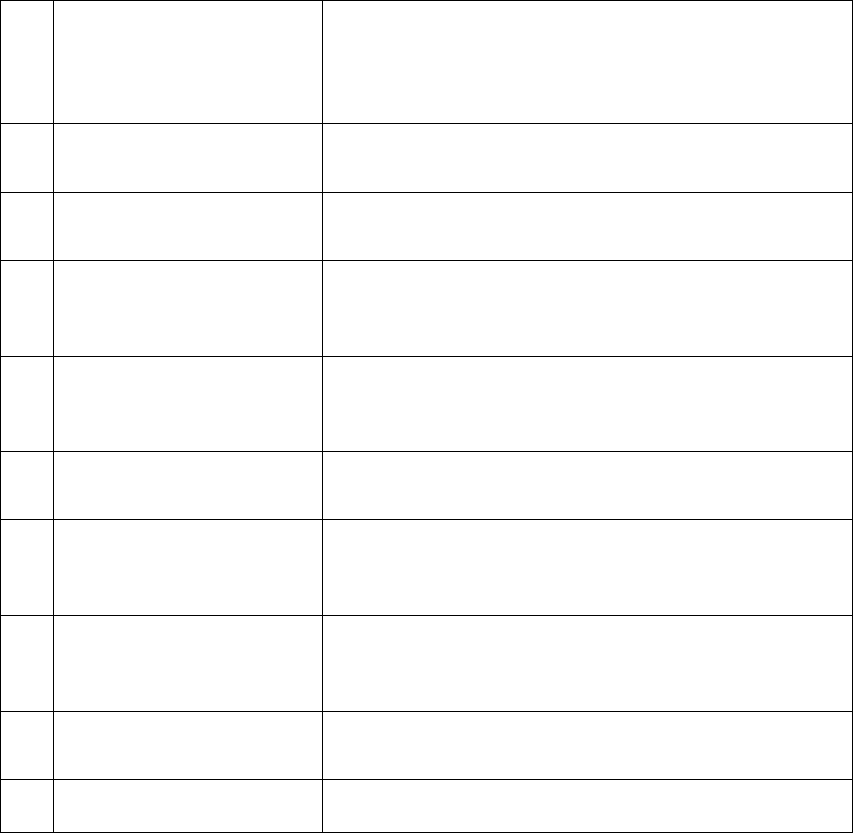
S/1319/2015
Annex 2
Appendix 4
page 102
Appendix 4
REFERENCE DOCUMENTATION
1. QDOC/INS/SOP/IAU01 Standard Operating Procedure for Evidence
Collection, Documentation, Chain-of-Custody and
Preservation During an Investigation of Alleged Use
of Chemical Weapons
2. QDOC/INS/WI/IAU05 Work Instruction for Conducting Interviews During
an Investigation of Alleged Use
3.
QDOC/INS/SOP/IAU02
Standard Operating Procedure Investigation of
Alleged Use (IAU) Operations
4. QDOC/INS/WI/IAU01 Work Instruction for Command Post Operations
During an Investigation of Alleged Use of Chemical
Weapons
5. QDOC/INS/SOP/GG011 Standard Operating Procedure for Managing
Inspection Laptops and Other Confidentiality
Support Materials
6. QDOC/LAB/SOP/OSA2 Standard Operating Procedure for Off-Site Analysis
of Authentic Samples
7. QDOC/LAB/WI/CS01 Work Instruction for Handling of Authentic Samples
from Inspection Sites and Packing Off-Site Samples
at the OPCW Laboratory
8. QDOC/LAB/WI/CS03 Work Instruction for Documentation, Chain of
Custody and Confidentiality for Handling Off-Site
Samples at the OPCW Laboratory
9. QDOC/LAB/WI/OSA3 Work Instruction for Chain of Custody and
Documentation for OPCW Samples On-Site
10. QDOC/LAB/WI/OSA4 Work Instruction for Packing of Off-Site Samples

S/1319/2015
Annex 2
Appendix 5
page 103
Appendix 5
OPEN-SOURCE REFERENCES AND INFORMATION
Date of
Incident
Location Source/link(s)
16/03/2015 Qmenas https://en.wikipedia.org/wiki/Use_of_chemical_weapons_in_the_Syrian_civil_war
16/03/2015
Qmenas
and
Sarmin –
20:45
https://youtu.be/f6qBHWgPf7Q, https://youtu.be/ZgWP_QprOP4, https://youtu.be/XAORzTza7rg, https://youtu.be/nQg1B0k5Zkk,
https://youtu.be/JUSH7rHBQsc, https://youtu.be/yzGcHdR2AVs, https://youtu.be/j96W2l_oqgo, https://youtu.be/W8eZkU6jnTE,
https://youtu.be/FAhzdWWKbHA, https://youtu.be/Zj2fgROPFJA, https://youtu.be/2m17JnGFYdc, https://youtu.be/6bTrpHYMEDY,
https://youtu.be/ujb9ROoQaZY, https://youtu.be/ovPKtOjOx7g, https://youtu.be/Gx2h3_jXGzc, https://youtu.be/MmNBLUtP3hw,
https://youtu.be/Vc9cuH1icHo, https://youtu.be/SMVkFIlY5II, https://youtu.be/oZoAwJUyqTY, https://youtu.be/gPa_6CoYD_o,
https://youtu.be/ja_Osq_RTqU, https://youtu.be/JIlBRb2aFzo, https://youtu.be/4Kg4qSo40S0, https://youtu.be/m_zeRoX_L7s,
https://youtu.be/21K2g_LkSts, https://youtu.be/qnp00TocRSY, https://youtu.be/nvwonr_QqGo, https://youtu.be/N84aC1z0bjw,
https://youtu.be/k7TwicGkTdo, https://youtu.be/J6c6A1Qnbbw, https://twitter.com/ughxughx111/status/577548098806915072,
https://twitter.com/sweet_hart1165/status/577549747143196672,
https://twitter.com/aboyosha3homs/status/577550356374159360, https://twitter.com/anastracey/status/577552436975501312,
https://twitter.com/omar_3lwan/status/577552527912267776, https://twitter.com/hassanalhesen/status/577553118914863104,
https://twitter.com/SarmeenCoordina/status/577556117657661440,
https://twitter.com/anasanas84/status/577556934624210944, https://twitter.com/news76696251/status/577604460974907392
16/03/2015
Qmenas
and
Sarmin –
22:15
https://youtu.be/f6qBHWgPf7Q, https://youtu.be/ZgWP_QprOP4, https://youtu.be/XAORzTza7rg, https://youtu.be/nQg1B0k5Zkk,
https://youtu.be/JUSH7rHBQsc, https://youtu.be/yzGcHdR2AVs, https://youtu.be/j96W2l_oqgo, https://youtu.be/W8eZkU6jnTE,
https://youtu.be/FAhzdWWKbHA, https://youtu.be/Zj2fgROPFJA, https://youtu.be/2m17JnGFYdc, https://youtu.be/6bTrpHYMEDY,
https://youtu.be/ujb9ROoQaZY, https://youtu.be/ovPKtOjOx7g, https://youtu.be/Gx2h3_jXGzc, https://youtu.be/MmNBLUtP3hw,
https://youtu.be/Vc9cuH1icHo, https://youtu.be/SMVkFIlY5II, https://youtu.be/oZoAwJUyqTY, https://youtu.be/gPa_6CoYD_o,
https://youtu.be/ja_Osq_RTqU, https://youtu.be/JIlBRb2aFzo, https://youtu.be/4Kg4qSo40S0, https://youtu.be/m_zeRoX_L7s,
https://youtu.be/21K2g_LkSts, https://youtu.be/qnp00TocRSY, https://youtu.be/nvwonr_QqGo, https://youtu.be/N84aC1z0bjw,
https://youtu.be/k7TwicGkTdo, https://youtu.be/J6c6A1Qnbbw, https://twitter.com/ughxughx111/status/577548098806915072,
https://twitter.com/sweet_hart1165/status/577549747143196672,
https://twitter.com/aboyosha3homs/status/577550356374159360, https://twitter.com/anastracey/status/577552436975501312,
https://twitter.com/omar_3lwan/status/577552527912267776, https://twitter.com/hassanalhesen/status/577553118914863104,
https://twitter.com/SarmeenCoordina/status/577556117657661440,
https://twitter.com/anasanas84/status/577556934624210944, https://twitter.com/news76696251/status/577604460974907392
https://en.wikipedia.org/wiki/Use_of_chemical_weapons_in_the_Syrian_civil_war
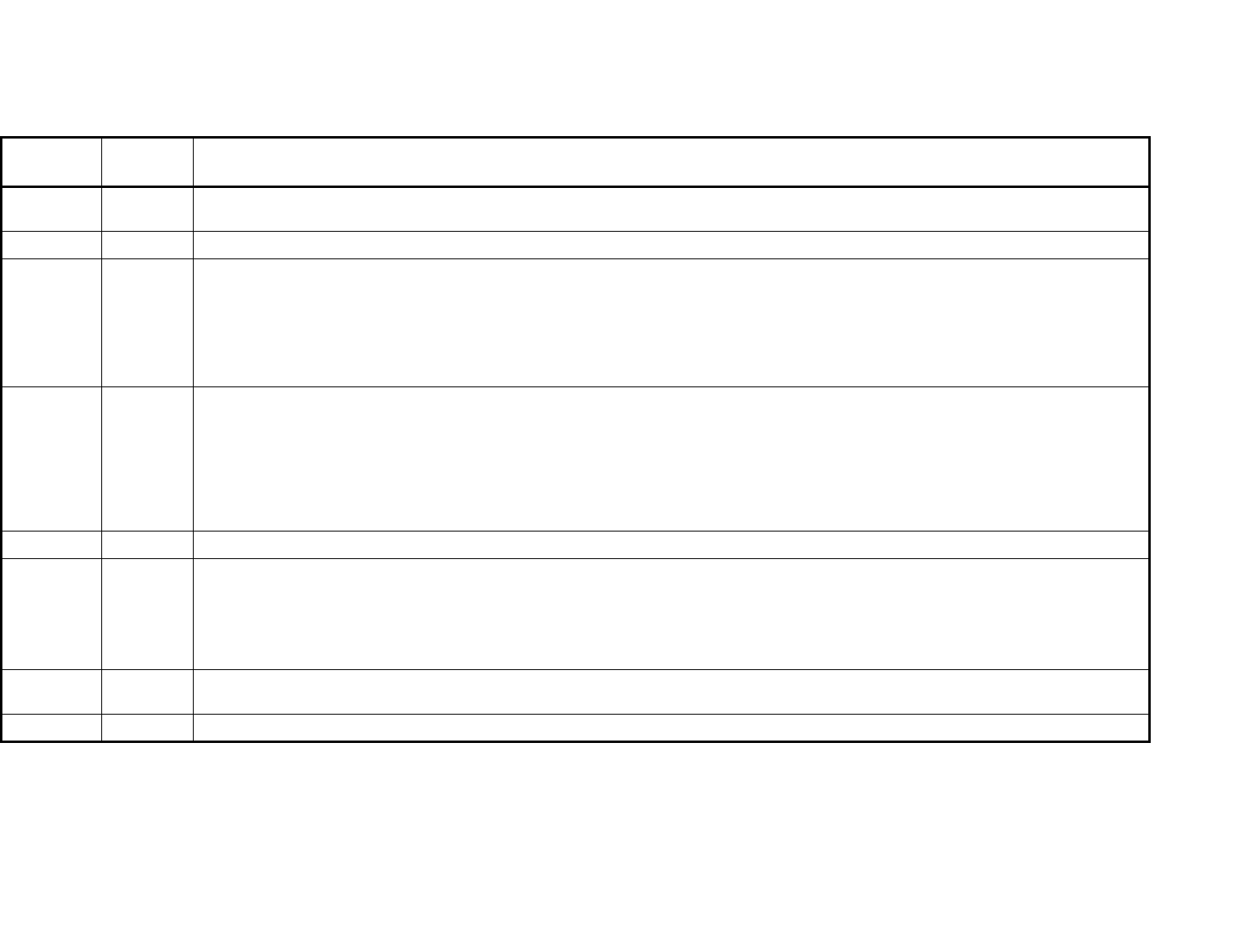
S/1319/2015
Annex 2
Appendix 5
page 104
Date of
Incident
Location Source/link(s)
23/03/2015 Qmenas
https://d3n8a8pro7vhmx.cloudfront.net/etilaf/pages/233/attachments/original/1429904920/2015.04.24_SNC_2139_letter_-
_Qatar.pdf?1429904920
23/03/2015 Binnish https://en.wikipedia.org/wiki/Use_of_chemical_weapons_in_the_Syrian_civil_war
23/03/2015 Sarmin
https://twitter.com/bellall0088/status/579797897304281090, https://twitter.com/opaidaaa/status/579797943991066626,
https://twitter.com/binnishFree2012/status/579798112887291904,
https://twitter.com/SarmeenCoordina/status/579800424447909888,
https://www.facebook.com/photo.php?fbid=464014523746647, https://twitter.com/Syria_Breaking/status/579804520529694720,
http://www.youtube.com/watch?v= jS90Di0j0k4, http://www.youtube.com/watch?v= g0lbjiVBOw,
http://www.youtube.com/watch?v= 1ebkWL6RMCQ, http://www.youtube.com/watch?v= cqlSzgLRl0,
http://www.youtube.com/watch?v= 89MqnbBGNy4
24/03/2015 Binnish
https://twitter.com/alasiAgency/status/580397065659924480, https://www.facebook.com/press.siraj/posts/672579012868917,
https://d3n8a8pro7vhmx.cloudfront.net/etilaf/pages/233/attachments/original/1429904920/2015.04.24_SNC_2139_letter_-
_Qatar.pdf?1429904920,
https://d3n8a8pro7vhmx.cloudfront.net/etilaf/pages/233/attachments/original/1429904920/2015.04.24_SNC_2139_letter_-
_Qatar.pdf?1429904920,
https://twitter.com/tajhoran1/status/580417521926451200, https://twitter.com/thuwwar/status/580421626199732226,
https://www.facebook.com/binnish.freemen.sy/posts/715904655197889, https://youtu.be/WnT4oxdE1ZU, https://youtu.be/-
IDI7tNgiVE https://en.wikipedia.org/wiki/Use_of_chemical_weapons_in_the_Syrian_civil_war
24/03/2015 Qmenas https://en.wikipedia.org/wiki/Use_of_chemical_weapons_in_the_Syrian_civil_war
25/03/2015 Sarmin
https://www.facebook.com/binnish.today/posts/455588234604519,
https://twitter.com/khaledkhalaf87/status/580882316412751872, https://twitter.com/shaamnews/status/580887031368290305,
https://youtu.be/kTL7c4AsrJQ, https://twitter.com/gazaelsyria111/status/580991276679479296,
http://www.youtube.com/watch?v=T8ZwykZG-U0, http://www.youtube.com/watch?v=sdbWFf2__nk,
http://www.youtube.com/watch?v=66JEoYl7pTc, http://www.youtube.com/watch?v=6-qRi69NDcU,
https://www.facebook.com/permalink.php?story_fbid=749176561848069&id=469192429846485
26/03/2015 Sarmin
http://docs.house.gov/meetings/FA/FA00/20150617/103638/HHRG-114-FA00-Wstate-TennariM-20150617.pdf,
https://twitter.com/sahabatsuriah/status/581296538216845312, http://www.mei.edu/content/article/atrocities-syria-who-will-be-left-speak-me
29/03/2015 Idlib http://docs.house.gov/meetings/FA/FA00/20150617/103638/HHRG-114-FA00-Wstate-TennariM-20150617.pdf

S/1319/2015
Annex 2
Appendix 5
page 105
Date of
Incident
Location Source/link(s)
30/03/2015
Idlib,
Mehrab
round-
about &
Matahen
https://d3n8a8pro7vhmx.cloudfront.net/etilaf/pages/233/attachments/original/1429904920/2015.04.24_SNC_2139_letter_-
_Qatar.pdf?1429904920
31/03/2015 Idlib
https://twitter.com/abunaeem711/status/582868192969781248, https://twitter.com/anasanas84/status/582868731140956162,
https://d3n8a8pro7vhmx.cloudfront.net/etilaf/pages/233/attachments/original/1429904920/2015.04.24_SNC_2139_letter_-
_Qatar.pdf?1429904920,
https://twitter.com/bathn_allaah/status/582872952749707265, https://twitter.com/DinSyr/status/582874307509886976,
https://www.facebook.com/3mar.shamali/posts/1614794892070367, https://youtu.be/Hl56SVU_ph8,
http://www.youtube.com/watch?v=ww6uEez7b8s, http://www.youtube.com/watch?v=P4IuSoQLpsw,
10/04/2015
Al-
Tamanah
https://twitter.com/Step_Agency/status/586509472455090177,
https://twitter.com/mohamadsalomala/status/586515905552715777, http://www.qasionnews.
com/ar/node/26371%23sthash.bVZNRWEf.dpbs, https://twitter.com/alxceszorba/status/586524484678615040,
http://www.youtube.com/watch?v= RxF0JBu1ie8, http://www.youtube.com/watch?v= 2dmb7Bo1iyM,
http://www.youtube.com/watch?v= OFjOG4P9oJo, http://www.youtube.com/watch?v= Cb2TfJesDM0,
http://www.youtube.com/watch?v= PbckiaHbpks https://en.wikipedia.org/wiki/Use_of_chemical_weapons_in_the_Syrian_civil_war
16/04/2015
Idlib
(Al Dbeyt
area)
https://twitter.com/_looaae/status/588792040374329344, https://twitter.com/AmmaRooV_11/status/588793074454757376,
https://d3n8a8pro7vhmx.cloudfront.net/etilaf/pages/235/attachments/original/1431012146/2015.5.5_SNC_Syria_CW_letter_-
_UK.pdf?1431012146,http://docs.house.gov/meetings/FA/FA00/20150617/103638/HHRG-114-FA00-Wstate-TennariM-20150617.pdf
https://twitter.com/ameeralhalabi/status/588793306684981251,
https://www.facebook.com/permalink.php?story_fbid=454989451331265&id=100004606429043,
https://twitter.com/anasanas84/status/588795732020330496, https://twitter.com/WalidKilani888/status/588795944872898561,
https://twitter.com/Mohamed_sbeh/status/588796536907296770, https://twitter.com/tahaasi1/status/588796666590978048,
https://www.facebook.com/aboo.kazem.9/posts/491692234311443, https://twitter.com/abaadnan2/status/588800979866427392,
https://twitter.com/salqin/status/588801047944155136, https://www.facebook.com/Banias.M.O1/posts/842243752508452,
https://twitter.com/aboalbraaalarab/status/588805461140447232,
https://www.facebook.com/SRGC.Mediaa/posts/949529428414129,
https://twitter.com/SRGCommission/status/588810640648699904,
https://twitter.com/SYR_REV_NEWS/status/588811629409669121,
https://twitter.com/HalabTodayTV/status/588813443785961475, http://din-sy.net/ar/Media/Subjects16221/,
https://twitter.com/hadialbahra/status/588823928283537410, https://twitter.com/radwan0001/status/588835215176572929,
http://www.youtube.com/watch?v=8HztVAfSyys, http://www.youtube.com/watch?v=y4Dt95Tv7v4,
http://www.youtube.com/watch?v=PVpoTbOptgQ, http://www.youtube.com/watch?v=wMfpJpvhnX0,
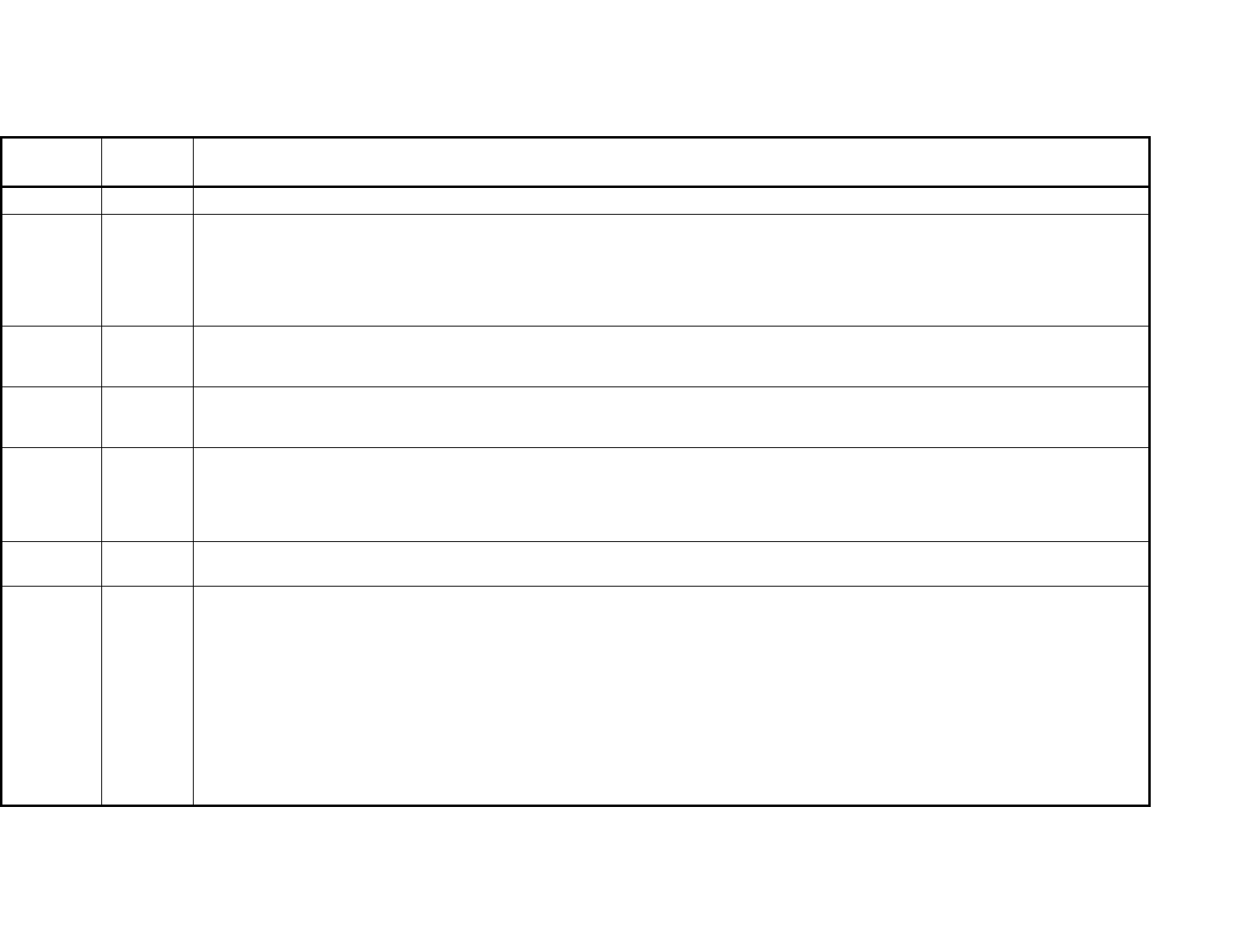
S/1319/2015
Annex 2
Appendix 5
page 106
Date of
Incident
Location Source/link(s)
http://www.youtube.com/watch?v=GN7aTPu6eJw, http://www.youtube.com/watch?v=yJJUMofu4Vo
16/04/2015 Kurin
https://twitter.com/paradoxy13/status/588829707161960449,
https://d3n8a8pro7vhmx.cloudfront.net/etilaf/pages/233/attachments/original/1429904920/2015.04.24_SNC_2139_letter_-
_Qatar.pdf?1429904920,
https://twitter.com/search?q=korin%20chlorine&src=typd
http://www.worldbulletin.net/haberler/158019/assad-regime-drops-chemical-barrel-bombs-on-idlib?utm_medium=twitter&utm_source=twitterfeed
16/04/2015 Sarmin
http://www.mei.edu/content/article/atrocities-syria-who-will-be-left-speak-me,
https://d3n8a8pro7vhmx.cloudfront.net/etilaf/pages/233/attachments/original/1429904920/2015.04.24_SNC_2139_letter_-
_Qatar.pdf?1429904920
17/04/2015
Idlib,
Tamanah,
Kafr Najd
http://en.etilaf.org/date/2015/4/17.html?catid=16
25/04/2015 Nayrab
https://twitter.com/SarmeenCoordina/status/591754319260721153,
https://twitter.com/FreeSyrianTaem/status/591764896980799488,
https://twitter.com/asaadalasaad191/status/591892289842188290,
https://twitter.com/Step_Agency/status/591902653963247616, https://twitter.com/mostafasy636/status/591853893694296064,
https://www.youtube.com/watch?v=_Ifs5GkagQA
26/04/2015
Jabal
Zawiyeh
http://www.middleeasteye.net/news/syrian rebel seize military base idlib province 2134817759
26/04/2015
Kafr
Uwayd
https://twitter.com/m3tz_39/status/592412137848381441, https://twitter.com/m3tz_39/status/592413029418934272,
https://twitter.com/a7madati9/status/592413092824354817, https://twitter.com/yamama_sh22/status/592413458181816320,
https://twitter.com/alidddd99/status/592414486813876224, https://twitter.com/abooslah/status/592415469388353536,
https://twitter.com/mohamadsalomala/status/592415513994784768,
https://twitter.com/aboalaa_ahmadxd/status/592417771713142784,
https://twitter.com/shaamnews/status/592417717526929409, http://din-sy.net/ar/Media/Subjects16997/,
https://twitter.com/SyrianArwad/status/592418923976462336,
https://twitter.com/asimzedan/status/592432005956112384/photo/1,
https://www.facebook.com/permalink.php?story_fbid=765316066900785&id=469192429846485,
https://www.youtube.com/watch?v=A2GNP5n4gzY, https://www.youtube.com/watch?v=BmNOwUxP8Wk,
http://www.youtube.com/watch?v=hpLYUTNVDLQ, https://www.youtube.com/watch?v=fhlTM_56tC0
https://www.facebook.com/permalink.php?story_fbid=847670258638283&id=844879298917379 http://www.gettyimages.nl/detail/video/syrians
including children receive treatment at a local nieuwsfootage/471545080
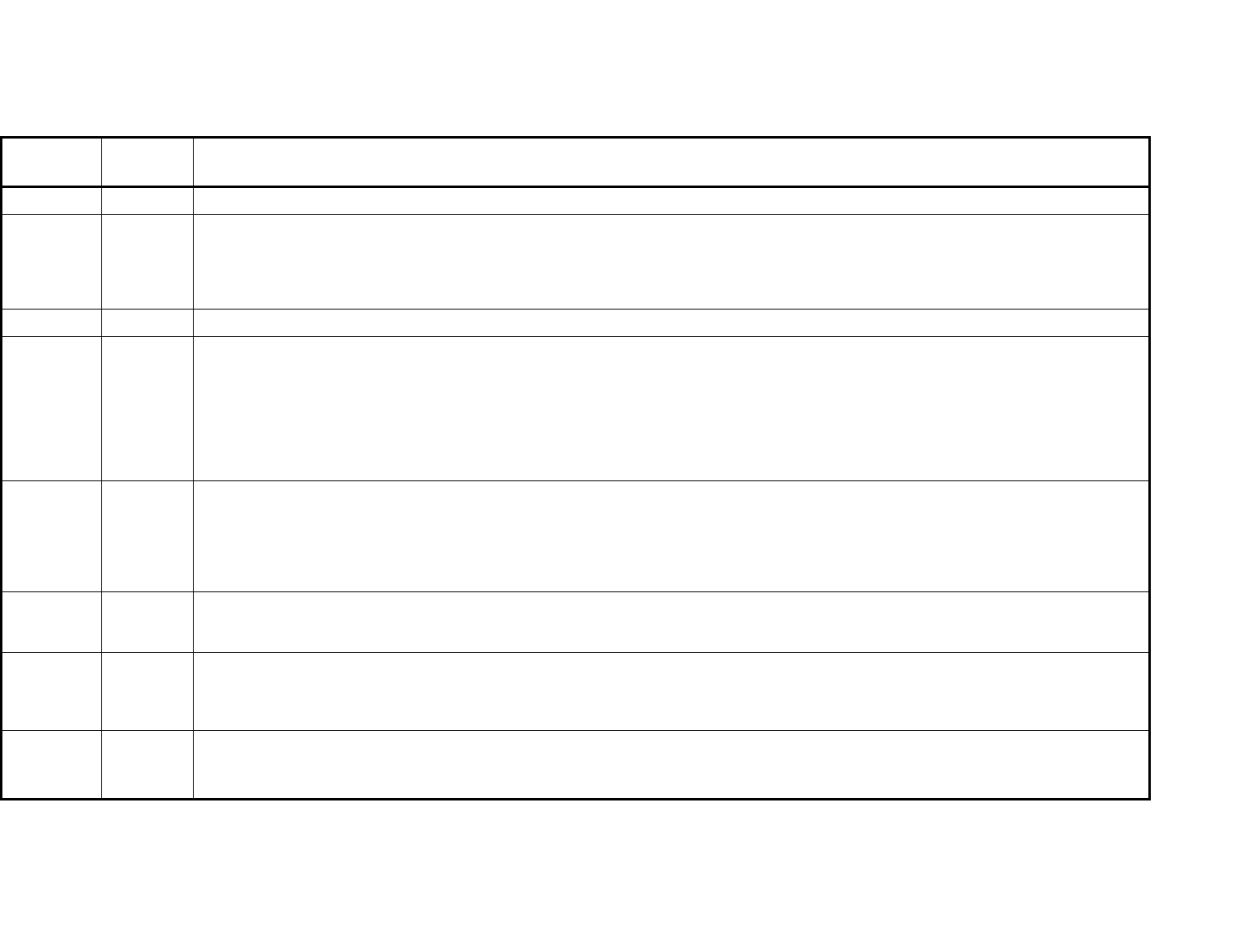
S/1319/2015
Annex 2
Appendix 5
page 107
Date of
Incident
Location Source/link(s)
https://twitter.com/search?q=%22kafr%20owaid%22%20since%3A2015 04 26%20until%3A2015 04 27&src=typd
26/04/2015 Nayrab
https://twitter.com/m_aboalyman/status/592435256973721600, https://twitter.com/FreeSrmeen/status/592436912725569536,
http://docs.house.gov/meetings/FA/FA00/20150617/103638/HHRG-114-FA00-Wstate-TennariM-20150617.pdf
https://twitter.com/ughxughx111/status/592444596883423232, https://twitter.com/abooslah/status/592462672379179008,
https://www.youtube.com/watch?v=c5GrGcg8N7c,
https://www.facebook.com/permalink.php?story_fbid=368351930038543&id=232634920276912
27/04/2015 An Nayrab http://docs.house.gov/meetings/FA/FA00/20150617/103638/HHRG-114-FA00-Wstate-TennariM-20150617.pdf
28/04/2015
Kansafrah
and
kurasa'ah
(Qursa'a)
https://twitter.com/aljisrtv/status/593065386163249153, https://twitter.com/SyrianArwad/status/593073217109159938,
https://d3n8a8pro7vhmx.cloudfront.net/etilaf/pages/235/attachments/original/1431012146/2015.5.5_SNC_Syria_CW_letter_-
_UK.pdf?1431012146,
https://www.facebook.com/SASNEWSAGENCY/photos/a.733987789978579.1073741828.731915533519138/964651626912193/?ty
pe=1&permPage=1, https://www.facebook.com/photo.php?fbid=836813786405330,
https://twitter.com/Ayavetch/status/593072355737481218/photo/1, http://www.youtube.com/watch?v=K7Yf0n3wNnY,
https://www.facebook.com/permalink.php?story_fbid=766305273468531&id=469192429846485,
http://www.youtube.com/watch?v=oqQVBfAOkwM
29/04/2015 Saraqeb
https://twitter.com/ahmadokla94/status/593405675415416832, https://www.facebook.com/photo.php?fbid=957904474243291,
https://d3n8a8pro7vhmx.cloudfront.net/etilaf/pages/235/attachments/original/1431012146/2015.5.5_SNC_Syria_CW_letter_-
_UK.pdf?1431012146,
https://twitter.com/alEtihad_Press/status/593410465906176000, https://www.facebook.com/photo.php?fbid=352535254942895,
https://twitter.com/zyadalfares/status/593421993732612096, https://www.facebook.com/photo.php?fbid=371813673003469,
http://www.youtube.com/watch?v=CUVrIUeztQQ, http://www.youtube.com/watch?v=sPkJXt81gK8
01/05/2015
Qulaydin
Village,
Ghab plain
https://d3n8a8pro7vhmx.cloudfront.net/etilaf/pages/235/attachments/original/1431012146/2015.5.5_SNC_Syria_CW_letter_-
_UK.pdf?1431012146
01/05/2015 Saraqeb
http://www.ibtimes.co.uk/syria-assad-regime-accused-chlorine-gas-attack-idib-1499463, https://twitter.com/snhr/status/594362194663464960,
https://d3n8a8pro7vhmx.cloudfront.net/etilaf/pages/235/attachments/original/1431012146/2015.5.5_SNC_Syria_CW_letter_-
_UK.pdf?1431012146
http://www.aljazeera.com/news/2015/05/fresh-claims-chlorine-gas-attacks-syria-150502235313185.html
02/05/2015 Nayrab
https://twitter.com/Ahmedbakour/status/594266428708134913, https://twitter.com/marbaleet/status/594266734581932032,
https://d3n8a8pro7vhmx.cloudfront.net/etilaf/pages/235/attachments/original/1431012146/2015.5.5_SNC_Syria_CW_letter_-
_UK.pdf?1431012146, https://www.hrw.org/news/2015/06/03/syria new chemical attacks idlib
https://twitter.com/811Syria/status/594268952504696833, https://twitter.com/m_aboalyman/status/594278996243800064,
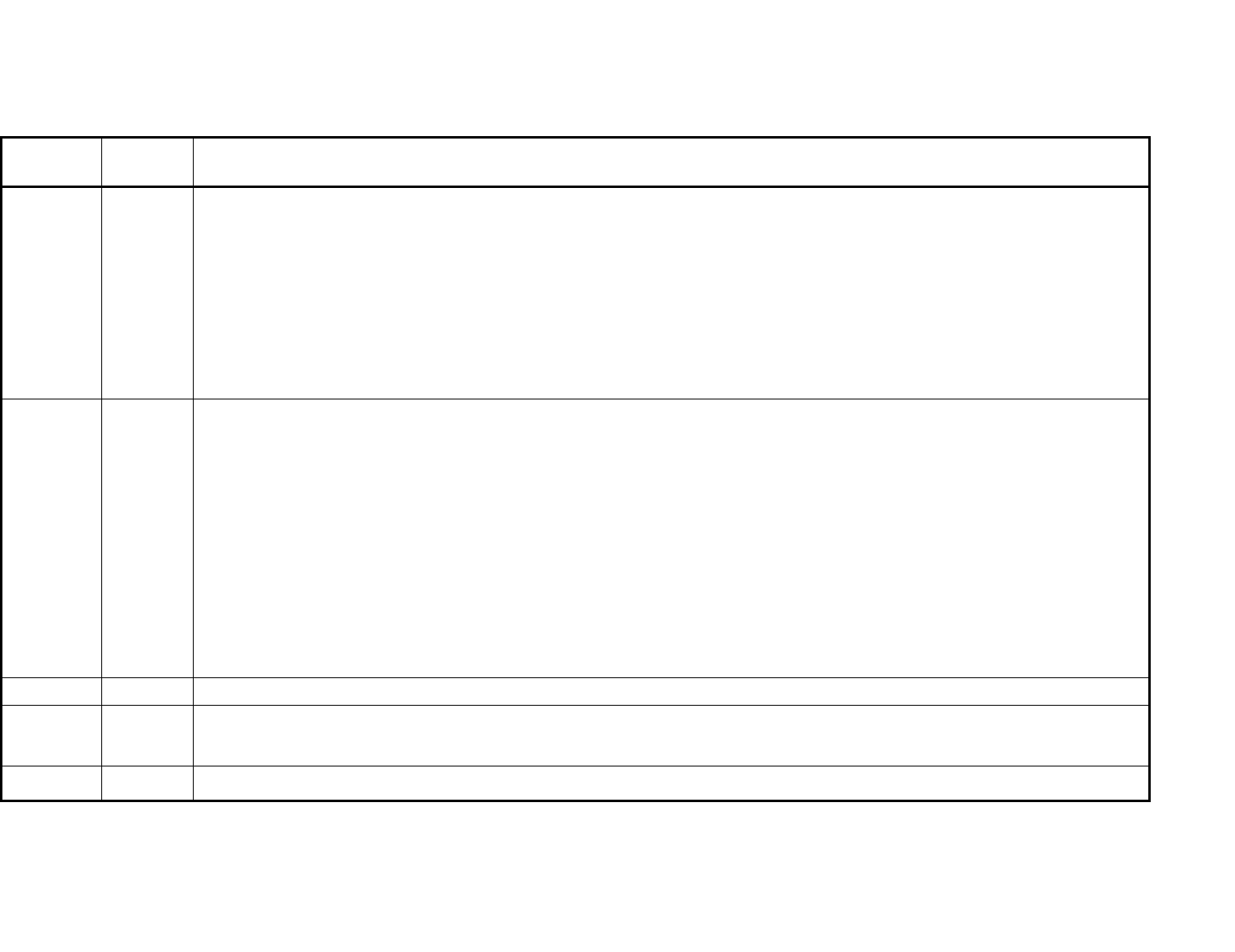
S/1319/2015
Annex 2
Appendix 5
page 108
Date of
Incident
Location Source/link(s)
https://twitter.com/a243681bd8b24a6/status/594286189819129856,
https://www.facebook.com/AlmshfyAlmydanyFyMdyntSrmyn/posts/766389830149251,
https://www.facebook.com/photo.php?fbid=588685461271428&set=a.117169015089744.18522.100003899395594&type=1&perm
Page=1,
https://www.facebook.com/1641082869457113/photos/a.1644272782471455.1073741829.1641082869457113/165614638795076
1/?type=1&permPage=1, https://twitter.com/syriia24/status/594392541077839872/photo/1,
https://twitter.com/khaha81/status/594392983165865984,
https://www.facebook.com/AlmshfyAlmydanyFyMdyntSrmyn/photos/a.394312727356965.1073741828.394196807368557/766617
340126500/?type=1, https://twitter.com/mnaw7/status/594551673755832320/photo/1,
http://www.youtube.com/watch?v=IKlTTE7_TR8, http://www.youtube.com/watch?v=kjwkiWxQg4o,
http://www.youtube.com/watch?v=Ahl-eHebnyk, http://www.youtube.com/watch?v=nGTp9_sPYHQ
http://www.youtube.com/watch?v=17SbpDo4jvc
02/05/2015 Saraqeb
https://twitter.com/811Syria/status/594284771120914433, https://twitter.com/ughxughx111/status/594293131505487872,
http://www.hrw.org/news/2015/06/03/syria-new-chemical-attacks-idlib,
https://d3n8a8pro7vhmx.cloudfront.net/etilaf/pages/235/attachments/original/1431012146/2015.5.5_SNC_Syria_CW_letter_-
_UK.pdf?1431012146,https://d3n8a8pro7vhmx.cloudfront.net/etilaf/pages/235/attachments/original/1431012146/2015.5.5_SNC_Syria_CW_letter
_-_UK.pdf?1431012146
https://twitter.com/FreeSrmeen/status/594294386780930048, https://twitter.com/m_aboalyman/status/594295177478610948,
https://twitter.com/zyadalfares/status/594297270549504000, https://twitter.com/ughxughx111/status/594305097477267456,
https://twitter.com/asimzedan/status/594309601446731776/photo/1,
https://twitter.com/asimzedan/status/594310099650351105/photo/1,
https://twitter.com/SyrianSmurf/status/594314700361457665,
https://twitter.com/wassem19772000/status/594332276055498753, https://twitter.com/smatel/status/594339464354373632,
https://www.facebook.com/photo.php?fbid=653833924750746, https://twitter.com/anasanas84/status/594395930641694720,
https://youtu.be/Pl8lNppOSM4, https://youtu.be/Qbo_8-qypP0, https://youtu.be/x9fTFqWS9f8, https://youtu.be/HOw7bxV1Xhw,
https://youtu.be/FufDVwORaO4, https://youtu.be/f3Euba8FAWg, https://youtu.be/SSosJv8Gp0U, https://youtu.be/pqHMaR3_JeI,
https://youtu.be/wrrXyhkLctk, https://youtu.be/KGTLSvy6UPc, https://youtu.be/MRk0TRM1Lg8
https://youtu.be/1FKwhoQxysY https://en.wikipedia.org/wiki/Use_of_chemical_weapons_in_the_Syrian_civil_war
03/05/2015 Kan safra http://docs.house.gov/meetings/FA/FA00/20150617/103638/HHRG-114-FA00-Wstate-TennariM-20150617.pdf
03/05/2015 Ibleen
http://english.alarabiya.net/en/News/middle east/2015/05/14/White House says concerned about Syria chemical weapons allegations.html,
https://d3n8a8pro7vhmx.cloudfront.net/etilaf/pages/235/attachments/original/1431012146/2015.5.5_SNC_Syria_CW_letter_-
_UK.pdf?1431012146
03/05/2015
Jabal az
https://instagram.com/p/2ODf7TjF9e/, http://www.youtube.com/watch?v=MJsxNxgPyQo,
http://www.youtube.com/watch?v=WPeeSsAPSAM
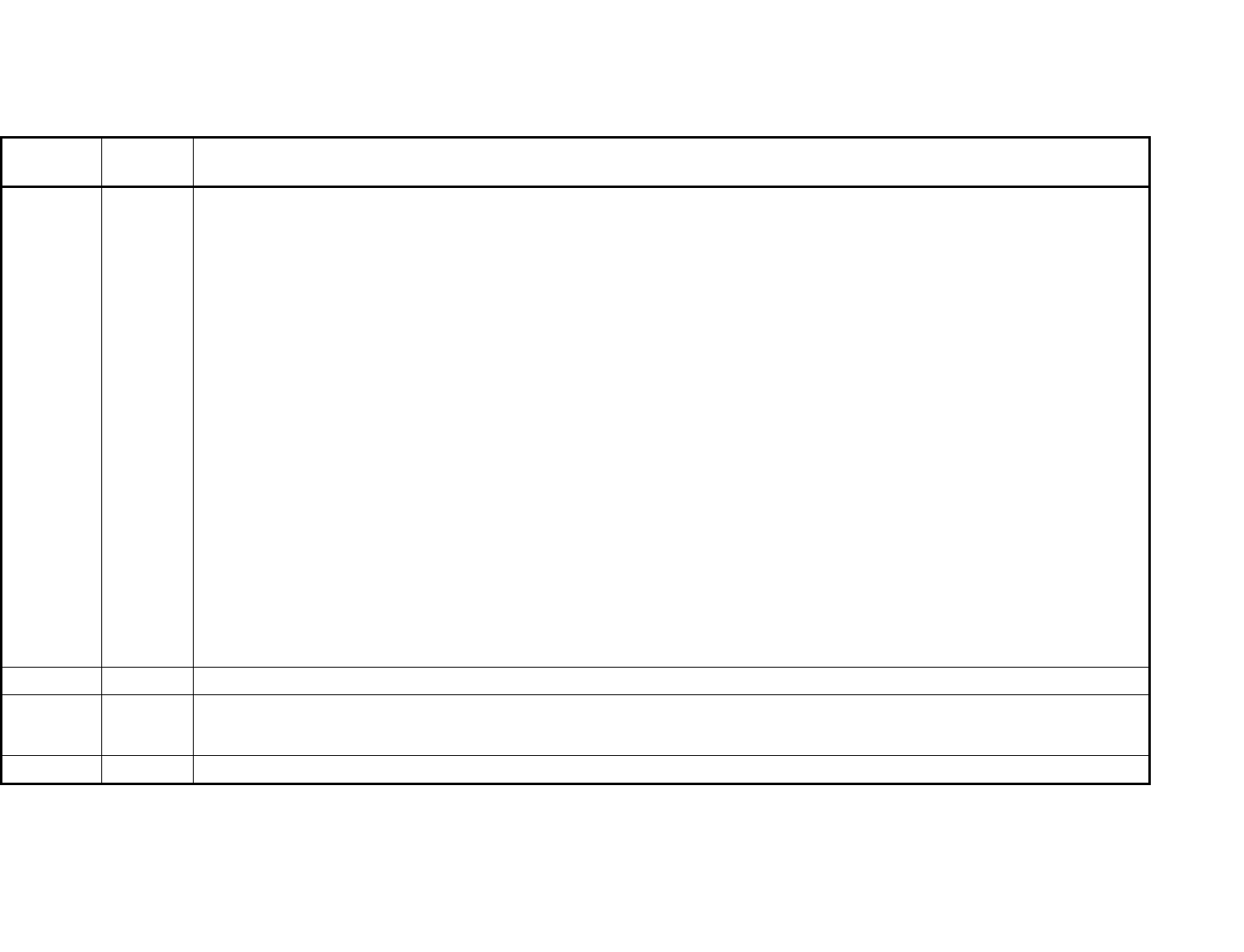
S/1319/2015
Annex 2
Appendix 5
page 109
Date of
Incident
Location Source/link(s)
Zawiyan http://www.youtube.com/watch?v=2kazwCWuEpU
http://www.youtube.com/watch?v=oBV8JOZRXXU
http://www.youtube.com/watch?v=Mxjdh45O_yY
http://www.youtube.com/watch?v=eCxhJhtiAGM
https://twitter.com/wassem19772000/status/594824525214265344
https://twitter.com/ammar_alabdo/status/594824861169627138
https://twitter.com/ammar_alabdo/status/594830782893535232
https://twitter.com/hassan_adlib/status/594830984425541635 https://twitter.com/Step_Agency/status/594831840780910592
https://twitter.com/mhamad_hamod/status/594832257283727360
https://twitter.com/SMARTNewsAgency/status/594833059993628672
https://twitter.com/ahmadokla94/status/594835890129805313
https://www.facebook.com/photo.php?fbid=486986388120776
http://eldorar.com/node/75628
https://twitter.com/syrianman85/status/594841390237888512/photo/1
https://twitter.com/MasarPressNet/status/594845249643610112
https://www.facebook.com/ArihaTodayNews/photos/a.1607046429508675.1073741828.1606743406205644/1623842261162425/
?type=1&permPage=1
https://www.facebook.com/ArihaTodayNews/posts/1623842367829081
https://twitter.com/asimzedan/status/594857005514412033/photo/1
https://twitter.com/HadiAlabdallah/status/594858297557135360/photo/1
https://twitter.com/HadiAlabdallah/status/594860194120728576/photo/1
http://slnnews.co/?p=22844
https://twitter.com/HadiAlabdallah/status/594861717567512576/photo/1
https://youtu.be/CILRhsiGTKY
https://youtu.be/MJsxNxgPyQo
https://youtu.be/n_3-NMpenys
https://www.facebook.com/ArihaTodayNews/photos/a.1607046429508675.1073741828.1606743406205644/1623973694482615/
?type=1
03/05/2015 Juzif http://english.aawsat.com/2015/05/article55343347/syrian activists report new chlorine attacks in idlib
04/05/2015 Kansafrah
http://www.la-croix.com/Actualite/Monde/Affaibli-le-regime-syrien-multiplie-les-attaques-au-chlore-2015-05-05-1309422
https://www.google.nl/maps/place/Kansafra,+Syria/@35.6605554,36.4752994,15z/data=!3m1!4b1!4m2!3m1!1s0x15245a63e8e13a45:0xe6b2234
2480b5694
06/05/2015 Al Bashiria http://docs.house.gov/meetings/FA/FA00/20150617/103638/HHRG-114-FA00-Wstate-TennariM-20150617.pdf

S/1319/2015
Annex 2
Appendix 5
page 110
Date of
Incident
Location Source/link(s)
06/05/2015
Jisr al
Shughur
https://www.facebook.com/Jisralshughour/posts/824287530960090
https://www.facebook.com/permalink.php?story_fbid=770961536336238&id=469192429846485
http://syrianpc.com/2015/05/07/%D8%A8%D8%A7%D9%84%D8%B5%D9%88%D8%B1-%D8%B4%D9%87%D9%8A%D8%AF-
%D9%88%D8%A3%D9%83%D8%AB%D8%B1-%D9%85%D9%86-50-%D8%A5%D8%B5%D8%A7%D8%A8%D8%A9-
%D8%A8%D8%A7%D9%84%D8%BA%D8%A7%D8%B2%D8%A7%D8%AA-%D8%A7/,
https://twitter.com/skoralham/status/596087800010645505, https://twitter.com/abohamzaislam/status/596088252655915008,
https://twitter.com/jesrNEWS/status/596091195450728449, https://twitter.com/0000mmmm1/status/596220856725934080,
https://twitter.com/alEtihad_Press/status/596229951638077440
06/05/2015 Kafr Batikh
https://www.facebook.com/permalink.php?story_fbid=770832469682478&id=469192429846485, https://youtu.be/p61MxkAkR8w,
https://twitter.com/khaledkhalaf87/status/596076845549891584, https://twitter.com/abokazemm1/status/596081491161063425,
https://twitter.com/zyadalfares/status/596082873469374467, https://twitter.com/811Syria/status/596083197433098240,
https://www.facebook.com/1SyriaNewsAgency/posts/399141236940813,
http://smartnews-agency.com/news/51179?utm_source=dlvr.it&utm_medium=twitter&utm_campaign=smartnewsagency,
07/05/2015 Janouidieh
http://www.haaretz.com/news/middle-east/middle-east-updates/1.655537, http://docs.house.gov/meetings/FA/FA00/20150617/103638/HHRG-
114-FA00-Wstate-TennariM-20150617.pdf
http://www.theguardian.com/world/2015/may/08/new-suspected-chemical-attacks-reported-in-syria-dozens-injured
http://english.alarabiya.net/en/News/middle-east/2015/05/08/Syrian-activists-report-new-chlorine-attacks-in-Idlib.html
http://bigstory.ap.org/article/c2aee8cea6d1424dbe03dd6efc93960e/syrian-troops-hezbollah-allies-take-more-areas-near-lebanon
07/05/2015 Kafr Batikh
http://www.haaretz.com/news/middle-east/middle-east-updates/1.655537, http://docs.house.gov/meetings/FA/FA00/20150617/103638/HHRG-
114-FA00-Wstate-TennariM-20150617.pdf
http://www.theguardian.com/world/2015/may/08/new-suspected-chemical-attacks-reported-in-syria-dozens-injured
http://english.alarabiya.net/en/News/middle-east/2015/05/08/Syrian-activists-report-new-chlorine-attacks-in-Idlib.html
http://bigstory.ap.org/article/c2aee8cea6d1424dbe03dd6efc93960e/syrian-troops-hezbollah-allies-take-more-areas-near-lebanon
07/05/2015 Hizareen https://twitter.com/search?q=hizareen&src=typd
07/05/2015 Kansafrah
http://www.ibtimes.co.uk/syria assad chlorine attack reported idlib province rebels gain ground 1500358
http://www.independent.co.uk/news/world/middle east/syria chlorine attacks dozens reported suffocated as regime drops chemical barrel bombs
on idlib 10234798.html , https://twitter.com/salqin/status/596292316664635393, https://youtube.com/watch?v=E12spT_iM58,
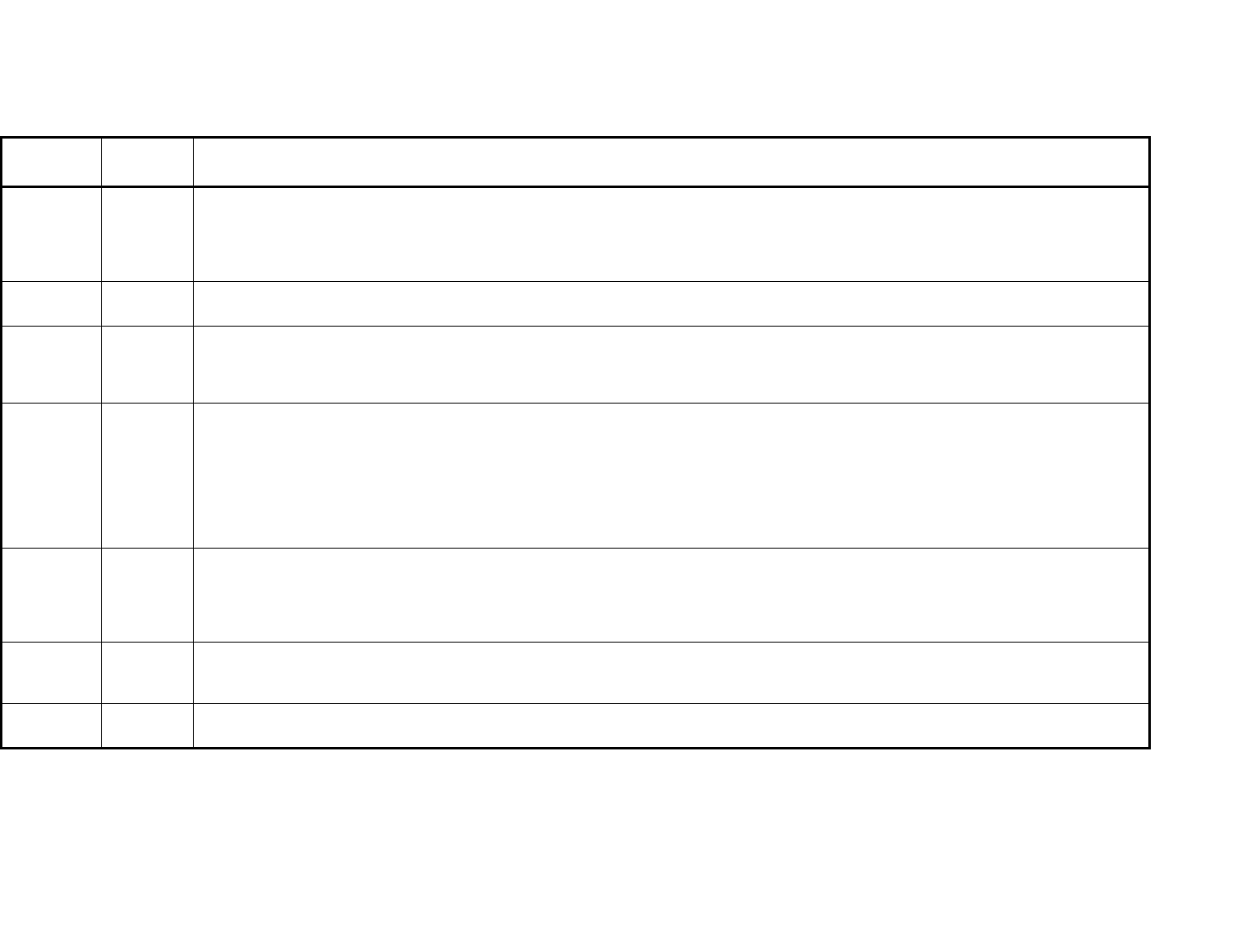
S/1319/2015
Annex 2
Appendix 5
page 111
Date of
Incident
Location Source/link(s)
https://www.facebook.com/photo.php?fbid=1104202679596828
https://twitter.com/hassan_adlib/status/596259500463493121/photo/1,
https://twitter.com/kefranbil/status/596231204233314304, https://twitter.com/hassan_adlib/status/596231587525570561,
https://twitter.com/abooslah/status/596239195817017344, https://twitter.com/AbdulRazzAlkhal/status/596242059876524032,
https://twitter.com/SharefSarmada/status/596300146423570432/photo/1
10/05/2015
Al
Bashariyah
http://docs.house.gov/meetings/FA/FA00/20150617/103638/HHRG-114-FA00-Wstate-TennariM-20150617.pdf
14/05/2015
Jisr al
Shughur
https://www.youtube.com/watch?v=VE0G1Kesc7E
https://www.google.nl/maps/place/Jisr+Ash-
Shugur,+Syri%C3%AB/@35.8150919,36.3123962,15z/data=!4m2!3m1!1s0x1524496330940beb:0xba47f0808c645a96
15/05/2015
Mashmash
an
http://www.youtube.com/watch?v=u4nADXs6mNQ, http://docs.house.gov/meetings/FA/FA00/20150617/103638/HHRG-114-FA00-Wstate-
TennariM-20150617.pdf
https://www.facebook.com/photo.php?fbid=437599189747412
https://twitter.com/jesrNEWS/status/599123585039368192
https://www.facebook.com/Jisralshughour2/posts/452114968297826
https://www.facebook.com/1SyriaNewsAgency/posts/402171506637786
https://twitter.com/yamama_sh22/status/599158576637026304
https://www.facebook.com/video.php?v=1143688635648573
16/05/2015 Sarmin
https://www.facebook.com/srmeen11/posts/1655765634639756, https://youtu.be/vFj-gtbPBqo,
http://docs.house.gov/meetings/FA/FA00/20150617/103638/HHRG-114-FA00-Wstate-TennariM-20150617.pdf
https://www.facebook.com/srmeen11/posts/1655753824640937,
https://www.facebook.com/Radio.Alkul/posts/862972507115119, https://twitter.com/abo47130008/status/599485630372978689,
https://www.facebook.com/srmeen11/posts/1655896734626646
17/05/2015
Al Kostan,
Jisr al
Shughur
http://docs.house.gov/meetings/FA/FA00/20150617/103638/HHRG-114-FA00-Wstate-TennariM-20150617.pdf
17/05/2015
Mashmash
an
http://docs.house.gov/meetings/FA/FA00/20150617/103638/HHRG-114-FA00-Wstate-TennariM-20150617.pdf
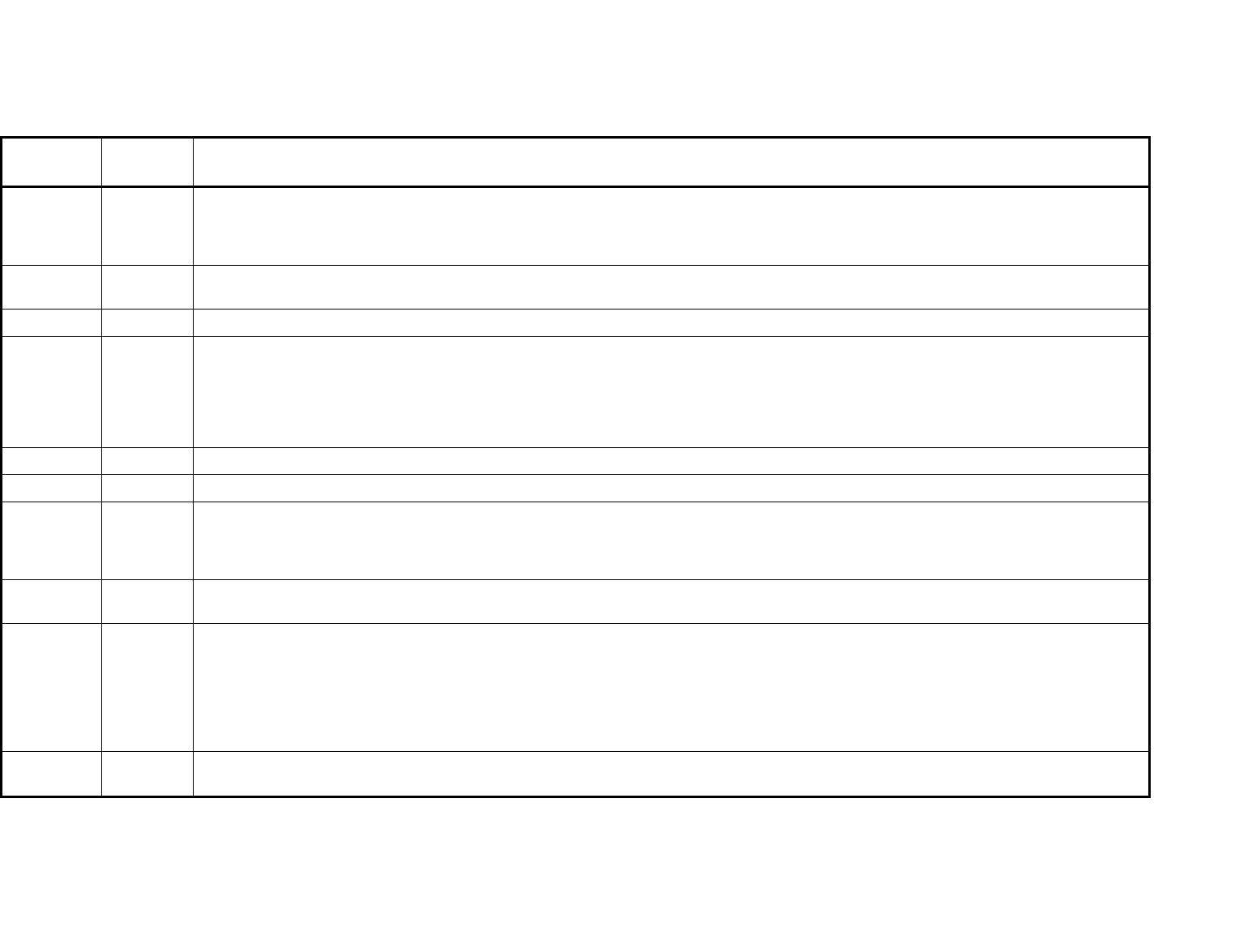
S/1319/2015
Annex 2
Appendix 5
page 112
Date of
Incident
Location Source/link(s)
17/05/2015
Jisr al
Shughur
https://twitter.com/radwanalbasha/status/599732752569618433, https://twitter.com/akhbar/status/599735332872019970,
https://www.facebook.com/permalink.php?story_fbid=997445036932268&id=867873686556071,
https://www.facebook.com/permalink.php?story_fbid=774683829297342&id=469192429846485,
https://www.facebook.com/ENN16/posts/335869946623231, https://twitter.com/jesrNEWS/status/600200294937403392,
18/05/2015
Jisr al
Shughur
http://syrianobserver.com/EN/News/29184/Chlorine_Attack_Jisr_Shughour_Kills_Children_Monitoring_Group
19/05/2015 Idlib City http://docs.house.gov/meetings/FA/FA00/20150617/103638/HHRG-114-FA00-Wstate-TennariM-20150617.pdf
19/05/2015
Jisr al
Shughur,
Mashmash
an
https://www.facebook.com/hashemalabdullah89/posts/618392771629348, http://docs.house.gov/meetings/FA/FA00/20150617/103638/HHRG-
114-FA00-Wstate-TennariM-20150617.pdf
https://twitter.com/mlak012301/status/600553347427344384/photo/1,
https://www.facebook.com/permalink.php?story_fbid=775607335871658&id=469192429846485,
http://www.youtube.com/watch?v=yiqLLmuAA6Y, http://www.youtube.com/watch?v=UaLma_hDtI0,
http://www.youtube.com/watch?v=jYTzvAE8-QQ
19/05/2015 Al bashiria http://docs.house.gov/meetings/FA/FA00/20150617/103638/HHRG-114-FA00-Wstate-TennariM-20150617.pdf
02/06/2015 Binnish https://twitter.com/Louangie/status/605942256290258946
07/06/2015 AI Kastan
https://malcolmxtreme.wordpress.com/2015/06/07/672015/ (4th para),http://www.hrw.org/news/2015/06/03/syria-new-chemical-attacks-idlib,
https://www.facebook.com/photo.php?fbid=1163419717018496, http://docs.house.gov/meetings/FA/FA00/20150617/103638/HHRG-114-FA00-
Wstate-TennariM-20150617.pdf
http://sn4hr.org/blog/2015/06/07/7744/
08/06/2015 Saraqeb
http://docs.house.gov/meetings/FA/FA00/20150617/103638/HHRG-114-FA00-Wstate-TennariM-20150617.pdf,
https://twitter.com/Paradoxy13/status/608154356249161728
08/06/2015
AI
Janoudiah
http://www.la-croix.com/Actualite/Monde/Syrie-pres-de-50-civils-tues-dans-des-raids-du-regime-sur-un-village-d-Idleb-2015-06-08-1320977,
https://twitter.com/Paradoxy13/status/607813476090806272
http://www.lorientlejour.com/article/928701/une-famille-tuee-dans-un-raid-de-la-coalition-sur-alep.html
https://www.youtube.com/watch?t=12&v=7SNB3hjHyvI
https://www.facebook.com/ANAPRESS.EN/photos/a.632910876784282.1073741828.625139430894760/870264986382202/?type=1
https://www.google.nl/maps/place/Al+Janoudiyah,+Syria/@35.8820778,36.2819625,15z/data=!3m1!4b1!4m2!3m1!1s0x15244ab6b61fed37:0x34c
f4ed740c21d36
08/06/2015 Kansafrah
https://www.youtube.com/watch?t=1&v=QG_r8yylMuE, https://twitter.com/Paradoxy13/status/607813476090806272
http://din-sy.net/ar/Documentary/Subjects20081/

S/1319/2015
Annex 2
Appendix 5
page 113
Date of
Incident
Location Source/link(s)
09/06/2015
Bashiriyah
and
Safahun
https://twitter.com/tarikabdaluhak/status/608167250311409665/photo/1, http://docs.house.gov/meetings/FA/FA00/20150617/103638/HHRG-114-
FA00-Wstate-TennariM-20150617.pdf
https://twitter.com/thesyrianmirror/status/608195724040392704/photo/1
https://twitter.com/ramiswidfree/status/608078030112702464,
https://twitter.com/SharefSarmada/status/608090572092506112,
https://twitter.com/MasarPressNet/status/608173008851726336,
https://twitter.com/AboD7ak/status/608193197097951232
https://www.facebook.com/permalink.php?story_fbid=1626133587629246&id=1387572298152044
09/06/2015 Saraqeb http://docs.house.gov/meetings/FA/FA00/20150617/103638/HHRG-114-FA00-Wstate-TennariM-20150617.pdf
17/06/2015
Al-
Tamanah
https://www.youtube.com/watch?v=oql6bxoJTCo
28/08/2015
Jisr al
Shughur
https://twitter.com/Bivi_17/status/638790571398688768
29/08/2015
Al-
Tamanah
https://www.youtube.com/watch?v=udlW6i0f-S0
Note:
Open-source information is an evolving process, therefore the list of links may no longer be valid since they were originally identified. This list
is also not an exhaustive list of links to specific incidents, but rather an indication of the information that might be available.

S/1319/2015
Annex 2
Appendix 6
page 114
Appendix 6
EVIDENCE FOUND AND COLLECTED BY THE INVESTIGATION TEAM
6.1 Summary of Physical Evidence
Entry
number
Item description
Evidence reference
number
Where the evidence was
found/collected
Date and time
handed over
By whom was
found/collected
1.
µSD 64 GB Transcend - Folders and files
2015-05-25-1021-03 Handed over by 1021 25/05/2015 17:45 Interview Team 1
2.
Drawing, impact point of barrel bomb 2015-05-25-1018-03 Drawn by 1018 25/05/2015 11:26 Interview Team 1
3.
Drawing, family house in relation to events
on 16/03/15
2015-05-25-1018-04 Drawn by 1018 25/05/2015 Interview Team 1
4.
µSD 64 GB Transcend - Images Qmenas
16/03/15
2015-05-25-1011-04 Handed over by 1011 24/05/2015 13:50 Interview Team 1
5.
µSD 64 GB Transcend - Images, videos
Sarmin
2015-05-29-1012-03
Copied from 1012's USB
stick
29/05/2015 12:51 Interview Team 1
6.
µSD 64 GB Transcend - Attack on Qmenas
filmed by mobile phone
2015-05-29-1016-03
Copied from 1016's
mobile phone
29/05/2015 15:46 Interview Team 1
7.
Map Sarmin, A3, marking of house location 2015-05-03-1000-03 Marked by 1000 03/05/2015 16:54 Interview Team 1

S/1319/2015
Annex 2
Appendix 6
page 115
Entry
number
Item description
Evidence reference
number
Where the evidence was
found/collected
Date and time
handed over
By whom was
found/collected
8.
µSD S/N TP2K113080026 - Videos, photos,
PDFs, Word files
2015-05-03-1000-04 Handed over by 1000 03/05/2015 17:35 Interview Team 1
9.
µSD S/N TM6KA4B124A11 - Images, files
2015-06-05-1024-03 Handed over by 1024 05/06/2015 13:10 Interview Team 1
10.
Drawing 2015-05-24-1017-01 Drawn by 1017 24/05/2015 16:27 Interview Team 2
11.
SD card with folder "Chlorine" 25 pdf files,
Idlib Province
2015-05-24-1007-03 Handed over by 1007 24/05/2015 09:39 Interview Team 2
12.
USB stick with Word files, Idlib Province 2015-05-23-1007-01 Handed over by 1007 23/05/2015 18:22 Interview Team 2
13.
Drawing, description of barrel bomb 2015-05-25-1014-03 Drawn by 1014 25/05/2015 10:45 Interview Team 2
14.
Drawing, villages with helicopter flight path 2015-05-25-1023-01 Drawn by 1023 25/05/2015 Interview Team 2
15.
Drawing, layout home, spotter room 2015-05-25-1023-02 Drawn by 1023 25/05/2015 Interview Team 2

S/1319/2015
Annex 2
Appendix 6
page 116
Entry
number
Item description
Evidence reference
number
Where the evidence was
found/collected
Date and time
handed over
By whom was
found/collected
16.
Drawing, location of site of impact of 2nd
bomb
2015-05-25-1023-03 Drawn by 1023 25/05/2015 Interview Team 2
17.
List of incidents 16/03/15 - 19/05/15, Idlib
Province
2015-05-25-1023-04 Handed over by 1023 25/05/2015 Interview Team 2
18.
µSD card, videos, images 2015-05-25-1023-05 Handed over by 1023 25/05/2015 Interview Team 2
19.
Drawing, area of eastern Sarmin where bomb
fell 16/03/15
2015-05-28-1020-03 Drawn by 1020 28/05/2015 16:58 Interview Team 2
20.
Drawing 2015-05-29-1026-03 Drawn by 1026 29/05/2015 Interview Team 2
21.
USB stick OPCW seal 523133 - Folders,
images, videos
2015-05-30-1032-03 Handed over by 1032 30/05/2015 16:48 Interview Team 2
22.
µSD card, backup of entry # 12 - Folders,
images, videos
2015-05-30-1032-04
Copied from 1032's
laptop
30/05/2015 16:47 Interview Team 2
23.
01SLS 2015-05-22-1028-01 Handed over by CVDCS 22/05/2015 14:35 FFM-Alpha
24.
02SLS 2015-05-22-1028-02 Handed over by CVDCS 22/05/2015 14:40 FFM-Alpha

S/1319/2015
Annex 2
Appendix 6
page 117
Entry
number
Item description
Evidence reference
number
Where the evidence was
found/collected
Date and time
handed over
By whom was
found/collected
25.
03AQS 2015-05-22-1028-03 Handed over by CVDCS 22/05/2015 14:47 FFM-Alpha
26.
04SDS 2015-05-22-1028-04 Handed over by CVDCS 22/05/2015 14:54 FFM-Alpha
27.
05SDS 2015-05-22-1028-05 Handed over by CVDCS 22/05/2015 15:00 FFM-Alpha
28.
06SDS 2015-05-22-1028-06 Handed over by CVDCS 22/05/2015 15:02 FFM-Alpha
29.
07SDS 2015-05-22-1028-07 Handed over by CVDCS 22/05/2015 15:05 FFM-Alpha
30.
08SDS 2015-05-22-1028-08 Handed over by CVDCS 22/05/2015 15:07 FFM-Alpha
31.
09SDS 2015-05-22-1028-09 Handed over by CVDCS 22/05/2015 15:08 FFM-Alpha
32.
10 2015-05-22-1028-10 Handed over by CVDCS 22/05/2015 15:11 FFM-Alpha
33.
11SDS 2015-05-22-1028-11 Handed over by CVDCS 22/05/2015 15:11 FFM-Alpha

S/1319/2015
Annex 2
Appendix 6
page 118
Entry
number
Item description
Evidence reference
number
Where the evidence was
found/collected
Date and time
handed over
By whom was
found/collected
34.
12SDS 2015-05-22-1028-12 Handed over by CVDCS 22/05/2015 15:16 FFM-Alpha
35.
13SDS 2015-07-23-1008-01 Handed over by CVDCS 23/07/2015 14:25 FFM-Alpha
36.
14SDS 2015-07-23-1008-02 Handed over by CVDCS 23/07/2015 14:25 FFM-Alpha
37.
15SDS 2015-07-23-1008-03 Handed over by CVDCS 23/07/2015 14:25 FFM-Alpha
38.
16SDS 2015-07-23-1008-04 Handed over by CVDCS 23/07/2015 14:25 FFM-Alpha
39.
17SDS 2015-07-23-1008-05 Handed over by CVDCS 23/07/2015 14:25 FFM-Alpha
40.
18SDS 2015-07-23-1008-06 Handed over by CVDCS 23/07/2015 14:25 FFM-Alpha
41.
19SDS 2015-07-23-1008-07 Handed over by CVDCS 23/07/2015 14:25 FFM-Alpha
42.
20SLS 2015-07-23-1008-08 Handed over by CVDCS 23/07/2015 14:25 FFM-Alpha
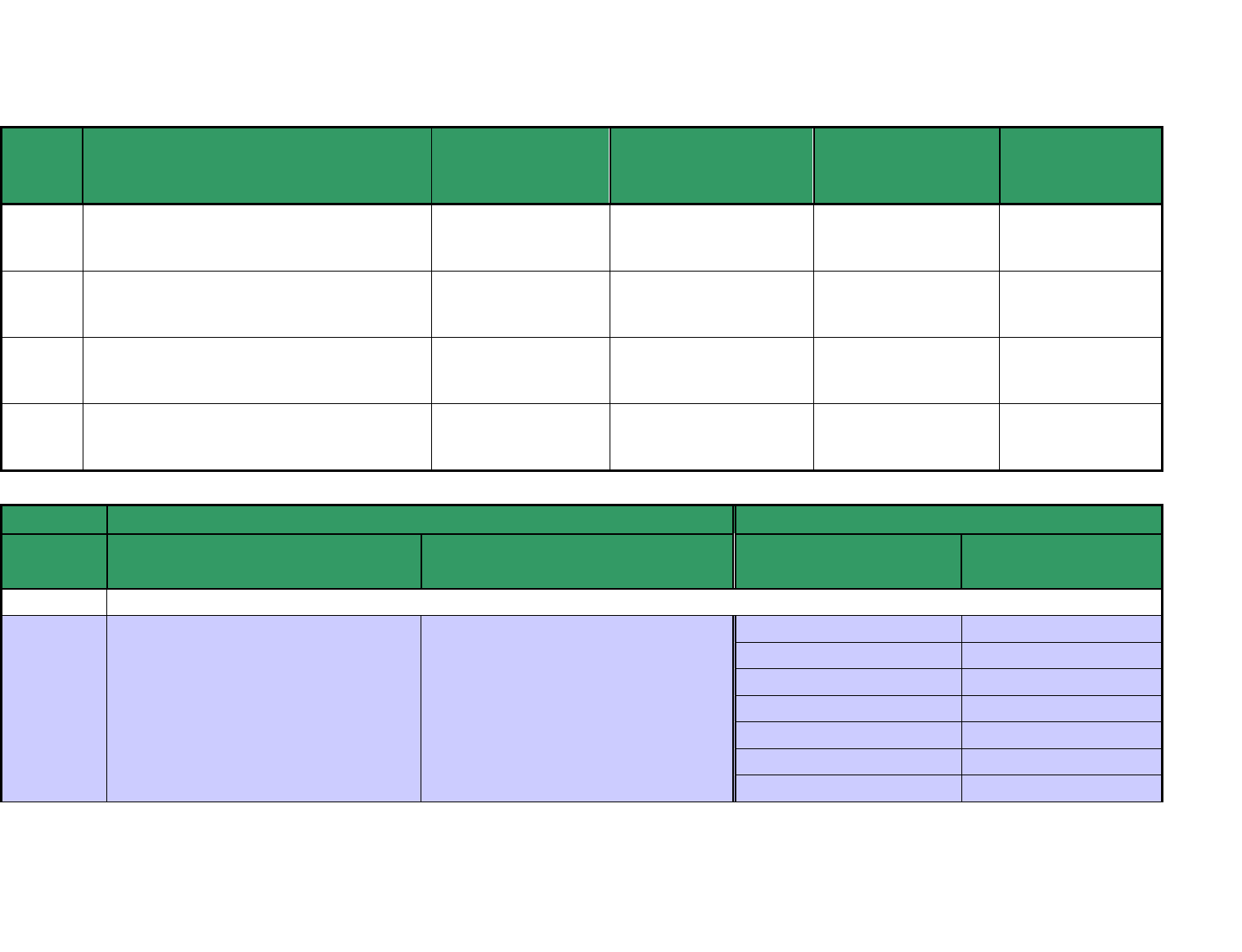
S/1319/2015
Annex 2
Appendix 6
page 119
Entry
number
Item description
Evidence reference
number
Where the evidence was
found/collected
Date and time
handed over
By whom was
found/collected
43.
21SDS 2015-07-23-1008-09 Handed over by CVDCS 23/07/2015 14:25 FFM-Alpha
44.
22SDS 2015-07-23-1008-10 Handed over by CVDCS 23/07/2015 14:25 FFM-Alpha
45.
23SDS 2015-07-23-1008-11 Handed over by CVDCS 23/07/2015 14:25 FFM-Alpha
46.
24SLS 2015-07-23-1008-12 Handed over by CVDCS 23/07/2015 14:25 FFM-Alpha
6.2 Electronic files collected by the investigation team
Folders Files
Interview
Number
Original name Name translated to English Original name
Name translated to
English
1006 No electronic evidence was handed over to the team
1011 16 March 2015\Qmenas 16 March 2015\Qmenas
IMG_7516 IMG_7516
IMG_7517 IMG_7517
IMG_7518 IMG_7518
IMG_7519 IMG_7519
IMG_7520 IMG_7520
IMG_7521 IMG_7521
IMG_7522 IMG_7522
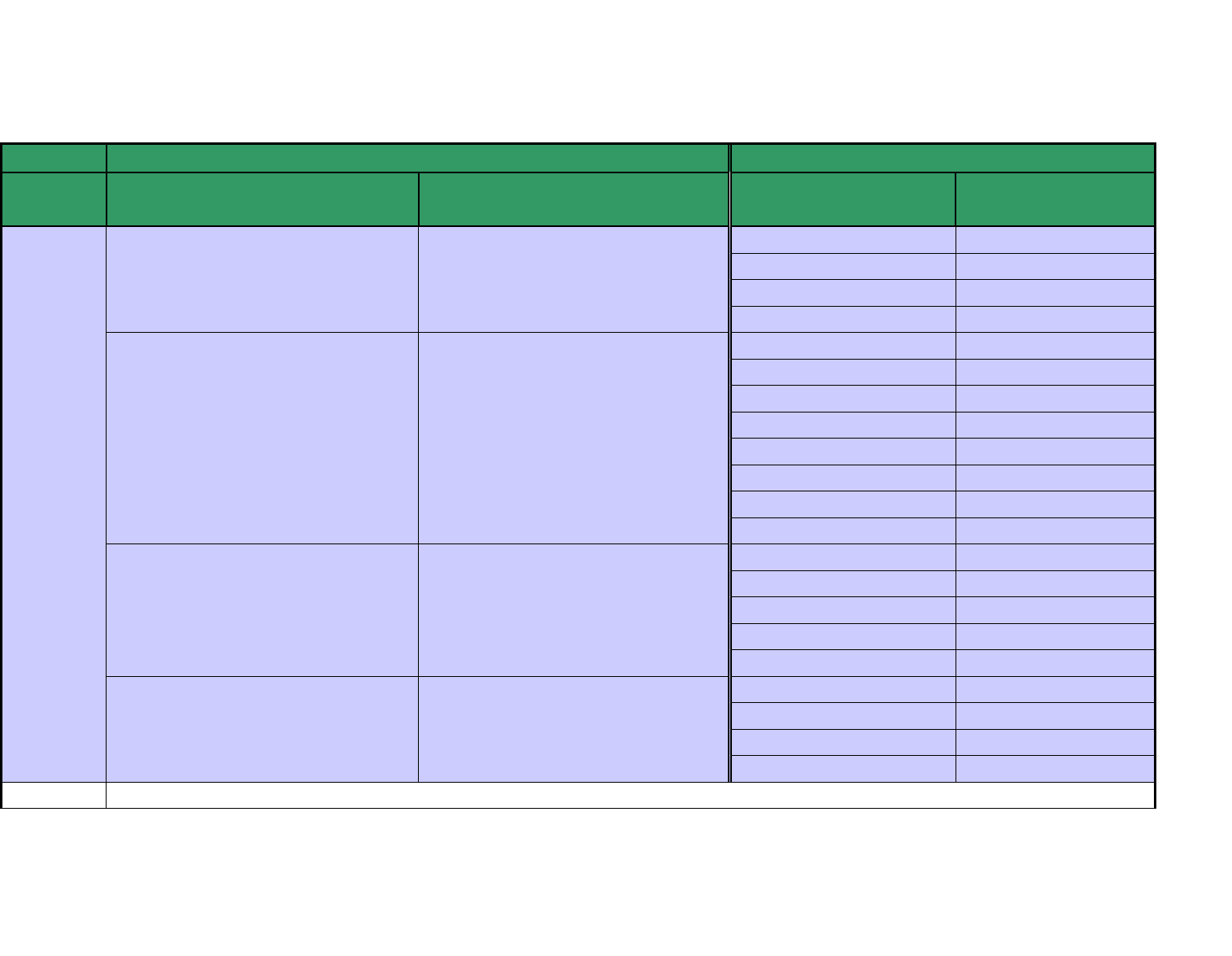
S/1319/2015
Annex 2
Appendix 6
page 120
Folders Files
Interview
Number
Original name Name translated to English Original name
Name translated to
English
IMG_7523 IMG_7523
IMG_7524 IMG_7524
IMG_7525 IMG_7525
IMG_7526 IMG_7526
16 March 2015\Sarmin 16 March 2015\Sarmin
IMG_7527 IMG_7527
IMG_7528 IMG_7528
IMG_7529 IMG_7529
IMG_7530 IMG_7530
IMG_7531 IMG_7531
IMG_7532 IMG_7532
IMG_7533 IMG_7533
IMG_7534 IMG_7534
16 May 2015 16 May 2015
IMG_9156 IMG_9156
IMG_9157 IMG_9157
IMG_9158 IMG_9158
IMG_9159 IMG_9159
IMG_9161 IMG_9161
20 May 2015 20 May 2015
MVI_9228 MVI_9228
MVI_9229 MVI_9229
IMG_9230 IMG_9230
IMG_9231 IMG_9231
1019 No electronic evidence was handed over to the team

S/1319/2015
Annex 2
Appendix 6
page 121
Folders Files
Interview
Number
Original name Name translated to English Original name
Name translated to
English
1018 No electronic evidence was handed over to the team
1021
16-5- 2015 Sarmin 16-5-2015
SAM_1478 SAM_1478
SAM_1479 SAM_1479
SAM_1483 SAM_1483
23-3- 2015 Sarmin 23-3-2015
HDV_0179 HDV_0179
SAM_0221 SAM_0221
SAM_0223 SAM_0223
SAM_0224 SAM_0224
SAM_0225 SAM_0225
SAM_0226 SAM_0226
SAM_0227 SAM_0227
SAM_0228 SAM_0228
SAM_0229 SAM_0229
SAM_0230 SAM_0230
16-4-2015 Idlib chlorine 16-4-2015
SAM_0792 SAM_0792
SAM_0793 SAM_0793
SAM_0794 SAM_0794
SAM_0797 SAM_0797
SAM_0798 SAM_0798
SAM_0799 SAM_0799
SAM_0802 SAM_0802
SAM_0803 SAM_0803
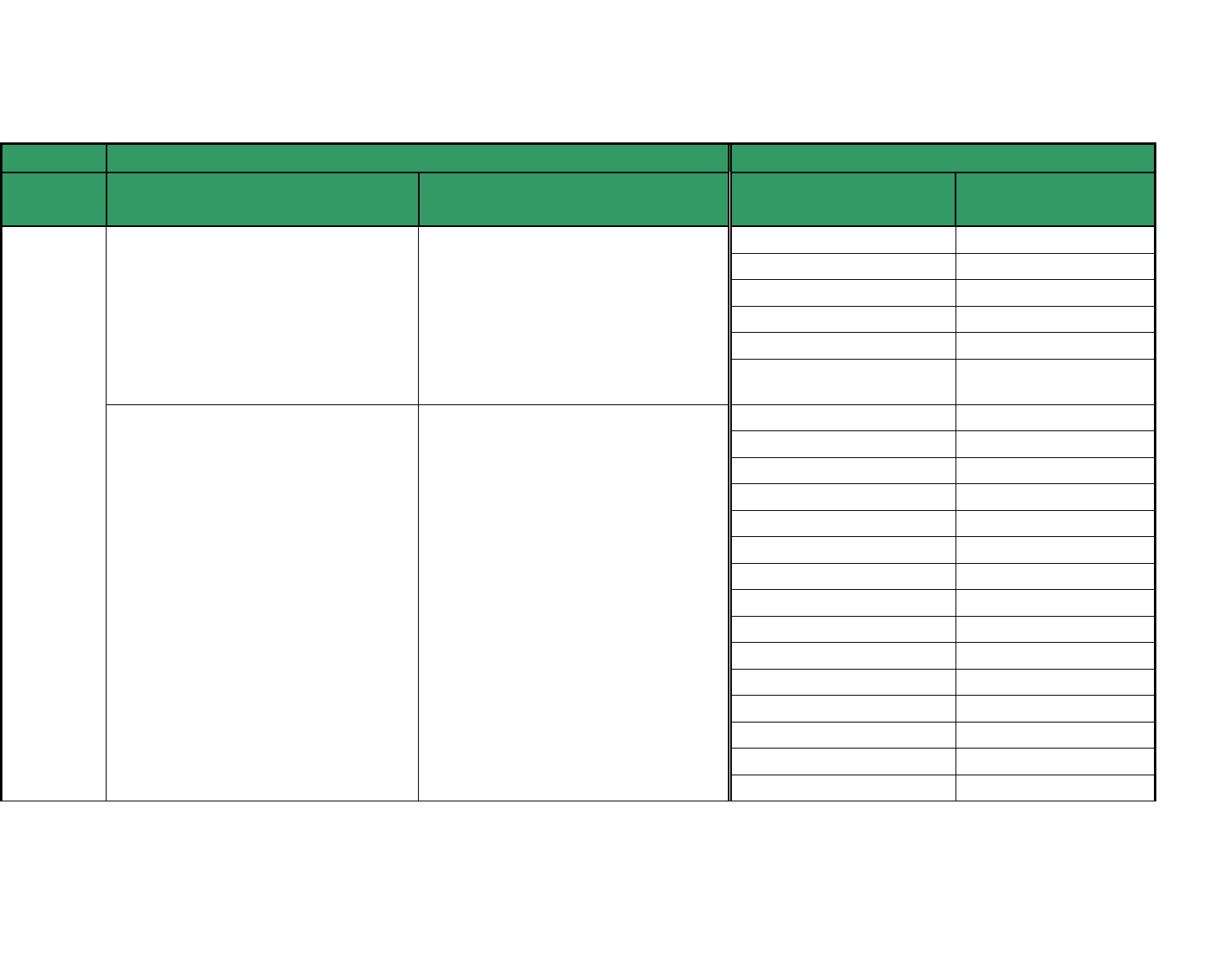
S/1319/2015
Annex 2
Appendix 6
page 122
Folders Files
Interview
Number
Original name Name translated to English Original name
Name translated to
English
SAM_0804 SAM_0804
SAM_0805 SAM_0805
SAM_0806 SAM_0806
SAM_0807 SAM_0807
SAM_0808 SAM_0808
16-4-2015
Idlib chlorine 16-4-
2015
2 -5-2015 Nayrab 2-5-2015
SAM_1044 SAM_1044
SAM_1045 SAM_1045
SAM_1046 SAM_1046
SAM_1047 SAM_1047
SAM_1048 SAM_1048
SAM_1049 SAM_1049
SAM_1050 SAM_1050
SAM_1051 SAM_1051
SAM_1052 SAM_1052
SAM_1053 SAM_1053
SAM_1054 SAM_1054
SAM_1055 SAM_1055
SAM_1056 SAM_1056
SAM_1057 SAM_1057
SAM_1058 SAM_1058
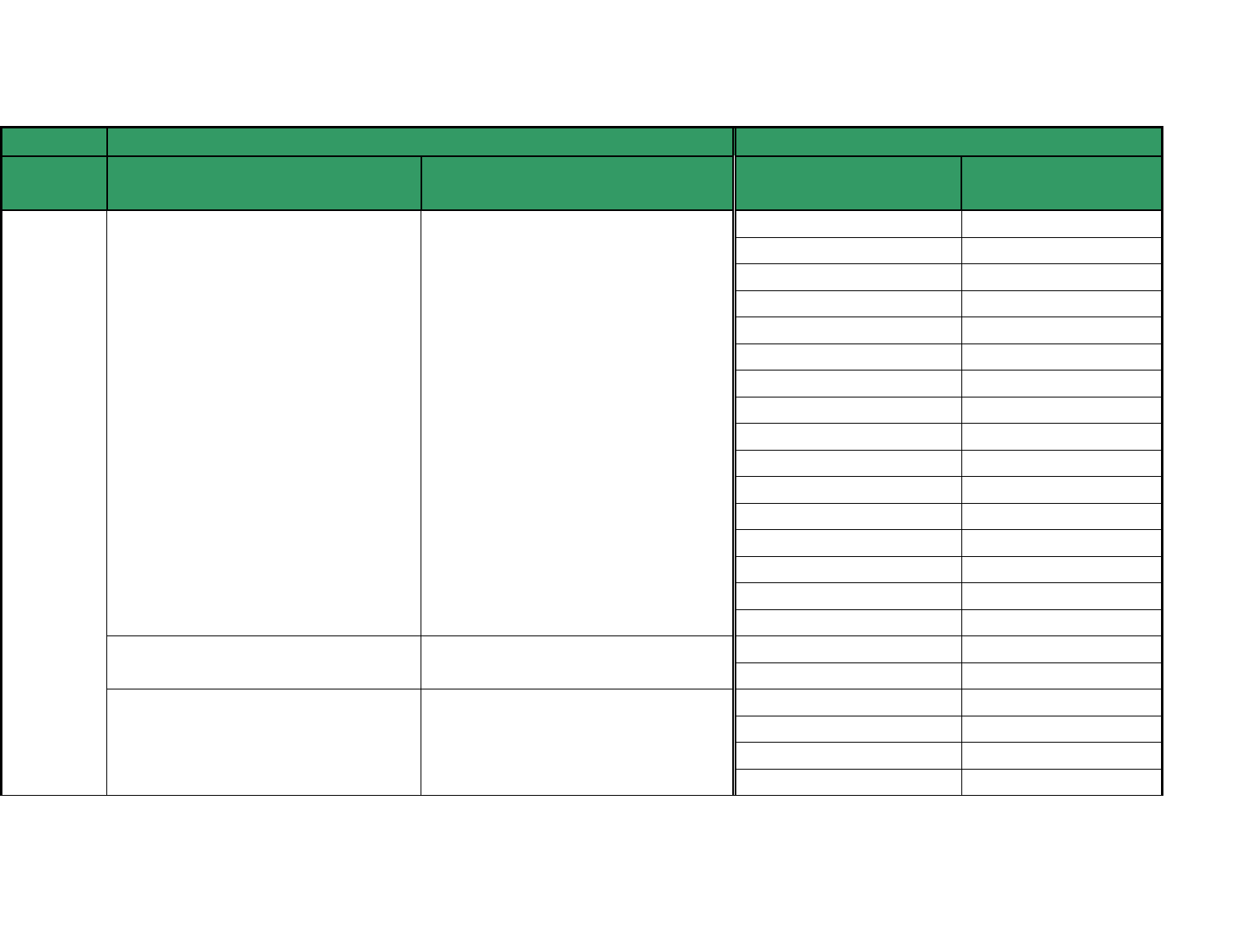
S/1319/2015
Annex 2
Appendix 6
page 123
Folders Files
Interview
Number
Original name Name translated to English Original name
Name translated to
English
SAM_1059 SAM_1059
SAM_1060 SAM_1060
SAM_1061 SAM_1061
SAM_1062 SAM_1062
SAM_1063 SAM_1063
SAM_1064 SAM_1064
SAM_1066 SAM_1066
SAM_1067 SAM_1067
SAM_1068 SAM_1068
SAM_1069 SAM_1069
SAM_1070 SAM_1070
SAM_1071 SAM_1071
SAM_1072 SAM_1072
SAM_1073 SAM_1073
SAM_1074 SAM_1074
SAM_1075 SAM_1075
Recording
voice 005 voice 005
voice 007 voice 007
Collecting samples
IMG_7516 IMG_7516
IMG_7517 IMG_7517
IMG_7518 IMG_7518
IMG_7519 IMG_7519

S/1319/2015
Annex 2
Appendix 6
page 124
Folders Files
Interview
Number
Original name Name translated to English Original name
Name translated to
English
IMG_7520 IMG_7520
IMG_7521 IMG_7521
IMG_7522 IMG_7522
IMG_7523 IMG_7523
IMG_7524 IMG_7524
IMG_7525 IMG_7525
IMG_7526 IMG_7526
IMG_7527 IMG_7527
IMG_7528 IMG_7528
IMG_7529 IMG_7529
IMG_7530 IMG_7530
IMG_7531 IMG_7531
IMG_7532 IMG_7532
IMG_7533 IMG_7533
IMG_7534 IMG_7534
IMG_7535 IMG_7535
Samples
1 1
2 2
3 3
4 4
5 5
6 6

S/1319/2015
Annex 2
Appendix 6
page 125
Folders Files
Interview
Number
Original name Name translated to English Original name
Name translated to
English
7 7
8 8
9 9
10 10
11 11
SAM_1484 SAM_1484
SAM_1486 SAM_1486
SAM_1487 SAM_1487
SAM_1488 SAM_1488
SAM_1489 SAM_1489
SAM_1490 SAM_1490
SAM_1491 SAM_1491
SAM_1492 SAM_1492
SAM_1493 SAM_1493
SAM_1494 SAM_1494
SAM_1495 SAM_1495
SAM_1496 SAM_1496
SAM_1497 SAM_1497
SAM_1498 SAM_1498
Samples measure
IMG-20150430-WA0021
IMG-20150430-
WA0021
IMG-20150510-WA0009 IMG-20150510-

S/1319/2015
Annex 2
Appendix 6
page 126
Folders Files
Interview
Number
Original name Name translated to English Original name
Name translated to
English
WA0009
IMG-20150510-WA0010
IMG-20150510-
WA0010
IMG-20150510-WA0011
IMG-20150510-
WA0011
IMG-20150510-WA0012
IMG-20150510-
WA0012
IMG-20150510-WA0013
IMG-20150510-
WA0013
IMG-20150510-WA0014
IMG-20150510-
WA0014
IMG-20150510-WA0016
IMG-20150510-
WA0016
IMG-20150510-WA0017
IMG-20150510-
WA0017
16-3 Chlorine massacre Sarmin 16-3
_ 20150316_212434
_ 20150316_213147
IMG_7440 IMG_7440
IMG_7459 IMG_7459
IMG_7460 IMG_7460
IMG_7466 IMG_7466
IMG_7472 IMG_7472
IMG_7485 IMG_7485

S/1319/2015
Annex 2
Appendix 6
page 127
Folders Files
Interview
Number
Original name Name translated to English Original name
Name translated to
English
MVI_7457 MVI_7457
MVI_7462 MVI_7462
SAM_0098 SAM_0098
SAM-0113 SAM-0113
Wounding a member
of the civil defense
Important meeting
_ 20150316_212434
_ 20150316_213147
_ 20150217_020645
SAM_0117 SAM_0117
SAM_0140 SAM_0140
1013 No electronic evidence was handed over to the team
1015 No electronic evidence was handed over to the team
1012 16-3-2015 Chlorine Idlib Sarmin documentation
)1(
Photos of one of the
injuries Sarmin (1)
)1(
Photos of one of the
injuries Sarmin (1)
)59048449(
Photos of one of the
injuries Sarmin
(59048449)

S/1319/2015
Annex 2
Appendix 6
page 128
Folders Files
Interview
Number
Original name Name translated to English Original name
Name translated to
English
)59048450(
Photos of one of the
injuries Sarmin
(59048450)
Video ambulance
transporting one child
to the hospital
2-5 -2105
Chlorine documenting the town of
Idlib Neirab 05/02/2105
A children's injuries
chlorine in the town of
Neirab
One injured gases
One injured gas
One young civil
defense has in hand
samples for chlorine,
which targeted the
town of Neirab
One casualty of
chlorine gas from the
Neirab town
5 -2-
2015
Child Martyr Mustafa
Haj Ali, who died
from chlorine gas, who
was on the town
Neirab 05/02/2015

S/1319/2015
Annex 2
Appendix 6
page 129
Folders Files
Interview
Number
Original name Name translated to English Original name
Name translated to
English
The civil defense
elements in the place
of execution town
Neirab
2 -5-2015 )1(
Photos of the child
Mustafa martyr who
died from chlorine
gases Neirab
02.05.2015 (1)
2 -5-2015 )1(
Photos of the child
Mustafa martyr who
died from chlorine
gases Neirab
02.05.2015 (1)
2-5 -2015
)42861057(
Photos of the child
Mustafa martyr who
died from chlorine
gases Neirab
02.05.2015
(42861057)
2-5 -2015
)42861058(
Photos of the child
Mustafa martyr who
died from chlorine
gases Neirab
02.05.2015
(42861058)

S/1319/2015
Annex 2
Appendix 6
page 130
Folders Files
Interview
Number
Original name Name translated to English Original name
Name translated to
English
2-5 -2015
)42861059(
Photos of the child
Mustafa martyr who
died from chlorine
gases Neirab
02.05.2015
(42861059)
Image samples that
targeted the town of
Neirab
2
Image samples that
targeted the town of
Neirab 2
2-5 -2105
Chlorine documenting the city of
Idlib Sracb 05/02/2105
2_5-20215 )1(
Photos for injuries in
Sracb 2_5-20215 (1)
2_5-20215 )1(
Photos for injuries in
Sracb 2_5-20215 (1)
2_5-20215 )42861057(
Photos for injuries in
Sracb 2_5-20215
(42861057)
2_5-20215 )42861058(
Photos for injuries in
Sracb 2_5-20215
(42861058)
2_5-20215 )42861059(
Photos for injuries in
Sracb 2_5-20215
(42861059)
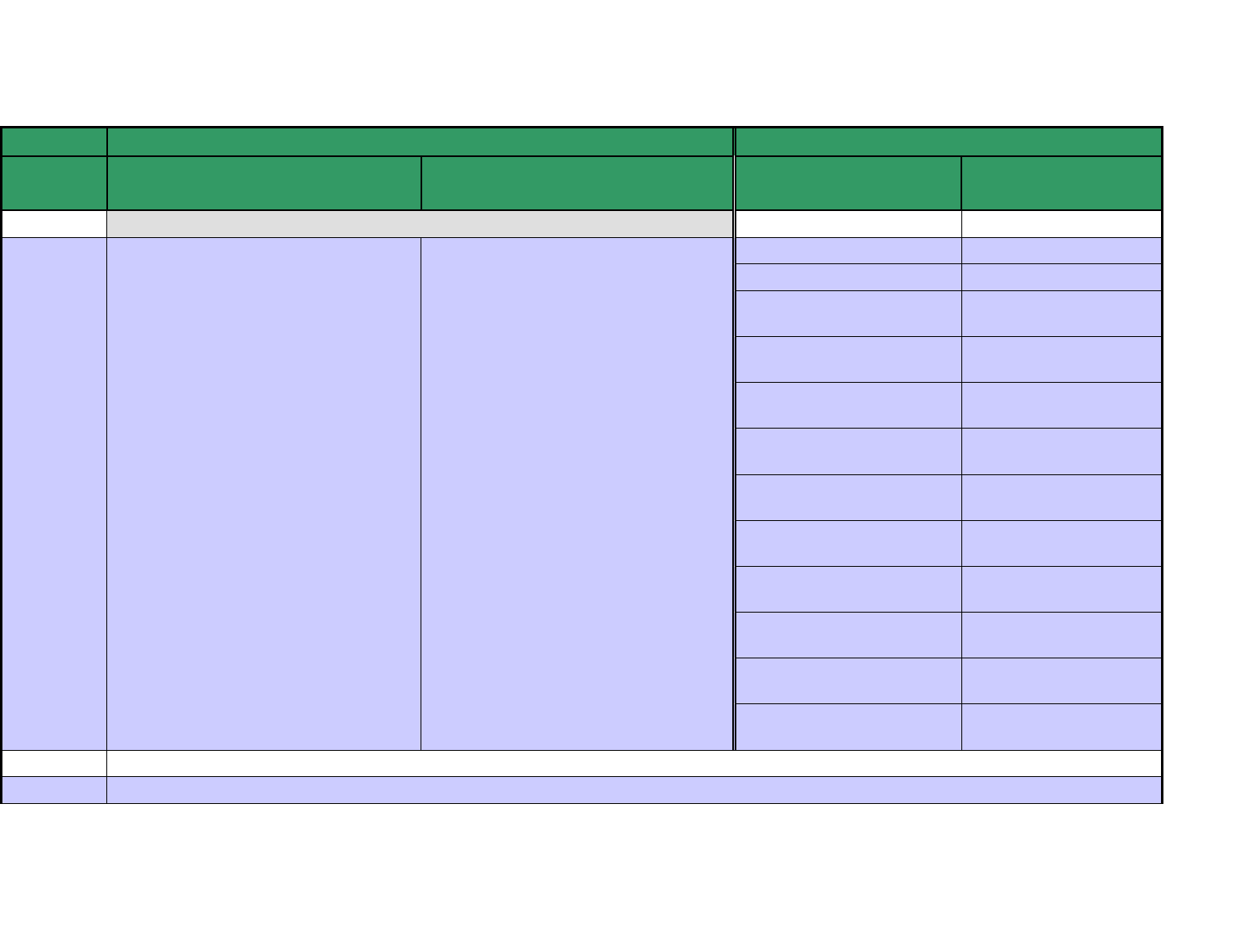
S/1319/2015
Annex 2
Appendix 6
page 131
Folders Files
Interview
Number
Original name Name translated to English Original name
Name translated to
English
1016 MVI_8145 MVI_8145
1024 20150605102503 20150605102503
20150428_204550 20150428_204550
20150428_211156 20150428_211156
IMG-20150605-WA0000
IMG-20150605-
WA0000
IMG-20150605-WA0001
IMG-20150605-
WA0001
IMG-20150605-WA0002
IMG-20150605-
WA0002
IMG-20150605-WA0003
IMG-20150605-
WA0003
IMG-20150605-WA0004
IMG-20150605-
WA0004
IMG-20150605-WA0005
IMG-20150605-
WA0005
IMG-20150605-WA0006
IMG-20150605-
WA0006
IMG-20150605-WA0007
IMG-20150605-
WA0007
IMG-20150605-WA0008
IMG-20150605-
WA0008
IMG-20150605-WA0009
IMG-20150605-
WA0009
1037 No electronic evidence was handed over to the team
1005 No electronic evidence was handed over to the team

S/1319/2015
Annex 2
Appendix 6
page 132
Folders Files
Interview
Number
Original name Name translated to English Original name
Name translated to
English
1007
USB handover
20150523100701\\Report\Photo
es\Where the family killed
USB handover
20150523100701\Chlorine\Report\P
hotoes\Where the family killed
Place of chemical (1) Place of chemical (1)
Place of chemical
(340904029)
Place of chemical
(340904029)
Place of chemical
(340904031)
Place of chemical
(340904031)
USB handover
20150523100701\\Report\Photo
es
USB handover
20150523100701\Chlorine\Report\P
hotoes
IMG_8732 IMG_8732
IMG_8734 IMG_8734
IMG_8739 IMG_8739
IMG-20150317-WA0005
IMG-20150317-
WA0005
IMG-20150317-WA0006
IMG-20150317-
WA0006
Oldman (1) O l d m a n (1)
Oldman (1) Oldman (1)
USB handover
20150523100701\\Report
USB handover
20150523100701\Chlorine\Report
Report

S/1319/2015
Annex 2
Appendix 6
page 133
Folders Files
Interview
Number
Original name Name translated to English Original name
Name translated to
English
USB handover
20150523100701\\
\New folder
USB handover
20150523100701\Chlorine\Photos
and video Chlorine\New Folder
IMG_7304 IMG_7304
IMG_7309 IMG_7309
IMG_7310 IMG_7310
IMG_7436 IMG_7436
IMG_7444 IMG_7444
IMG_7470 IMG_7470
IMG_7484 IMG_7484
IMG_7485 IMG_7485
IMG_7452 IMG_7452
SAM_0100 SAM_0100
SAM_0101 SAM_0101
SAM_0102 SAM_0102
SAM_0106 SAM_0106
SAM_0110 SAM_0110
SAM_0111 SAM_0111
SAM_0112 SAM_0112
SAM_0119 SAM_0119
SAM_0120 SAM_0120
SAM_0122 SAM_0122
SAM_0128 SAM_0128

S/1319/2015
Annex 2
Appendix 6
page 134
Folders Files
Interview
Number
Original name Name translated to English Original name
Name translated to
English
SAM_0137 SAM_0137
SAM_0140 SAM_0140
SAM_0143 SAM_0143
SAM_0155 SAM_0155
USB handover
20150523100701\\
USB handover
20150523100701\Chlorine\Photos
and video Chlorine
IMG_7304 IMG_7304
IMG_7309 IMG_7309
IMG_7310 IMG_7310
IMG_7436 IMG_7436
IMG_7444 IMG_7444
IMG_7470 IMG_7470
IMG_7484 IMG_7484
IMG_7485 IMG_7485
MVI_7434 MVI_7434
MVI_7449 MVI_7449
MVI_7452 MVI_7452
MVI_7457 MVI_7457
MVI_7462 MVI_7462
MVI_74491 MVI_74491
MVI_74521 MVI_74521
SAM_0099 SAM_0099
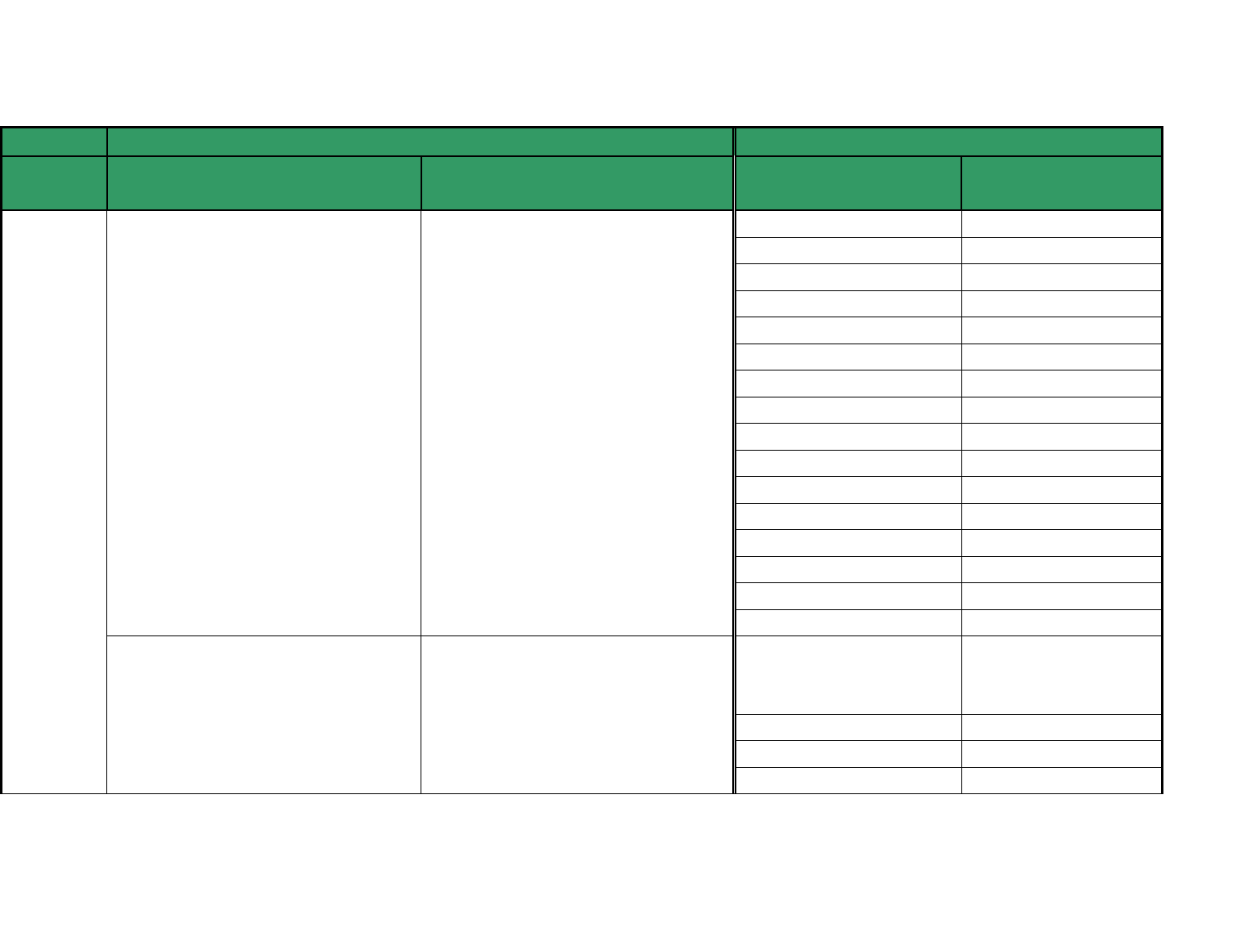
S/1319/2015
Annex 2
Appendix 6
page 135
Folders Files
Interview
Number
Original name Name translated to English Original name
Name translated to
English
SAM_0100 SAM_0100
SAM_0101 SAM_0101
SAM_0102 SAM_0102
SAM_0106 SAM_0106
SAM_0110 SAM_0110
SAM_0111 SAM_0111
SAM_0112 SAM_0112
SAM_0119 SAM_0119
SAM_0120 SAM_0120
SAM_0122 SAM_0122
SAM_0128 SAM_0128
SAM_0137 SAM_0137
SAM_0140 SAM_0140
SAM_0142 SAM_0142
SAM_0143 SAM_0143
SAM_0155 SAM_0155
USB handover
20150523100701\\
USB handover
20150523100701\Chlorine\Chlorine
Hama
M2U00088 M2U00088
M2U00090 M2U00090
M2U00091 M2U00091
M2U00092 M2U00092
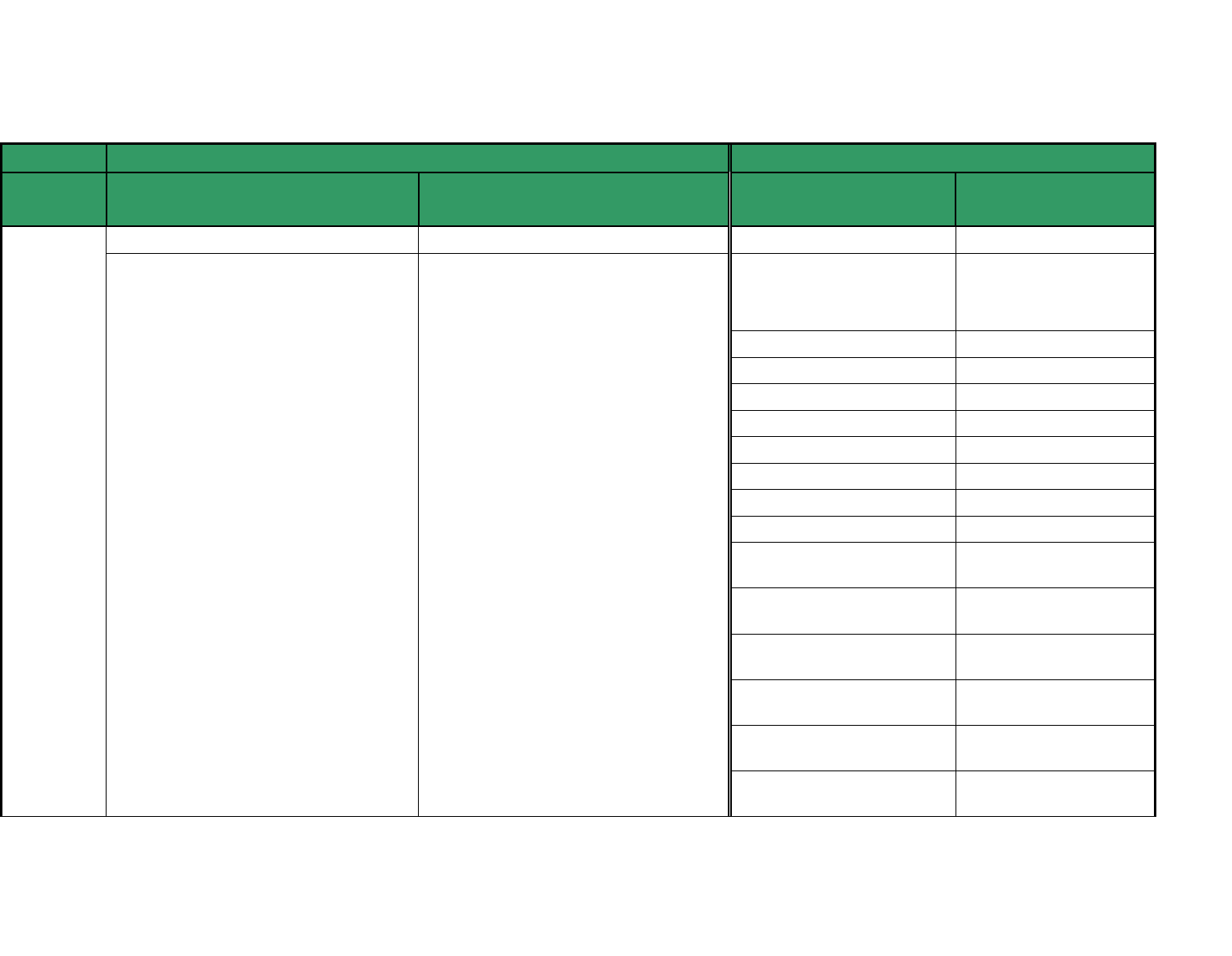
S/1319/2015
Annex 2
Appendix 6
page 136
Folders Files
Interview
Number
Original name Name translated to English Original name
Name translated to
English
M2U00093 M2U00093
USB handover
20150523100701\ 1\
USB handover
20150523100701\Chlorine
1\Chlorine videos and photos
Idlib map new draft Idlib map new draft
IMG_7304 IMG_7304
IMG_7309 IMG_7309
IMG_7310 IMG_7310
IMG_7436 IMG_7436
IMG_7444 IMG_7444
IMG_7470 IMG_7470
IMG_7484 IMG_7484
IMG_7485 IMG_7485
IMG-20150318-WA0001
IMG-20150318-
WA0001
IMG-20150318-WA0011
IMG-20150318-
WA0011
IMG-20150318-WA0012
IMG-20150318-
WA0012
IMG-20150318-WA0013
IMG-20150318-
WA0013
IMG-20150318-WA0014
IMG-20150318-
WA0014
IMG-20150318-WA0015
IMG-20150318-
WA0015
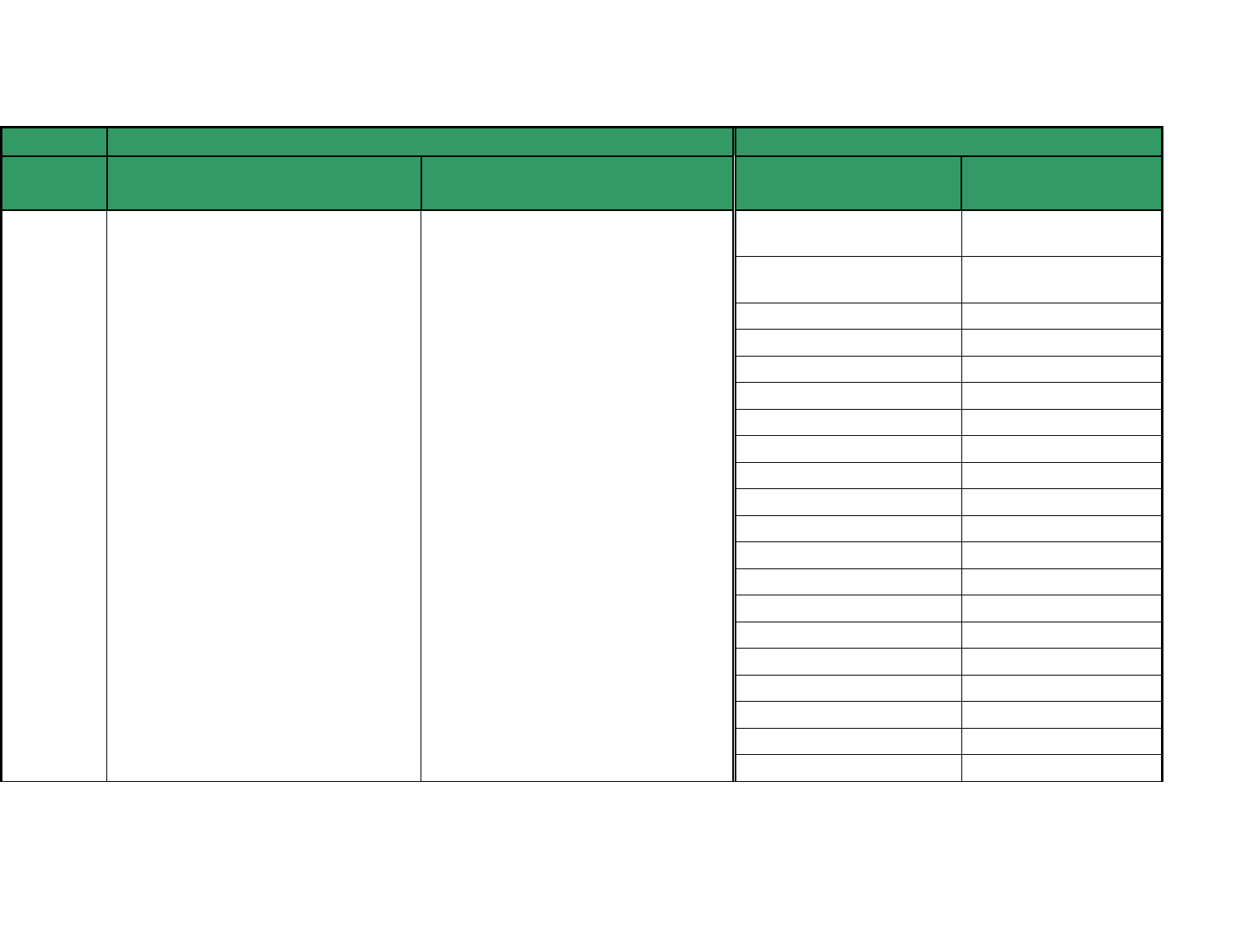
S/1319/2015
Annex 2
Appendix 6
page 137
Folders Files
Interview
Number
Original name Name translated to English Original name
Name translated to
English
IMG-20150417-WA0008
IMG-20150417-
WA0008
IMG-20150417-WA0009
IMG-20150417-
WA0009
MVI_7434 MVI_7434
MVI_7449 MVI_7449
MVI_7452 MVI_7452
MVI_7457 MVI_7457
MVI_7462 MVI_7462
MVI_74491 MVI_74491
MVI_74521 MVI_74521
SAM_0099 SAM_0099
SAM_0100 SAM_0100
SAM_0101 SAM_0101
SAM_0102 SAM_0102
SAM_0106 SAM_0106
SAM_0110 SAM_0110
SAM_0111 SAM_0111
SAM_0112 SAM_0112
SAM_0119 SAM_0119
SAM_0120 SAM_0120
SAM_0122 SAM_0122

S/1319/2015
Annex 2
Appendix 6
page 138
Folders Files
Interview
Number
Original name Name translated to English Original name
Name translated to
English
SAM_0128 SAM_0128
SAM_0137 SAM_0137
SAM_0140 SAM_0140
SAM_0142 SAM_0142
SAM_0143 SAM_0143
SAM_0155 SAM_0155
USB handover
20150523100701\ 1
USB handover
20150523100701\Chlorine 1
Sarmin chlorine attacks
16 march 2015
Sarmin chlorine
attacks 16 march 2015
Binnish Chemical
attack
Qmenas gas attack
2 Chemical Sarmin 2
Chemical Sarmin
Report
USB handover 20150523100701 USB handover 20150523100701
1 1 chlorine attack total
IMG_5130 IMG_5130
IMG_5131 IMG_5131
IMG_5132 IMG_5132
IMG_5133 IMG_5133
uSD Pdf handover 20150524100703 uSD Pdf handover 20150524100703 ____
19-5 -2015 - -
Chlorine attack on
Michmach town 19-5-
2015- - Copy___
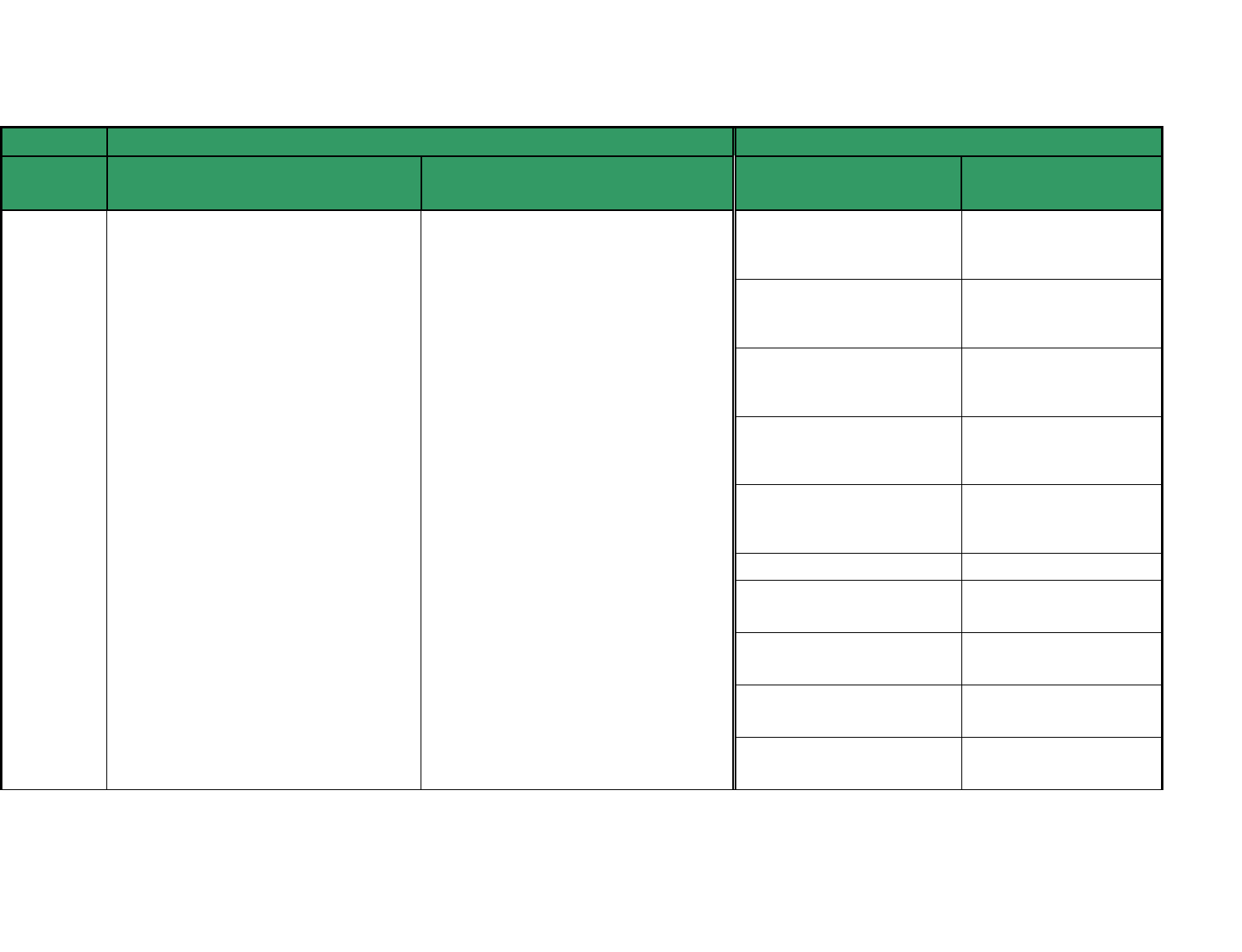
S/1319/2015
Annex 2
Appendix 6
page 139
Folders Files
Interview
Number
Original name Name translated to English Original name
Name translated to
English
___
19-5 -2015 -
Chlorine attack on El
Bechir town 19-5-
2015___
___
19-5 -2015 -
Chlorine attack on
Idlib City 19-5-
2015___
__
17-5 -2015 -
Chlorine attack on
Michmach town 17-5-
2015- Copy___
_
7-5 -2015
Chlorine attack on EL
Jadhoudya town 7-5-
2015_
_
17-5 -2015
Chlorine attack on EL
Kesten town 17-5-
2015_
1 1 chlorine attack total
2 -
5
Chlorine attack on EL
Nirab town - 2 5
2 27-4 -2015
Chlorine attack on EL
Nirab town -27-4-2015
6-
5-2015
Chlorine attack on El
Bechir town 6-5-2015
10-5 -2015
Chlorine attack on El
Bechir town 10-5-
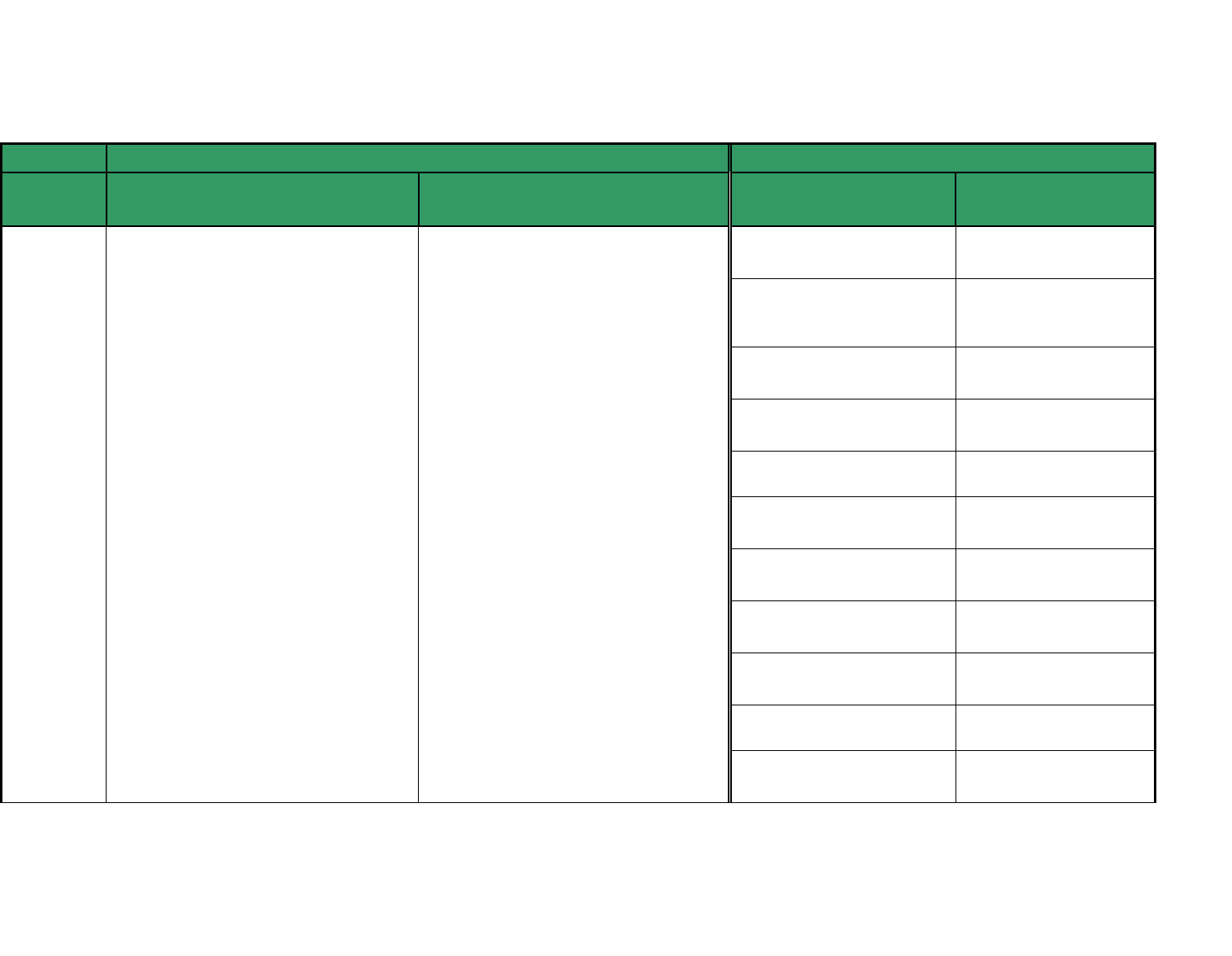
S/1319/2015
Annex 2
Appendix 6
page 140
Folders Files
Interview
Number
Original name Name translated to English Original name
Name translated to
English
2015
15-5 -2015
Chlorine attack on
Michmach town 15-5-
2015
24 -3-
2015
Chlorine attack on
Binnish 24-3-2015
2 - 5-
2015
Chlorine attack on
Saraqeb 2-5-2015
26-4
Chlorine attack on
Saraqeb 26-4
26-3 -2015
Chlorine attack on
Sarmin 26-3-2015
24-3 -
2105
Chlorine attack on
Qaminas 24-3-2015
03 -05
-2015
Chlorine attack on
Kansaqra 03-05-2015
2015 -
7-5
Chlorine attack on
Kansaqra 7-5-2015
16-4 -
2015
Attack on Idlib city
16-5-2015
16-5 -2015
Attack on Sarmin city
16-5-2015

S/1319/2015
Annex 2
Appendix 6
page 141
Folders Files
Interview
Number
Original name Name translated to English Original name
Name translated to
English
23-3 -2015
Chemicals Sarmin 23-
3-2015
16-3 -
2015
Chemicals Sarmin
Report 13-3-2015
26 -4-2015
Chlorine Kafer Awid
26-4-2015
03-05 -2015
Kansaqra 03-05-2015
names of chlorine
victims
Video 20150523100702 Video 20150523100702
MAH00011 MAH00011
MAH00012 MAH00012
1009 No electronic evidence was handed over to the team
1017 No electronic evidence was handed over to the team
1014 No electronic evidence was handed over to the team
1023
DSC_0630 DSC_0630
FB_IMG_1431760728837
FB_IMG_1431760728
837
FB_IMG_1431760732808
FB_IMG_1431760732
808
IMG_39138753519733
IMG_3913875351973
3
SAM_1478 SAM_1478
1035 No electronic evidence was handed over to the team
1020 No electronic evidence was handed over to the team
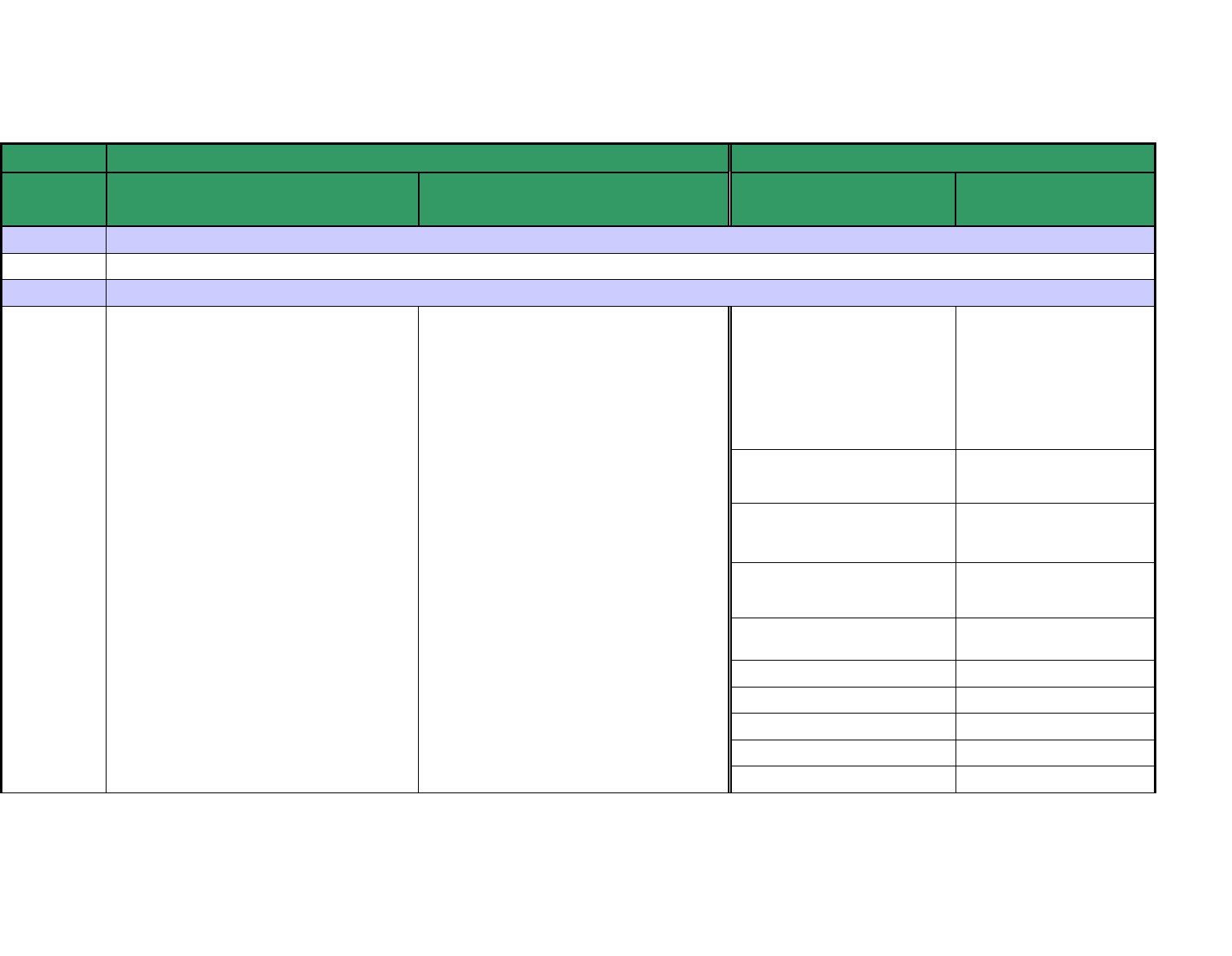
S/1319/2015
Annex 2
Appendix 6
page 142
Folders Files
Interview
Number
Original name Name translated to English Original name
Name translated to
English
1027 No electronic evidence was handed over to the team
1022 No electronic evidence was handed over to the team
1026 No electronic evidence was handed over to the team
1032
Recovered Files 09_06_2015
20_20\Recovered data 06-09-2015 at
20_33_04\FAT32\____\____ ______
Recovered Files 09_06_2015
20_20\Recovered data 06-09-2015 at
20_33_04\FAT32\____\____ ______
DSC00101 DSC00101
DSC00102 DSC00102
DSC00103 DSC00103
DSC00104 DSC00104
DSC00105 DSC00105
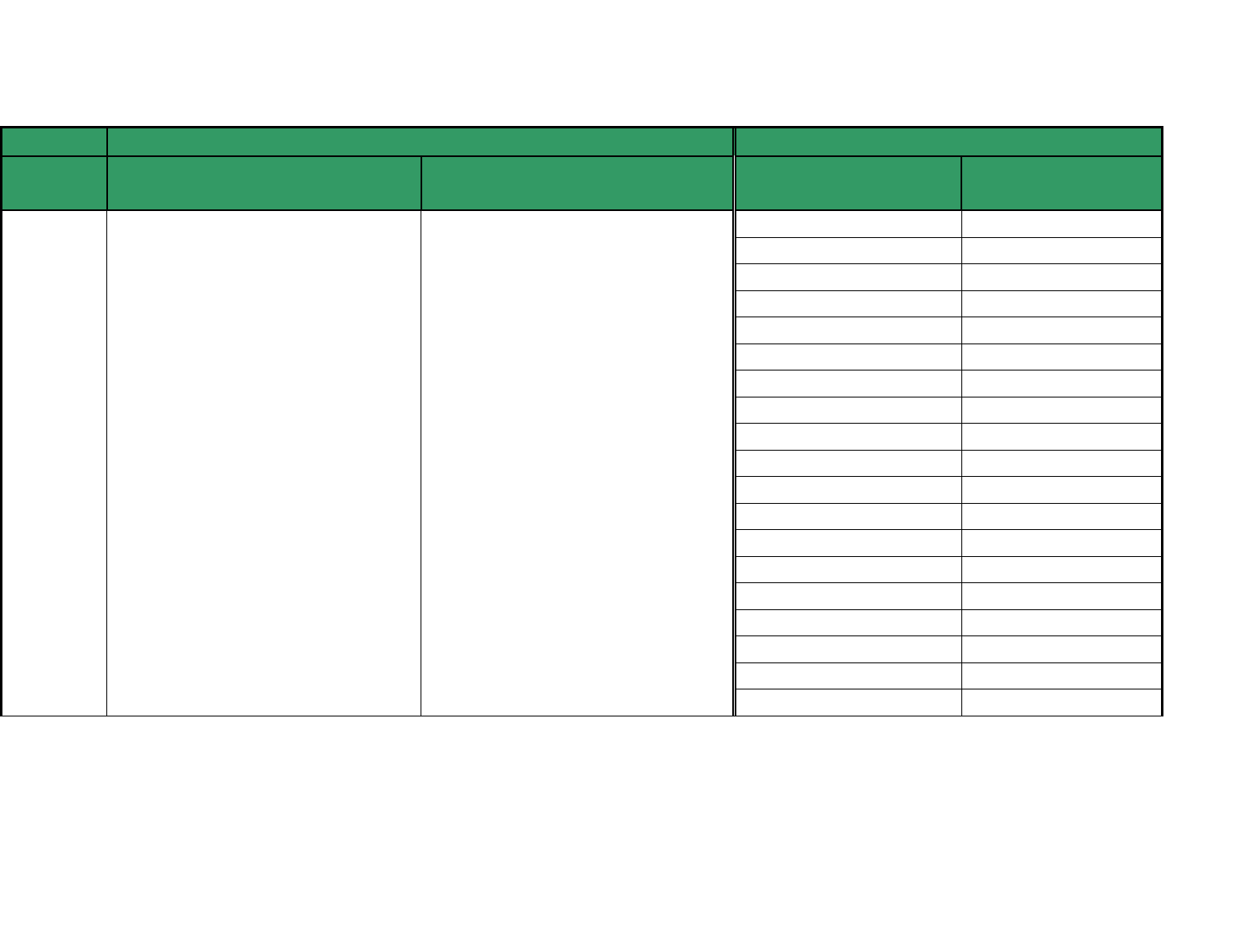
S/1319/2015
Annex 2
Appendix 6
page 143
Folders Files
Interview
Number
Original name Name translated to English Original name
Name translated to
English
DSC00106 DSC00106
DSC00107 DSC00107
DSC00108 DSC00108
DSC00109 DSC00109
DSC00110 DSC00110
DSC00111 DSC00111
DSC00112 DSC00112
DSC00113 DSC00113
DSC00114 DSC00114
DSC00115 DSC00115
DSC00116 DSC00116
DSC00117 DSC00117
DSC00118 DSC00118
DSC00119 DSC00119
DSC00120 DSC00120
DSC00121 DSC00121
DSC00122 DSC00122
DSC00123 DSC00123
DSC00124 DSC00124

S/1319/2015
Annex 2
Appendix 6
page 144
Folders Files
Interview
Number
Original name Name translated to English Original name
Name translated to
English
Recovered Files 09_06_2015
20_20\Recovered data 06-09-2015 at
20_33_04\FAT32\____\_____
Recovered Files 09_06_2015
20_20\Recovered data 06-09-2015 at
20_33_04\FAT32\____\_____
IMG_7516 IMG_7516
IMG_7517 IMG_7517
IMG_7518 IMG_7518
IMG_7519 IMG_7519
IMG_7520 IMG_7520
IMG_7522 IMG_7522
IMG_7523 IMG_7523
IMG_7524 IMG_7524
IMG_7525 IMG_7525
IMG_7526 IMG_7526
IMG_7527 IMG_7527
IMG_7528 IMG_7528
IMG_7529 IMG_7529
IMG_7530 IMG_7530
IMG_7531 IMG_7531
IMG_7532 IMG_7532
IMG_7533 IMG_7533
IMG_7534 IMG_7534
IMG_7535 IMG_7535
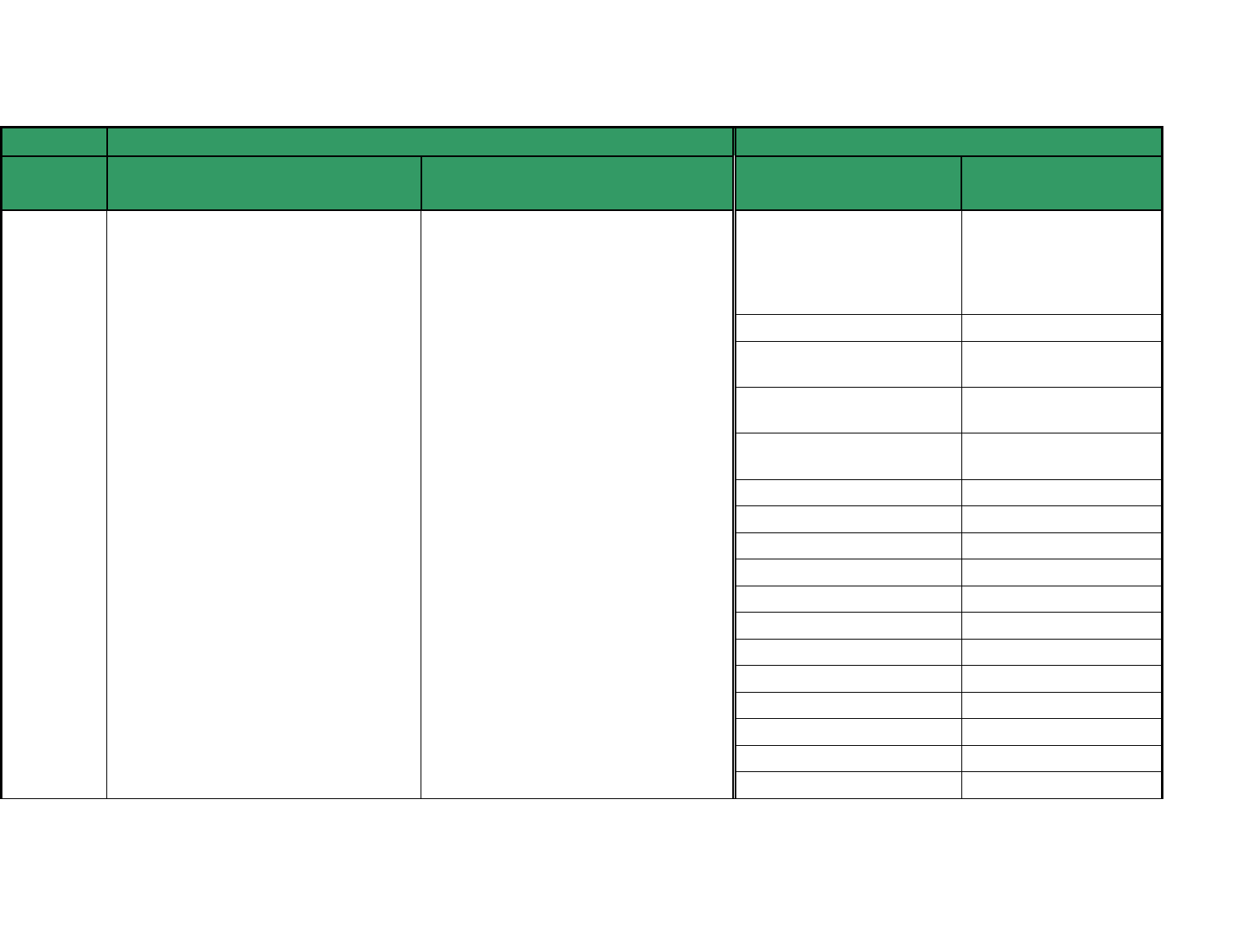
S/1319/2015
Annex 2
Appendix 6
page 145
Folders Files
Interview
Number
Original name Name translated to English Original name
Name translated to
English
Recovered Files 09_06_2015
20_20\Recovered data 06-09-2015 at
20_33_04\FAT32\____
Recovered Files 09_06_2015
20_20\Recovered data 06-09-2015 at
20_33_04\FAT32\____
#MG_8408 #MG_8408
#VI_7566 #VI_7566
_____ ___ _____ ______
______
_____ ___ _____
______ ______
_____ ___ _______
______ ____ __
_____ ___ _______
______ ____ __
_____ ___ _______
______ ____
_____ ___ _______
______ ____
24-3-2015 24-3-2015
IMG_7286 IMG_7286
IMG_7287 IMG_7287
IMG_7288 IMG_7288
IMG_7289 IMG_7289
IMG_7290 IMG_7290
IMG_7291 IMG_7291
IMG_7292 IMG_7292
IMG_7293 IMG_7293
IMG_7295 IMG_7295
IMG_7296 IMG_7296
IMG_7298 IMG_7298
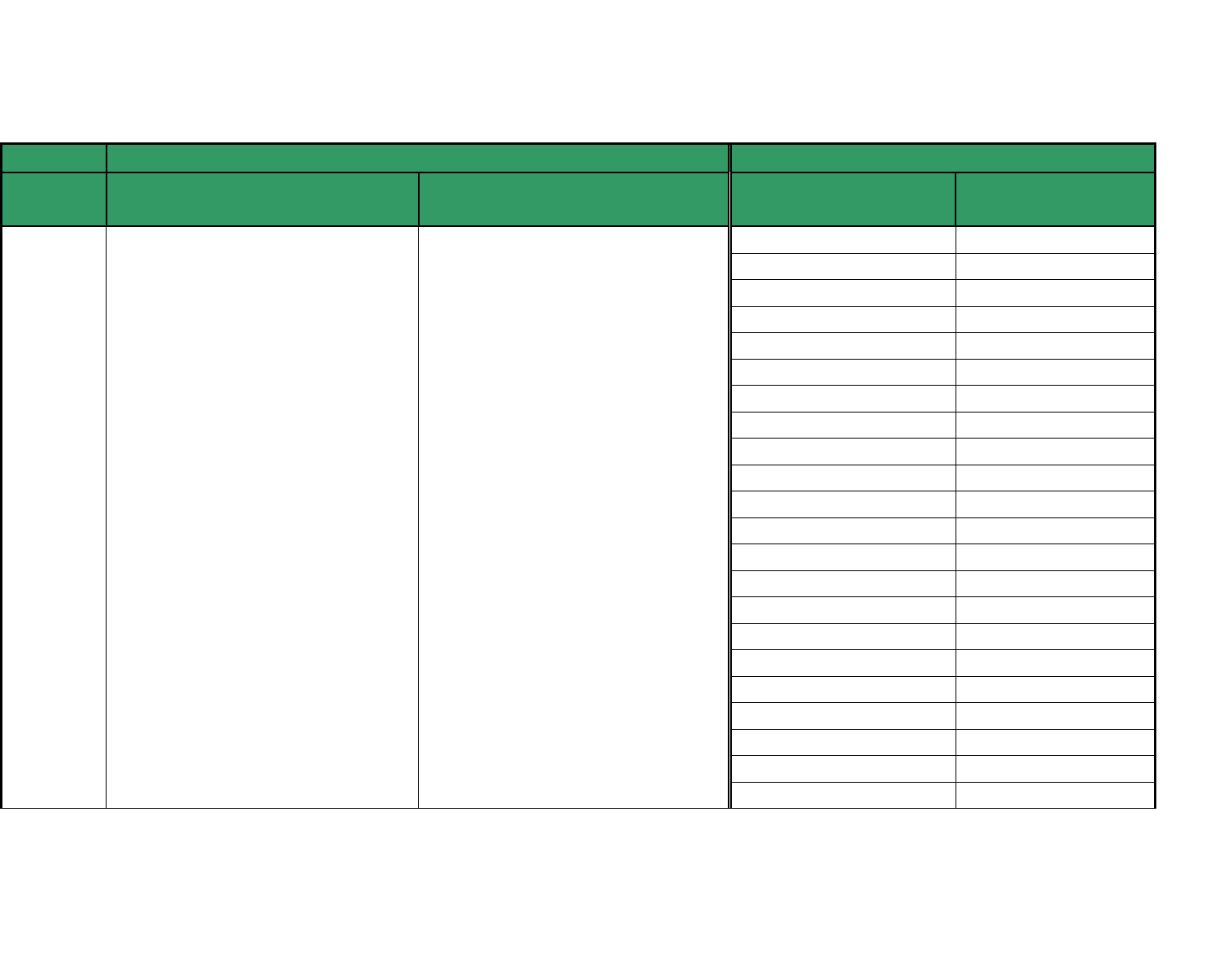
S/1319/2015
Annex 2
Appendix 6
page 146
Folders Files
Interview
Number
Original name Name translated to English Original name
Name translated to
English
IMG_7302 IMG_7302
IMG_7303 IMG_7303
IMG_7304 IMG_7304
IMG_7307 IMG_7307
IMG_7308 IMG_7308
IMG_7309 IMG_7309
IMG_7310 IMG_7310
IMG_7311 IMG_7311
IMG_7312 IMG_7312
IMG_7313 IMG_7313
IMG_7314 IMG_7314
IMG_7315 IMG_7315
IMG_7465 IMG_7465
IMG_7466 IMG_7466
IMG_7467 IMG_7467
IMG_7468 IMG_7468
IMG_7470 IMG_7470
IMG_7471 IMG_7471
IMG_7472 IMG_7472
IMG_7473 IMG_7473
IMG_7475 IMG_7475
IMG_7478 IMG_7478
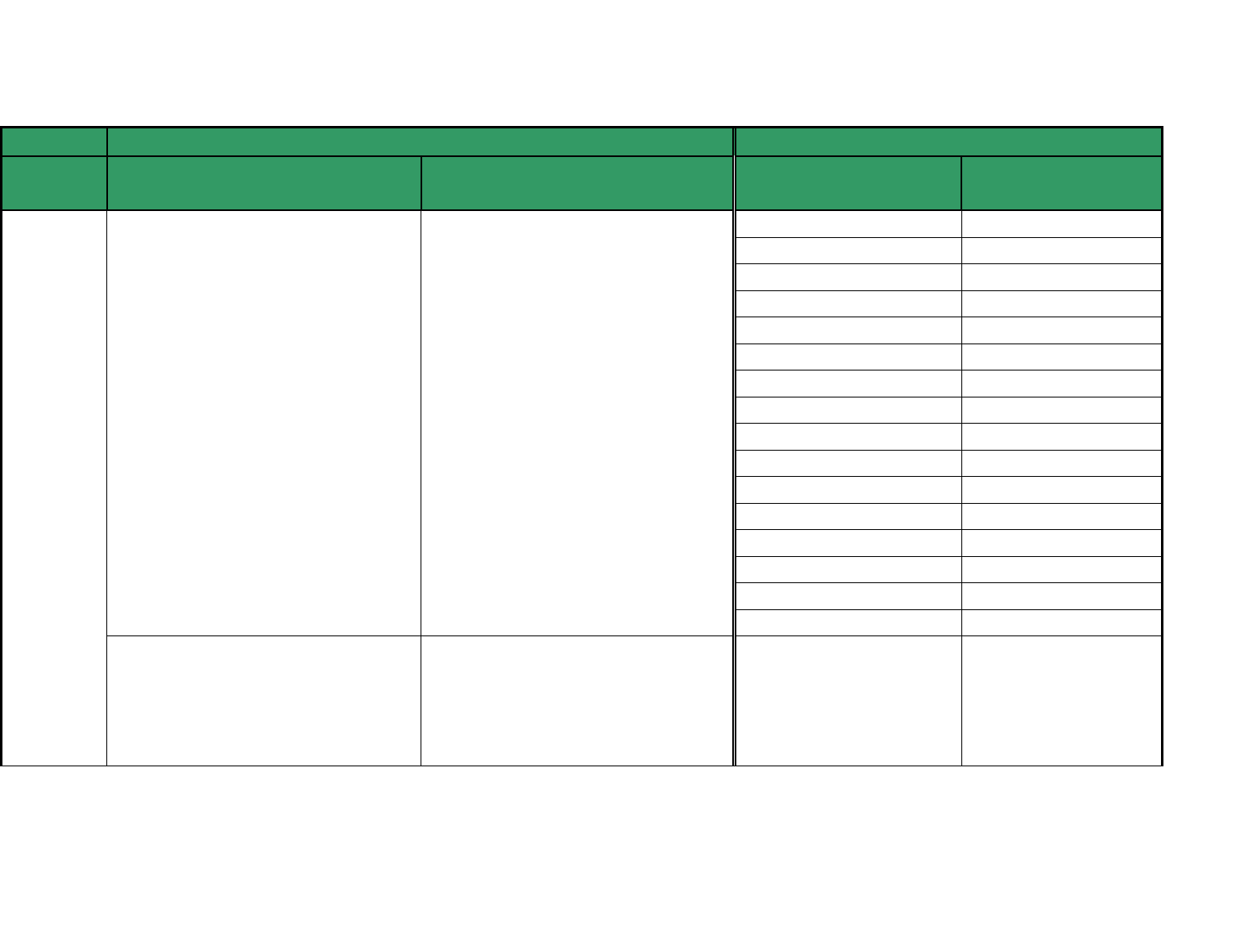
S/1319/2015
Annex 2
Appendix 6
page 147
Folders Files
Interview
Number
Original name Name translated to English Original name
Name translated to
English
IMG_7479 IMG_7479
IMG_7482 IMG_7482
IMG_7483 IMG_7483
IMG_7484 IMG_7484
IMG_7485 IMG_7485
IMG_7486 IMG_7486
MVI_7285 MVI_7285
MVI_7297 MVI_7297
MVI_7299 MVI_7299
MVI_7300 MVI_7300
MVI_7426 MVI_7426
MVI_7430 MVI_7430
MVI_7431 MVI_7431
MVI_7464 MVI_7464
MVI_7480 MVI_7480
MVI_7481 MVI_7481
Recovered Files 09_06_2015
20_20\Recovered data 06-09-2015 at
20_33_04\FAT32\Raw Files\JPEG
Graphics file
Recovered Files 09_06_2015
20_20\Recovered data 06-09-2015 at
20_33_04\FAT32\Raw Files\JPEG
Graphics file
Canon EOS 1100D000 Canon EOS 1100D000
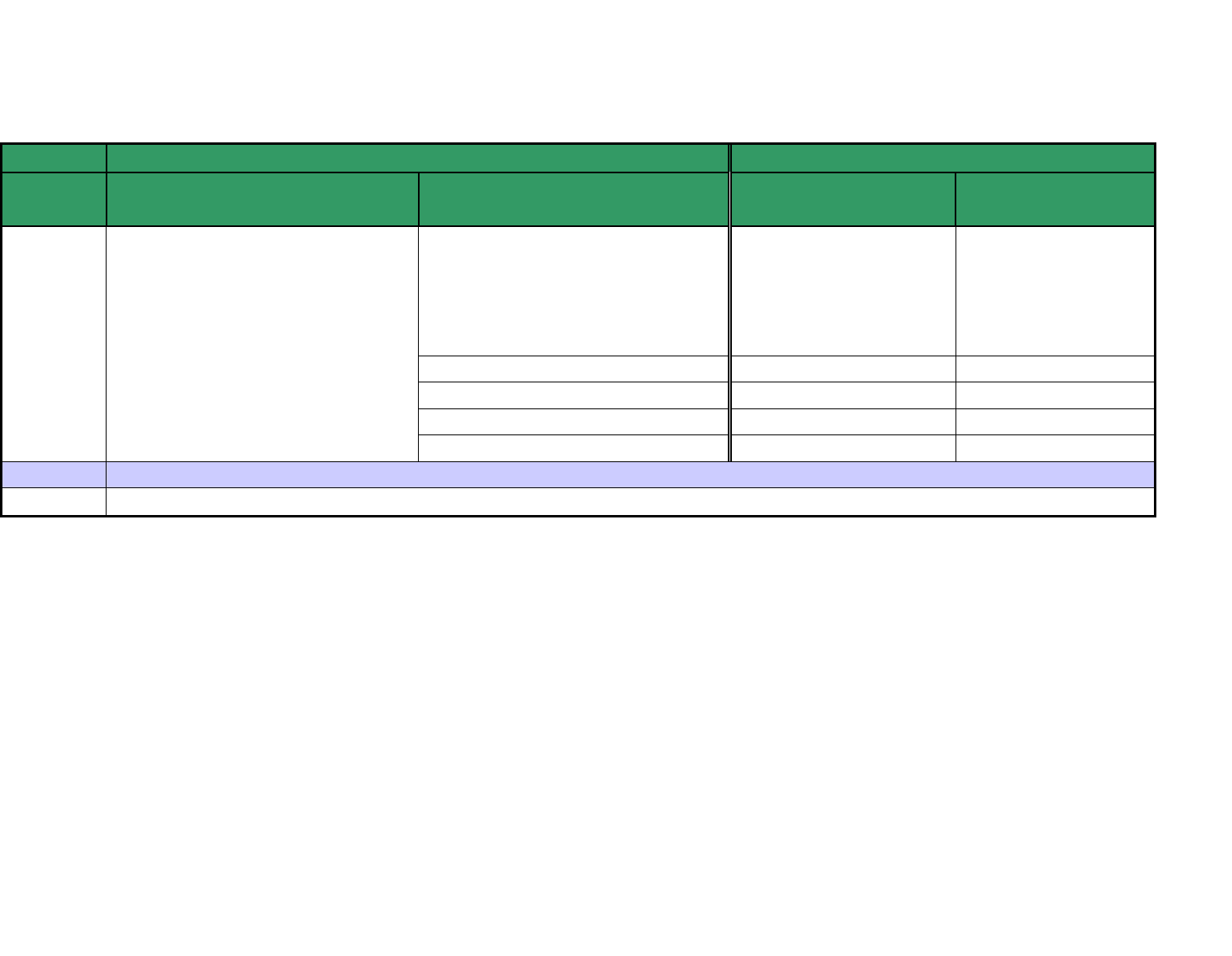
S/1319/2015
Annex 2
Appendix 6
page 148
Folders Files
Interview
Number
Original name Name translated to English Original name
Name translated to
English
Recovered Files 09_06_2015
20_20\Recovered data 06-09-2015 at
20_33_04\FAT32\Raw Files\MP4
Multimedia file
Recovered Files 09_06_2015
20_20\Recovered data 06-09-2015 at
20_33_04\FAT32\Raw Files\MP4
Multimedia file
FILE000 FILE000
FILE001 FILE001
FILE002 FILE002
FILE003 FILE003
FILE004 FILE004
1000 No electronic evidence was handed over to the team
1029 No electronic evidence was handed over to the team
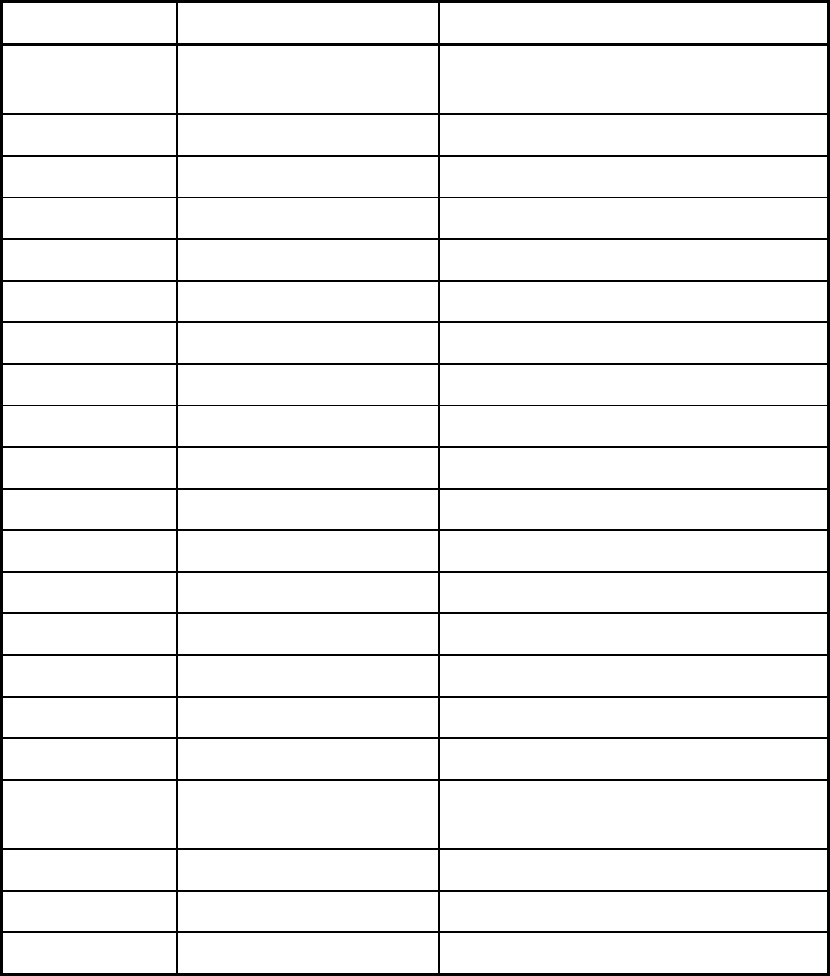
S/1319/2015
Annex 2
Appendix 7
page 149
Appendix 7
LOCATIONS IN ARABIC,
WITH EQUIVALENT SPELLING IN LATIN SCRIPT
Arabic English Alternative(s)
Al Janoudiyeh El Janoudiye/ Janoudiyeh/ Al
Janoudiya
Al Kastan El Kastane
Al Tamanah Al-Tamanaa
Mastume Al Mastoumi / Al-Mastumah
Al Nerab Al-Nayrab / Al-Nairab/ Al-Neirab
Ariha Arihah
Bashiriyeh Bachiriyeh/ Al-Bashiriyeh
Binnish Binich/ Benesh/ Benech
Damascus
Hama
Idlib Edleb/ Edlib
Jisr ash-shugur Jisr Al Shughour/ Jisr El Shoughour
Kafar Oueid Kafr Oueid
Kfar Zita Kafar Zita/ Kafr Zeita
Kafr Battikh Kafar Battikh/ Kafar Batikh
Kansafra Qansafra
Ma'arrat Misrin Maarat Misrin
Meshmshan Mechmchen/ Mechmchan/
Meshmshen
Qminas Qmenas
Saraqib Sarakeb/ Saraqeb/ Sarakib
Sarmin Sarmine/ Sarmeen
- - - o - - -
